Kyocera SCP-3820 Dual-Band CDMA Phone User Manual
Kyocera Corporation Dual-Band CDMA Phone Users Manual
Kyocera >
Users Manual
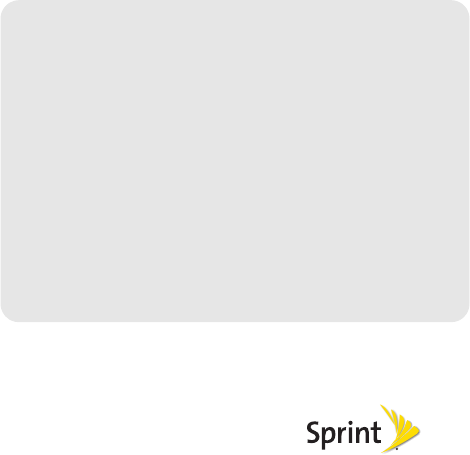
©2010 Sprint. SPRINT and the logo are trademarks of Sprint.
Other marks are the property of their respective owners.
“SANYO” is a registered trademark of SANYO Electric Co., Ltd.
and is used under license. KYOCERA is a registered
trademark of Kyocera Corporation. Kyocera manufactures
and markets the SANYO line of wireless products.
7/16/10
www.sprint.com
User Guide
SANYO Vero™ by KYOCERA

Sprint UG_10a_7/16/10
Consejo: Para encontrar esta guía para usuarios en español,
por favor visita a www.sprint.com y haz clic en
Support > Devices.
To find this user guide in Spanish, please visit
www.sprint.com and click Support > Devices.
Important Privacy Message – Sprint’s policies often do not
apply to third-party applications. Third-party applications may
access your personal information or require Sprint to disclose
your customer information to the third-party application
provider. To find out how a third-party application will collect,
access, use, or disclose your personal information, check the
application provider’s policies, which can usually be found on
their website. If you aren’t comfortable with the third-party
application’s policies, don’t use the application.

Table of Contents
Introduction . . . . . . . . . . . . . . . . . . . . . . . . . . . . . . . i
Your Phone’s Menu . . . . . . . . . . . . . . . . . . . . . . . . i
Section 1: Getting Started . . . . . . . . . . . . . . . . . 1
1A. Setting Up Service . . . . . . . . . . . . . . . . . . . 2
Setting Up Your Phone . . . . . . . . . . . . . . . . . . . . . . 2
Activating Your Phone . . . . . . . . . . . . . . . . . . . . . . . 3
Setting Up Your Voicemail . . . . . . . . . . . . . . . . . . . 4
Sprint Account Passwords . . . . . . . . . . . . . . . . . . . 4
Getting Help . . . . . . . . . . . . . . . . . . . . . . . . . . . . . . . 5
Section 2: Your Phone . . . . . . . . . . . . . . . . . . . . 7
2A. Phone Basics . . . . . . . . . . . . . . . . . . . . . . . . 8
Your Phone . . . . . . . . . . . . . . . . . . . . . . . . . . . . . . . . 8
Viewing the Display Screen . . . . . . . . . . . . . . . . . 10
Turning Your Phone On and Off . . . . . . . . . . . . . 13
Battery and Charger . . . . . . . . . . . . . . . . . . . . . . . 13
Navigating Through the Menus . . . . . . . . . . . . . . 15
Displaying Your Phone Number . . . . . . . . . . . . . 16
Making and Answering Calls . . . . . . . . . . . . . . . 16
Entering Text . . . . . . . . . . . . . . . . . . . . . . . . . . . . . . 23
Simple Data Exchange . . . . . . . . . . . . . . . . . . . . 26
2B. Settings . . . . . . . . . . . . . . . . . . . . . . . . . . . . 28
Display Settings . . . . . . . . . . . . . . . . . . . . . . . . . . . 28
Volume Settings . . . . . . . . . . . . . . . . . . . . . . . . . . 31
Ringer Settings . . . . . . . . . . . . . . . . . . . . . . . . . . . 32
Messaging Settings . . . . . . . . . . . . . . . . . . . . . . . 34
Airplane Mode . . . . . . . . . . . . . . . . . . . . . . . . . . . . 36
TTY Use With Sprint Service . . . . . . . . . . . . . . . . 36
Using the Hearing Aid Device Compatibility
Function . . . . . . . . . . . . . . . . . . . . . . . . . . . . . . . . . 38
Phone Setup Options . . . . . . . . . . . . . . . . . . . . . . 38
Security Settings . . . . . . . . . . . . . . . . . . . . . . . . . . 40
2C. History . . . . . . . . . . . . . . . . . . . . . . . . . . . . . 45
Viewing History . . . . . . . . . . . . . . . . . . . . . . . . . . . 45
History Thread . . . . . . . . . . . . . . . . . . . . . . . . . . . . 46
History Details . . . . . . . . . . . . . . . . . . . . . . . . . . . . 46
History Options . . . . . . . . . . . . . . . . . . . . . . . . . . . 46
Making a Call From History . . . . . . . . . . . . . . . . . 47
Saving a Number From History . . . . . . . . . . . . . 47
Tip: Looking for something? If you don’t see it in the headings
listed here, try the Index on page 126.
Making a New Group Entry From History . . . . . 47
Deleting History . . . . . . . . . . . . . . . . . . . . . . . . . . . 48
2D. Contacts . . . . . . . . . . . . . . . . . . . . . . . . . . . 49
About Contacts . . . . . . . . . . . . . . . . . . . . . . . . . . . 49
Displaying Contacts Entries . . . . . . . . . . . . . . . . 49
Adding a New Contacts Entry . . . . . . . . . . . . . . 50
Editing a Contacts Entry . . . . . . . . . . . . . . . . . . . 50
Adding a Number to a Contacts Entry . . . . . . . . 51
Creating a Group . . . . . . . . . . . . . . . . . . . . . . . . . . 51
Editing Groups . . . . . . . . . . . . . . . . . . . . . . . . . . . . 51
Finding Contacts Entries . . . . . . . . . . . . . . . . . . . . 52
Using Contacts Information in Other
Applications . . . . . . . . . . . . . . . . . . . . . . . . . . . . . . 53
Assigning Speed Dial Numbers . . . . . . . . . . . . 53
Selecting a Ringer Type for an Entry . . . . . . . . 54
Assigning a Picture to an Entry . . . . . . . . . . . . . 54
Secret Contacts Entries . . . . . . . . . . . . . . . . . . . . 55
My Name Card . . . . . . . . . . . . . . . . . . . . . . . . . . . 55
Dialing Sprint Services . . . . . . . . . . . . . . . . . . . . 56
2E. Calendar & Tools . . . . . . . . . . . . . . . . . . . . 57
Calendar . . . . . . . . . . . . . . . . . . . . . . . . . . . . . . . . . 57
Alarm . . . . . . . . . . . . . . . . . . . . . . . . . . . . . . . . . . . 60
Calculator . . . . . . . . . . . . . . . . . . . . . . . . . . . . . . . . 61
World Clock . . . . . . . . . . . . . . . . . . . . . . . . . . . . . . 61
Countdown Timer . . . . . . . . . . . . . . . . . . . . . . . . . 61
Stopwatch . . . . . . . . . . . . . . . . . . . . . . . . . . . . . . . . 62
2F. Voice Services . . . . . . . . . . . . . . . . . . . . . 63
Automatic Speech Recognition (ASR) . . . . . . . . 63
Managing Voice Memos . . . . . . . . . . . . . . . . . . . 66
2G. Camera . . . . . . . . . . . . . . . . . . . . . . . . . . . . 68
Taking Pictures . . . . . . . . . . . . . . . . . . . . . . . . . . . . 68
Storing Pictures . . . . . . . . . . . . . . . . . . . . . . . . . . . 72
Sending Pictures From Your Phone . . . . . . . . . . 73
Printing Pictures From Your Phone . . . . . . . . . . . 74
2H. Bluetooth . . . . . . . . . . . . . . . . . . . . . . . . . . . 76
About Bluetooth . . . . . . . . . . . . . . . . . . . . . . . . . . . 76
Turning Bluetooth On and Off . . . . . . . . . . . . . . . 76
Making Your Phone Discoverable . . . . . . . . . . . 76
Bluetooth Menu . . . . . . . . . . . . . . . . . . . . . . . . . . . 77
Pairing Bluetooth Devices . . . . . . . . . . . . . . . . . . 78
Viewing the Trusted Devices List . . . . . . . . . . . . . 78
Sending Data via Bluetooth . . . . . . . . . . . . . . . . . 79
Printing Pictures via Bluetooth . . . . . . . . . . . . . . . 80
Section 3: Sprint Service. . . . . . . . . . . . . . . . . 83
3A. Sprint Service: The Basics . . . . . . . . . . . 84
Voicemail . . . . . . . . . . . . . . . . . . . . . . . . . . . . . . . . . 84
Messaging . . . . . . . . . . . . . . . . . . . . . . . . . . . . . . . 86
Caller ID . . . . . . . . . . . . . . . . . . . . . . . . . . . . . . . . . . 89
Call Waiting . . . . . . . . . . . . . . . . . . . . . . . . . . . . . . . 90
Making a 3-Way Call . . . . . . . . . . . . . . . . . . . . . . . 90
Call Forwarding . . . . . . . . . . . . . . . . . . . . . . . . . . . 91
Roaming . . . . . . . . . . . . . . . . . . . . . . . . . . . . . . . . . 91
3B. Web and Data Services . . . . . . . . . . . . . . 94
Getting Started With Data Services . . . . . . . . . . 94
Accessing Messages . . . . . . . . . . . . . . . . . . . . . . 97
Downloading Games, Ringers, and More . . . . . 99
Applications . . . . . . . . . . . . . . . . . . . . . . . . . . . . . 101
Browser Menu . . . . . . . . . . . . . . . . . . . . . . . . . . . 102
Data Services FAQs . . . . . . . . . . . . . . . . . . . . . . . 105
3C. GPS Navigation . . . . . . . . . . . . . . . . . . . . 106
GPS Services . . . . . . . . . . . . . . . . . . . . . . . . . . . . 106
Sprint Family Locator . . . . . . . . . . . . . . . . . . . . . 107
Section 4: Safety and Warranty
Information . . . . . . . . . . . . . . . . . . . . . . . . . . . . 109
4A. Important Safety Information . . . . . . . . 110
General Precautions . . . . . . . . . . . . . . . . . . . . . . 110
Maintaining Safe Use of and Access to Your
Phone . . . . . . . . . . . . . . . . . . . . . . . . . . . . . . . . . . . 111
Using Your Phone With a Hearing Aid
Device . . . . . . . . . . . . . . . . . . . . . . . . . . . . . . . . . . 112
Caring for the Battery . . . . . . . . . . . . . . . . . . . . . 114
Radio Frequency (RF) Energy . . . . . . . . . . . . . 115
Owner’s Record . . . . . . . . . . . . . . . . . . . . . . . . . . 117
User Guide Proprietary Notice . . . . . . . . . . . . . 117
4B. Manufacturer’s Warranty . . . . . . . . . . . . 118
Manufacturer’s Warranty . . . . . . . . . . . . . . . . . . 118
4C. End User License Agreement . . . . . . . 121
End User License Agreement . . . . . . . . . . . . . . 121
Index. . . . . . . . . . . . . . . . . . . . . . . . . . . . . . . . . . . 126
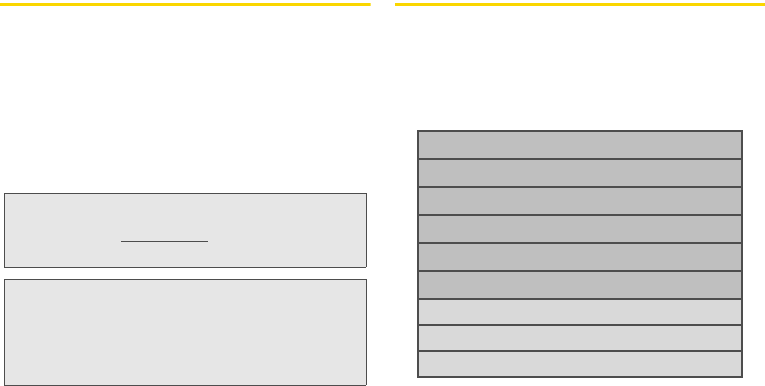
i
Introduction
This User Guide introduces you to Sprint® service and
all the features of your new phone. It’s divided into four
sections:
ࡗSection 1: Getting Started
ࡗSection 2: Your Phone
ࡗSection 3: Sprint Service
ࡗSection 4: Safety and Warranty Information
Your Phone’s Menu
The following table outlines your phone’s main menu
structure. For more information about using your
phone’s menus, see “Navigating Through the Menus”
on page 15.
Note: Because of updates in phone software, this printed
guide may not be the most current version for your
phone. Visit www.sprint.com and sign on to My Sprint
to access the most recent version of the user guide.
WARNING: Please refer to the Important Safety Information
section on page 110 to learn about information
that will help you safely use your phone. Failure to
read and follow the Important Safety Information
in this phone guide may result in serious bodily
injury, death, or property damage.
Web
Contacts
Sprint Family Locator
History
Missed Alerts
Messaging
1: Voicemail
2: Send Message
3: Messages

ii
Photos
1: Camera
Press the right softkey to view the following options:
1: Picture Mode 2: Zoom
3: Self-Timer 4: Fun Tools
5: Image Controls 6: CameraSettings
7: Review Media 8: Key Guidance
9: User Settings
2: My Photos
3: Other Settings
1: Location 2: Status Bar
3: Slideshow Interval 4: Help
My Stuff
1: Application Manager
2: Games
3: Ringers
4: Screen Savers
5: Applications
6: IM & Email
7: Call Tones
My Account
1: Account Details
2: Hear Minutes
3: Hear Balance
Settings
1: Display
1: Screensaver 2: Brightness
3: Backlight 4: Notification
5: Picture ID 6: Power Save Mode
7: Clock/Calendar 8: Greeting
2: Volume
1: Incoming Ringer 2: Playback Volume
3: Power Up/Down 4: Key Beeps
3: Ringers
1: Incoming Calls 2: Voicemail
3: Messages 4: Calendar
5: Power Up/Down
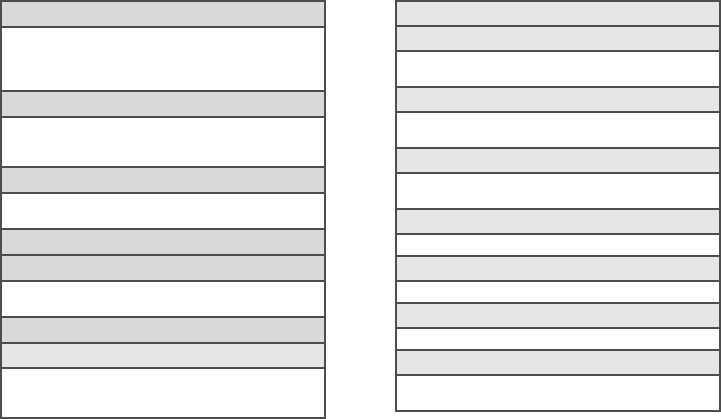
iii
4: Text Entry
1: Word Complete 2: Next Word Complete
3: Phrase Complete 4: Word Scan
5: Word Choice List 6: Input Language
7: My Words 8: Help
5: Phone Info
1: Phone#/User ID 2: Memory Status
3: Icon Glossary 4: Version
5: Advanced 6: My Account
6: Lock Phone
1: Lock Now 2: Change Lock Code
3: Lock Code Hint
7: Parental Controls
8: Reset/Delete
1: Reset Settings 2: Reset Phone
3: Delete Stuff 4: Change Lock Code
9: Others
1: Accessibility
1: Voice Services 2: TTY
3: Font Size 4: Vibrate Type
5: Hearing Aid
2: Airplane Mode
3: Alerts
1: Beep Each Minute 2: Out of Service
3: Connect
4: Call Setup
1: Abbrev. Dial 2: Call Answer
3: Auto-Answer
5: Data
1: Data On/Data Off 2: Net Guard
3: Update Data Profile
6: Headset Mode
1: Normal 2: Headset Only
7: Language
1: English 2: Español
8: Location
1: On/Off 2: NMEA Output
9: Roaming
1: Set Mode 2: Call Guard
3: Data Roam Guard

iv
0: Navigation Keys
1: Left Navigation 2: Right Navigation
(Calendar) (Web)
3: Up Navigation 4: Down Navigation
(Send Message) (My Stuff)
Tools
1: Device Self Service
2: Alarm
3: Calendar
4: Bluetooth
1: On/Off 2: Visibility
3: Add New 4: Trusted Devices
5: My Bluetooth Info
5: Update Phone
1: Software Version 2: PRL Version
6: Voice Services
1: Voice Recognition 2: Voice Memo
7: Assigned Media
8: Calculator
9: Countdown
0: Stopwatch
*: World Clock
Shopping
In Use Menu
Press OPTIONS (right softkey) to display the following
options:
1: Save/Contact Details 2: Main Menu
3: 3-Way Call 4: Contacts
5: Voice Memo 6: Phone Info
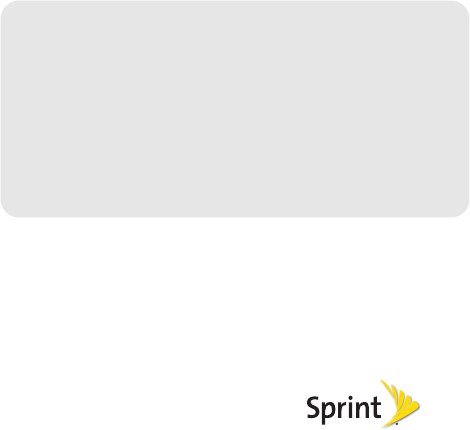
Section 1
Getting Started
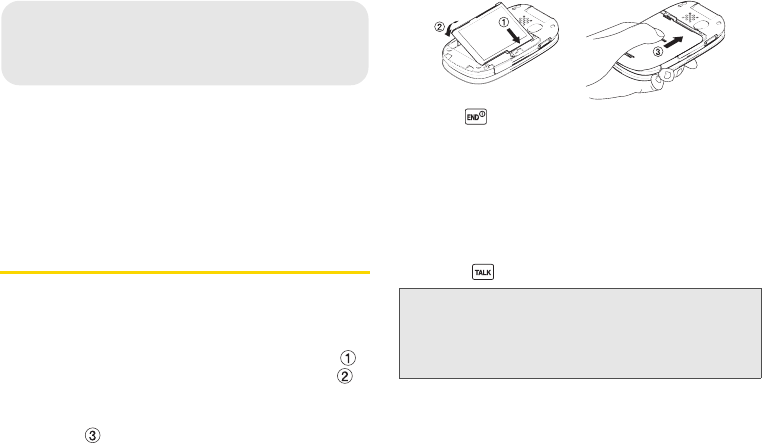
2 1A. Setting Up Service
ࡗSetting Up Your Phone (page 2)
ࡗActivating Your Phone (page 3)
ࡗSetting Up Your Voicemail (page 4)
ࡗSprint Account Passwords (page 4)
ࡗGetting Help (page 5)
Setting Up Your Phone
1. Install the battery.
ⅢRemove the battery from its packaging.
ⅢInsert the battery into the opening in the back of
the phone, making sure the connectors align ( ),
and gently press down to secure the battery ( ).
ⅢPosition the battery cover over the battery
compartment and slide it up until it clicks into
place ( ).
2. Press to turn the phone on.
ⅢIf your phone is activated, it will turn on, search for
Sprint service, and enter standby mode.
ⅢIf your phone is not yet activated, see “Activating
Your Phone” on page 3 for more information.
3. Make your first call.
ⅢUse your keypad to enter a phone number.
ⅢPress .
1A. Setting Up Service
Note: Your phone’s battery should have enough charge for
your phone to turn on and find a signal, set up your
voicemail, and make a call. You should fully charge
your battery as soon as possible. See “Charging the
Battery” on page 15 for details.
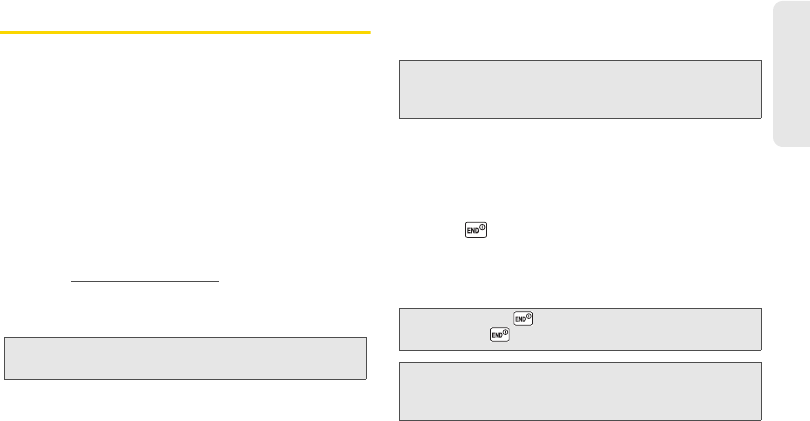
1A. Setting Up Service 3
Setting Up Service
Activating Your Phone
ⅷIf you purchased your phone at a Sprint Store, it is
probably activated and ready to use.
ⅷIf you received your phone in the mail and it is for a new
Sprint account or a new line of service, it is designed to
activate automatically. To confirm your activation,
make a phone call.
ⅷIf you received your phone in the mail and it is going to
be activated on an existing number on your account
(you’re swapping phones), you can activate on your
computer online or directly on your phone.
Activate on your computer:
ᮣGo to www.sprint.com/activate and follow the
instructions.
Activate on your phone:
1. Turn on your new phone. (Make sure the old one is
turned off.) Your phone will attempt Hands-Free
Activation automatically.
2. Press ACTIVATE (left softkey) to override
auto-activation and start the manual activation
wizard.
3. Use your navigation key, your keypad, or both to
complete each screen of the wizard, and press
NEXT (left softkey) to advance through the screens.
4. Continue until you get to a confirmation screen
telling you that your phone is now active, and then
press to return to your phone’s main menu.
When you have finished, make a phone call to confirm
your activation. If your phone is still not activated, contact
Sprint Customer Service at 1-888-211-4727 for assistance.
Note: You will need your Sprint PIN to use this activation
method.
Note: If you don’t override Hands-Free Activation, your phone
will attempt to auto-activate five times, and then the
manual activation wizard will start automatically.
Tip: Do not press while the phone is being activated.
Pressing cancels the activation process.
Note: If you are having difficulty with activation, contact Sprint
Customer Service by dialing 1-888-211-4727 from any
other phone.

4 1A. Setting Up Service
Setting Up Your Voicemail
Your phone automatically transfers all unanswered
calls to your voicemail, even if your phone is in use or
turned off. You should set up your Sprint Voicemail and
personal greeting as soon as your phone is activated.
Always use a password to protect against unauthorized
access.
1. From standby mode, press and hold .
2. Follow the system prompts to:
ⅢCreate your password.
ⅢRecord your name announcement.
ⅢRecord your greeting.
For more information about using your voicemail, see
“Voicemail” on page 84.
Sprint Account Passwords
As a Sprint customer, you enjoy unlimited access to
your personal account information, your voicemail
account, and your data services account. To ensure
that no one else has access to your information, you
will need to create passwords to protect your privacy.
Account User Name and Password
If you are the account owner, you will create an account
user name and password when you sign on to
www.sprint.com. (Click Need to register for access? to get
started.) If you are not the account owner (if someone
else receives the bill for your Sprint service), you can
get a sub-account password at www.sprint.com.
Voicemail Password
You will create your voicemail password when you set
up your voicemail. See “Setting Up Your Voicemail” on
this page for more information on your voicemail
password.
Note: Voicemail Password
Sprint strongly recommends that you create a
password when setting up your voicemail to protect
against unauthorized access. Without a password,
anyone who has access to your phone is able to
access your voicemail messages.

1A. Setting Up Service 5
Setting Up Service
Data Services Password
With your Sprint phone, you may elect to set up an
optional data services password to control data (Web)
access and authorize Premium Service purchases.
For more information, or to change your passwords,
sign on to www.sprint.com or call Sprint Customer
Service at 1-888-211-4727.
Getting Help
Managing Your Account
Online: www.sprint.com
ⅷAccess your account information.
ⅷCheck your minutes used (depending on your Sprint
service plan).
ⅷView and pay your bill.
ⅷEnroll in Sprint online billing and automatic payment.
ⅷPurchase accessories.
ⅷShop for the latest Sprint phones.
ⅷView available Sprint service plans and options.
ⅷLearn more about data services and other products
like games, ringers, screen savers, and more.
From Your Sprint Phone
ⅷPress to check minute usage and
account balance.
ⅷPress to make a payment.
ⅷPress to access a summary of your
Sprint service plan or get answers to other questions.
From Any Other Phone
ⅷSprint Customer Service: 1-888-211-4727.
ⅷBusiness Customer Service: 1-800-927-2199.
Sprint 411
Sprint 411 gives you access to a variety of services and
information through your phone, including residential,
business, and government listings; movie listings or
showtimes; driving directions, restaurant reservations,
and major local event information. You can get up to
three pieces of information per call, and the operator
can automatically connect your call at no additional
charge.
There is a per-call charge to use Sprint 411, and you
will be billed for airtime.
ᮣPress .

6 1A. Setting Up Service
Sprint Operator Services
Sprint Operator Services provides assistance when
placing collect calls or when placing calls billed to a
local telephone calling card or third party.
ᮣPress .
For more information or to see the latest in products
and services, visit us online at www.sprint.com.
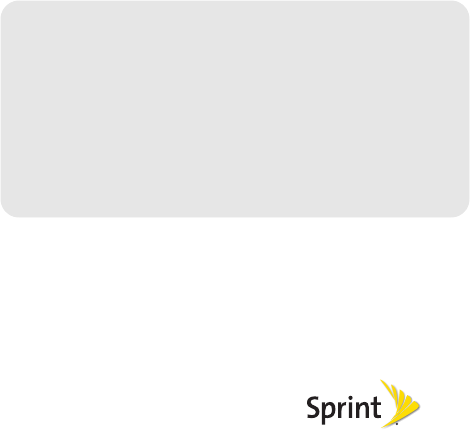
Section 2
Your Phone
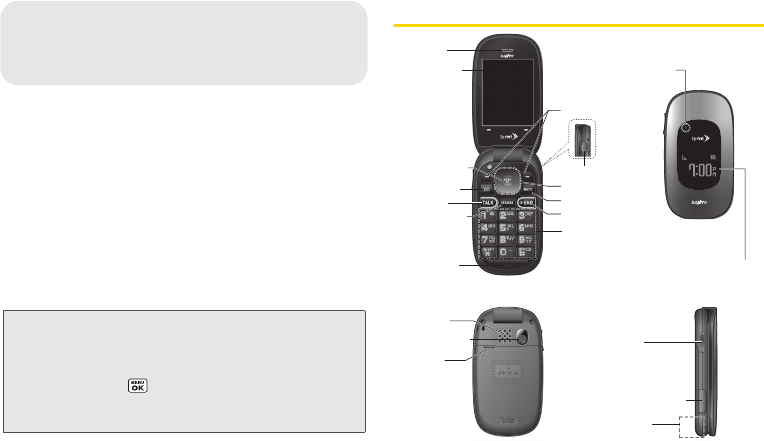
8 2A. Phone Basics
ࡗYour Phone (page 8)
ࡗViewing the Display Screen (page 10)
ࡗTurning Your Phone On and Off (page 13)
ࡗBattery and Charger (page 13)
ࡗNavigating Through the Menus (page 15)
ࡗDisplaying Your Phone Number (page 16)
ࡗMaking and Answering Calls (page 16)
ࡗEntering Text (page 23)
ࡗSimple Data Exchange (page 26)
Your Phone
Tip: Phone Software Upgrades – Updates to your phone’s
software may become available from time to time. Sprint
will automatically upload critical updates to your phone.
You can also use the menu to check for and download
updates. Press > Tools > Update Phone >
Software Version to search for and download available
updates.
2A. Phone Basics
1. Earpiece
2. Main Screen
13. Softkeys
3. MENU/OK Key
11. Navigation Key
4. Camera Key
10. BACK Key
5. TALK Key
9. END/POWER Key
8. Keypad
7. Microphone
19. Volume Button
20. Charger/Accessory Jack
15. Outer Screen
14. LED Indicator
16. Speaker
17. Camera Lens
18. Battery
Release Tab
12. Headset Jack
21. Internal Antenna
6. SPEAKER Key

2A. Phone Basics 9
Phone Basics
Key Functions
1. Earpiece lets you hear the caller and automated
prompts.
2. Main Screen displays all the information needed to
operate your phone, such as the call status, the
Contacts list, the date and time, and the signal and
battery strength.
3. MENU/OK Key lets you access the phone’s menus
and select the highlighted choice when navigating
through a menu.
4. Camera Key lets you access the Photos menu.
Press and hold to activate the camera mode and
take pictures.
5. TALK Key allows you to place or receive calls,
answer Call Waiting, use 3-Way Calling, or activate
Automatic Speech Recognition (ASR).
6. SPEAKER Key lets you place or receive voice calls,
activate ASR in speakerphone mode, and turn the
speakerphone on or off during a call.
7. Microphone allows other callers to hear you clearly
when you are speaking to them.
8. Keypad lets you enter numbers, letters, and
characters and navigate within menus. You can
use the numeric keypad for speed dialing (see
“Speed Dialing” on page 22).
9. END/POWER Key lets you turn the phone on or off,
end a call, or cancel your input and return to idle
mode (standby mode or service search mode).
10. BACK Key deletes characters from the display in text
input mode. When in a menu, pressing it returns
you to the previous menu. This key also allows you
to return to the previous screen in a data session.
11. Navigation Key scrolls through the phone’s menu
options and acts as a shortcut key from standby
mode. These keys can be reassigned to create
customized shortcuts. See “Navigation Key
Shortcuts” on page 38.
12. Headset Jack allows you to plug in an optional
headset for convenient, hands-free conversations.
CAUTION! Inserting an accessory into the incorrect
jack may damage the phone.
13. Softkeys let you select softkey actions or menu
items corresponding to the bottom left and right
lines on the main screen.
14. LED Indicator shows the status of your phone and
charging at a glance.
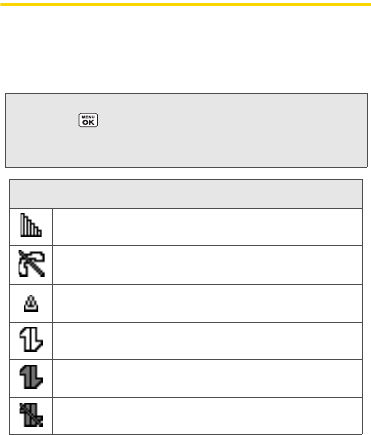
10 2A. Phone Basics
15. Outer Screen lets you monitor the phone’s status
and see who is calling without opening the phone.
16. Speaker lets you hear the different ringers and
sounds. The speaker also lets you hear the caller’s
voice in speakerphone mode.
17. Camera Lens, as part of the built-in camera, lets
you take pictures.
18. Battery Release Tab lets you open the battery cover
to replace the battery.
19. Volume Button allows you to adjust the ringer
volume whenever your phone is turned on or
adjust the voice volume during a call.
20. Charger/Accessory Jack allows you to connect a
compatible charging cable or USB data cable (not
included). CAUTION! Inserting an accessory into
the incorrect jack may damage the phone.
21. Internal Antenna facilitates reception and
transmission. To maximize performance, do not
touch the bottom portion of your phone where the
internal antenna is located while using the phone.
Viewing the Display Screen
The status bar at the top of your phone’s display screen
provides information about your phone’s status and options.
These tables identify the major symbols you’ll see on the
status bar or other positions of your phone’s display screen.
Tip: To view a list of your phone’s icons and descriptions,
press > Settings > Phone Info > Icon Glossary.
For the camera function icons, see “Camera Icons” on
page 72.
Service Icons
Signal Strength – Your phone’s current signal
strength. (More bars = stronger signal.)
No Service – Your phone cannot find a usable
signal.
Roaming – Your phone is “roaming” off the
Nationwide Sprint Network.
Data Service – Sprint 1xRTT data service is
available. When active, the icon is animated.
Data Service Dormant – Data service is currently
dormant.
Data Service Unavailable – Data service is
currently unavailable.
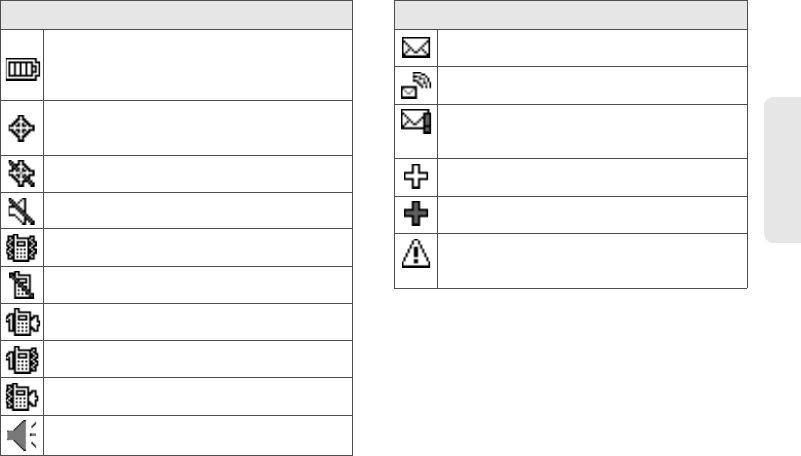
2A. Phone Basics 11
Phone Basics
Status Icons
Battery – Your phone’s current battery charge
level. (The icon to the left shows the battery is
fully charged.) The icon is animated while the
battery is charging.
Location On – Your phone’s location feature is
on and available for location-based services
such as GPS Navigation.
Location Off – Your phone’s location feature is
off. Your location is available only for 911.
Silence All – Your phone’s sound is turned off.
Vibrate All – Your phone’s sound is turned off
but vibrate is turned on.
Ringer Off – Your phone’s ringer is turned off.
1 Beep – A beep sounds when you receive an
incoming call, a message, etc.
1 Beep and Vibrate – 1 Beep and vibrate are set.
Ringer and Vibrate – The volume level is set to
between 1 and 8 and vibrate is turned on.
Speaker Mode – Your phone is in speaker
mode.
Messaging and Alert Icons
New Messages – You have one or more new
messages waiting.
New Voicemail – You have one or more new
voicemail messages waiting.
Urgent Messages – You have one or more new
urgent messages (including Commercial Mobile
Alert System [CMAS] alert message) waiting.
Multiple Alerts - You have different kinds of alerts
waiting.
Urgent Multiple Alerts - You have different kinds
of alerts (including urgent message) waiting.
Application Alerts - You have alert messages
from Java applications activated in the
background.
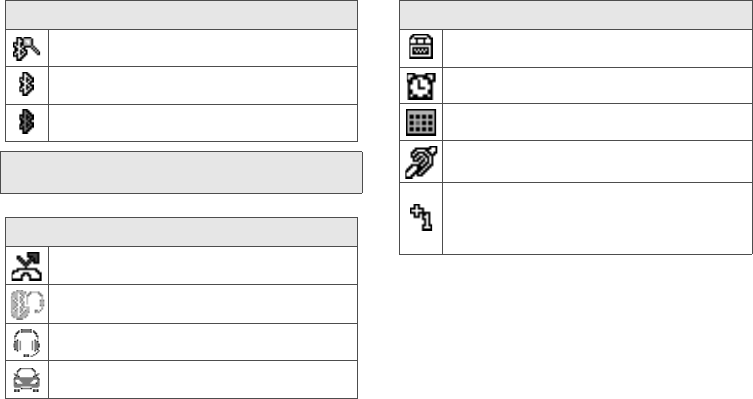
12 2A. Phone Basics
Bluetooth Icons
Visible – Your phone is discoverable by (visible
to) other Bluetooth devices.
Connected – Your phone is connected to a
Bluetooth device.
Enabled – Your phone’s Bluetooth feature is
enabled.
Tip: The above icons will blink while your phone is
communicating with a Bluetooth device.
Voice Call Icons
Missed Call – You have one or more missed
voice calls.
Bluetooth Device – A call is in progress using a
Bluetooth device.
Headset – A call is in progress using an optional
wired headset.
Car Kit – A call is in progress using an optional
car kit device.
Other Icons
TTY – Your phone is connected to a TTY device.
Alarm – An alarm or countdown is set.
Notification – You have event notifications.
HAC Enabled – Your phone’s HAC (hearing aid
compatibility) setting is enabled.
Multitasking Virtual Machine – Indicates Java
applications are running. The number next to
the plus sign indicates the number of running
applications.
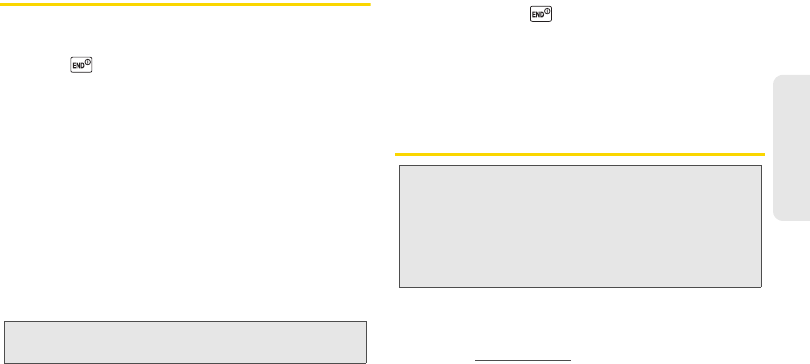
2A. Phone Basics 13
Phone Basics
Turning Your Phone On and Off
Turning Your Phone On
ᮣPress .
Once your phone is on and finds a signal, it
automatically enters standby mode – the phone’s idle
state. At this point, you are ready to begin making and
receiving calls.
If your phone is unable to find a signal after five
minutes of searching, a Power Save feature is
automatically activated. When a signal is found, your
phone automatically returns to standby mode.
In Power Save mode, your phone searches for a signal
periodically without your intervention. You can also
initiate a search for Sprint service by pressing any key
except numbered keys.
Turning Your Phone Off
ᮣPress and hold for two seconds until you see
the powering-down animation on the display
screen.
Your screen remains blank while your phone is off
unless the battery is charging.
Battery and Charger
Sprint-approved or Kyocera-approved batteries and
accessories can be found at Sprint Stores or through
Kyocera; or call 1-866-866-7509 to order. They’re also
available at www.sprint.com.
Tip: The Power Save feature conserves your battery power
when you are in an area where there is no signal.
WARNING: Use only Sprint-approved or Kyocera-approved
batteries and chargers with your phone. The
failure to use a Sprint-approved or Kyocera-
approved battery and charger may increase the
risk that your phone will overheat, catch fire, or
explode, resulting in serious bodily injury, death,
or property damage.

14 2A. Phone Basics
Battery Capacity
Your phone is equipped with a Lithium Ion (Li-Ion)
battery. It allows you to recharge your battery before it is
fully drained. The battery provides up to X.X hours of
continuous digital talk time.
For a quick check of your battery level, glance at the
battery charge indicator located in the upper right
corner of your phone’s display screen. When there are
approximately five minutes of talk time left, the battery
icon ( ) turns red and the phone sounds a warning
tone.
After an additional five minutes or so, the phone
sounds a warning tone three times and then turns off.
Installing the Battery
ᮣSee “Setting Up Your Phone” on page 2.
Removing the Battery
1. Make sure the power is off so that you don’t lose
any stored numbers or messages.
2. Press the release tab, and apply light pressure
while sliding the cover down.
3. Lift the battery up and remove it from the phone.
Note: Long backlight settings, searching for service, vibrate
mode, browser use, and other variables may reduce
the battery’s talk and standby times.
Tip: Watch your phone’s battery level indicator and charge the
battery before it runs out of power.
WARNING: Do not handle a damaged or leaking Li-Ion
battery as you can be burned.

2A. Phone Basics 15
Phone Basics
Charging the Battery
Keeping track of your battery’s charge is important.
If your battery level becomes too low, your phone
automatically turns off, and you will lose any
information you were just working on.
Always use a Sprint-approved or Kyocera-approved
desktop charger, travel charger, or vehicle power
adapter to charge your battery.
1. Plug the phone charger into an electrical outlet.
2. Plug the other end of the phone charger into the
charger/accessory jack located on the lower left
side of your phone.
With the Sprint-approved Li-Ion battery, you can
recharge the battery before it becomes completely run
down.
Navigating Through the Menus
The navigation key on your phone lets you scroll
through menus quickly and easily. Many menus feature
a scroll bar on the right to help you keep track of your
position in the menu.
To navigate through a menu, press the navigation key
up or down.
For a diagram of your phone’s menu, please see “Your
Phone’s Menu” on page i.
Selecting Menu Items
As you navigate through the menu, menu options are
highlighted. Select any option by highlighting it and
pressing . If the option is numbered, you can select
it by pressing the corresponding number on the
phone’s keypad.
For example, to open the alarm setting screen:
1. Press to access the main menu.
2. Select Tools by highlighting it and pressing .
3. Select Alarm by highlighting it and pressing .
For the purposes of this guide, the above steps
condense into:
ᮣPress > Tools > Alarm.
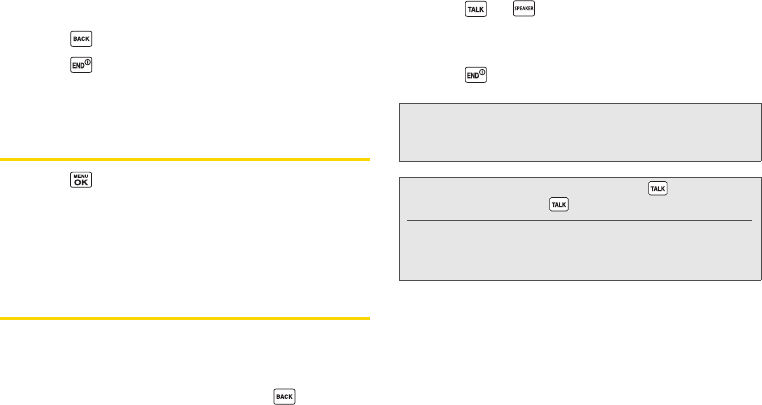
16 2A. Phone Basics
Backing Up Within a Menu
ᮣPress to go to the previous menu.
ᮣPress to return to standby mode.
Displaying Your Phone Number
ᮣPress > Settings > Phone Info > Phone#/User ID.
Your phone number and other information about your
phone and account will be displayed.
Making and Answering Calls
Making Calls
1. Enter a phone number from standby mode. (If you
make a mistake while dialing, press to erase
the numbers.)
2. Press or . (To make a call when you are
roaming and Call Guard is enabled, see “Call
Guard” on page 92.)
3. Press when you are finished.
You can also place calls from your phone by speed
dialing (page 22), by using Automatic Speech
Recognition (page 63), and by using your History
listings (page 47).
Note: If Parental Controls is on and Voice Calls are restricted,
you can only place calls to or receive calls from a
limited set of phone numbers. (See page 41.)
Tip: To redial your last outgoing call, press , highlight the
call, and then press again.
When making calls off the Nationwide Sprint Network,
always dial using 11 digits (1 + area code + phone
number).

2A. Phone Basics 17
Phone Basics
Dialing Options
When you enter numbers in standby mode, you can
see available dialing options by pressing OPTIONS
(right softkey). To select an option, highlight it and
press .
ⅷSave to save a phone number in your Contacts. (See
“Saving a Phone Number” on page 20.)
ⅷContact Details to view the detailed information of a
Contacts entry when the number you have entered is
already saved in your Contacts.
ⅷHard Pause to insert a hard pause. (See “Dialing
and Saving Phone Numbers With Pauses” on
page 21.)
ⅷ2-Sec. Pause to insert a two-second pause. (See
“Dialing and Saving Phone Numbers With Pauses”
on page 21.)
Answering Calls
1. Make sure your phone is on. (If your phone is off,
incoming calls go to voicemail.)
2. Press to answer an incoming call. (Depending
on your settings, you may also answer incoming
calls by pressing other keys. See “Call Answer
Mode” on page 39.)
Your phone notifies you of incoming calls in the
following ways:
ⅷThe phone rings or vibrates.
ⅷThe backlight illuminates.
ⅷThe screen displays an incoming call message.
If the incoming call is from a number stored in your
Contacts, the entry’s name is displayed. The caller’s
phone number may also be displayed, if available.
For other actions when receiving a call, you can select
an onscreen menu or press a key:
ⅢPress to answer the call in speaker mode.
ⅢAnswer to answer the call.
ⅢWhen connecting via Bluetooth, select Answer with
<Bluetooth device name> or Answer with Phone to
answer a call with your selected device.
Tip: When the left softkey displays SEND MESSAGE, press it
to send a message.
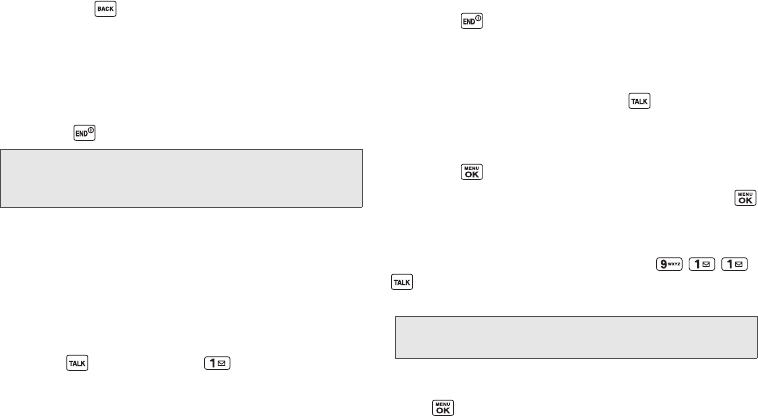
18 2A. Phone Basics
ⅢSilence to mute the ringer and stop the vibration.
Pressing or the volume button has the same
effect.
ⅢSend to Voicemail to ignore the call and transfer it
to your voicemail.
ⅢIgnore with Text to ignore the call and send a
message to the caller.
ⅢPress to ignore the call.
Answering a Roam Call With Call Guard Enabled
Call Guard is an option that helps you manage your
roaming charges when making or receiving calls while
outside the Nationwide Sprint Network. Please see
“Roaming” on page 91 for more information about
roaming.
ᮣPress , and then press to answer the call.
(See “Call Guard” on page 92 for additional
information.)
Ending a Call
ᮣPress .
Missed Call Notification
When an incoming call is not answered, your screen
displays the Missed Call log. Press to dial the
phone number.
To display a Missed Alerts entry from standby mode:
1. Press > Missed Alerts.
2. Highlight the entry you wish to view and press .
Calling Emergency Numbers
You can always place calls to 911 (dial
), even if your phone is locked or your account is
restricted.
During an emergency call, press OPTIONS (right
softkey) to display your options. Highlight an option and
press .
Note: Ignore with Text may not be displayed when calls are
from entries identified as No Caller ID, Private
(Restricted ID), or Unavailable ID.
Note: After you have placed an emergency call, your phone
automatically enters Emergency mode.

2A. Phone Basics 19
Phone Basics
ⅷTransfer Audio to switch the call to a Bluetooth device
(if applicable).
ⅷContacts to display your Contacts list.
ⅷVoice Memo to record the other party’s voice.
ⅷPhone Info to display information about your phone.
To exit Emergency mode:
1. Press to end a 911 call.
2. Press to exit emergency mode.
Enhanced 911 (E911) Information
This phone features an embedded Global Positioning
System (GPS) chip necessary for utilizing E911
emergency location services where available.
When you place an emergency 911 call, the GPS
feature of your phone seeks information to calculate
your approximate location. Depending on several
variables, including availability and access to satellite
signals, it may take up to 30 seconds or more to
determine and report your approximate location.
In-Call Options
Pressing OPTIONS (right softkey) during a call displays
a list of available in-call features.
ⅷTransfer Audio to switch the call to a Bluetooth device
(if applicable).
ⅷSave to save the current call’s phone number in your
Contacts.
ⅷContact Details to display information about the caller
stored in your Contacts.
ⅷMain Menu to display the phone’s main menu.
ⅷ3-Way Call to open a call with two other parties.
ⅷContacts to display your Contacts list.
ⅷVoice Memo to record the other party’s voice.
ⅷPhone Info to display information about your phone.
Tip: Press MY PHONE# (left softkey) to display your phone
number during an emergency call.
Important: Always report your location to the 911 operator
when placing an emergency call. Some
designated emergency call takers, known as
Public Safety Answering Points (PSAPs) may not
be equipped to receive GPS location information
from your phone.
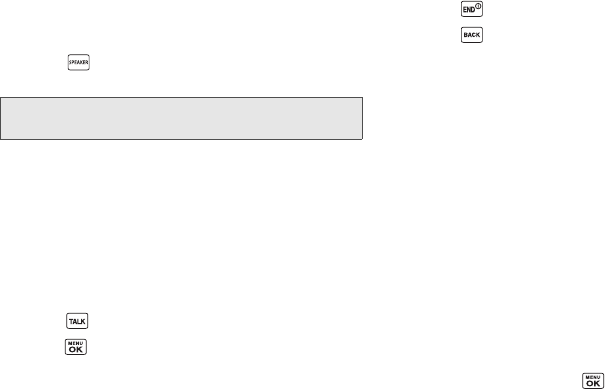
20 2A. Phone Basics
ᮣPress the volume button up or down to adjust the
receiver volume.
ᮣPress MUTE or UNMUTE (left softkey) to switch
between the mute or unmute mode. (Muting
applies to your voice, not the other party’s.)
ᮣPress to turn the speaker on. Press again to
turn it off.
End-of-Call Options
After you have finished your call, the phone will display
an end-of-call message in the Recent History screen
(see page 45). “Call ended” and the duration of the call
will alternately flash beneath the caller’s name (if already
in your Contacts) or the caller’s number (if available).
Press any key below to select an option.
ᮣPress to call a highlighted entry.
ᮣPress to display all history for a highlighted entry.
ᮣPress OPTIONS (right softkey) to display the Recent
History options. (See “History Options” on page 46
for details.)
ᮣPress SEND MESSAGE (left softkey) to send a
message.
ᮣPress to return to standby mode.
ᮣPress or simply wait 10 seconds to return to
where you were before the call (if applicable).
Saving a Phone Number
Your phone can store up to 600 Contacts entries and
each entry can contain up to seven phone numbers.
(See “2D. Contacts” on page 49.)
1. From standby mode, enter a phone number and
press OPTIONS (right softkey) > Save. (If this is the
first time you are saving an entry to Contacts, skip
to step 3.)
2. Select New Entry or Existing Entry.
3. If you chose New Entry, select a number type, and
then enter the new entry name.
– or –
If you chose Existing Entry, select an entry to which
you want to save the number, and then highlight a
number type and press .
4. Press DONE (left softkey) to save the entry.
WARNING: Because of higher volume levels, do not place the
phone near your ear during speakerphone use.

2A. Phone Basics 21
Phone Basics
Finding a Phone Number
You can search Contacts entries for phone numbers
that contain a specific string of numbers.
1. Enter four or more digits of the number in standby
mode. (The more numbers you enter, the more
specific the search becomes.)
2. All Contacts entries matching the entered numbers
will be displayed. Highlight an entry and press
to dial the number.
Dialing and Saving Phone Numbers With
Pauses
You can dial or save phone numbers with pauses for
use with automated systems, such as voicemail or
credit card billing numbers.
There are two types of pauses available on your phone:
ⅷHard Pause sends the next set of numbers when you
press SEND TONES (left softkey).
ⅷ2-Sec. Pause automatically sends the next set of
numbers after two seconds.
To dial or save phone numbers with pauses:
1. Enter all or part of a number.
2. Press OPTIONS (right softkey) > Hard Pause or
2-Sec. Pause.
3. Enter additional numbers.
4. Press OPTIONS (right softkey) > Save > New Entry
or Existing Entry to save the number in your
Contacts. (See steps 3 and 4 in “Saving a Phone
Number” on page 20.)
– or –
Press to dial the number.
5. Press SEND TONES (left softkey) to send the
additional number if you selected Hard Pause in
step 2.
Note: You can have multiple pauses in a phone number and
combine two-second and hard pauses.

22 2A. Phone Basics
Dialing From the Contacts List
1. From standby mode, press CONTACTS (right softkey).
2. Highlight the entry you want to call.
3. Press to dial the entry’s default phone number.
– or –
Press the navigation key left or right to show
another number for the entry and press .
Plus (+) Code Dialing
When placing international calls, use Plus Code Dialing
to automatically enter the international access code for
your location (for example, 011 for international calls
made from the U.S.).
1. Press and hold to display “+” on your phone
screen.
2. Enter the country code and phone number, and
then press . (The phone automatically
prepends the access code for international dialing,
followed by the country code and phone number.)
Speed Dialing
You can store up to 98 numbers in your phone’s speed
dial memory to make contacting friends and family
easier.
You must assign a speed dial number to the existing
phone number beforehand. See “Assigning Speed Dial
Numbers” on page 53.
To use speed dial for locations 2-9:
ᮣFrom standby mode, press and hold the
appropriate key for approximately two seconds.
To use speed dial for locations 10-99:
ᮣFrom standby mode, enter a two-digit speed dial
number, and then press .
The display confirms that the number has been dialed
when it shows “Connecting...”.
Note: Speed dialing may not be available when you are
roaming; when you are roaming off the Nationwide
Sprint Network, you must always dial using eleven
digits (1+ area code + number).

2A. Phone Basics 23
Phone Basics
Abbreviated Dialing
Abbreviated Dialing is similar to speed dialing. You can
use either of the following abbreviated dialing features.
ⅷContacts Match – Retrieve any number saved in your
Contacts by entering the four or more digits of any
part of the number.
ⅷPrepend – Prepend the first five or six digits (for
example, the area code and prefix) to any four or five
digits you enter.
To activate the Prepend feature:
1. Press > Settings > Others > Call Setup >
Abbrev. Dial.
2. Select Prepend > On.
3. Enter a five- or six-digit number and press .
To place a call using Abbreviated Dialing:
1. Enter the four or more digits of any part of a
Contacts entry’s phone number to use the
Contacts Match feature.
– or –
Enter the last four or five digits of the number to
use the Prepend feature.
2. Press to call the displayed number.
If there are two or more matched numbers in your
Contacts, a list is displayed. Highlight the name or
the phone number you want to call, and then press
to place a call.
Entering Text
Selecting a Text Input Mode
Your phone provides convenient ways to enter letters,
numbers, and symbols whenever you are prompted to
enter text.
1. From the message entry screen, press OPTIONS
(right softkey) > Text Mode.
– or –
From other text input screens such as Contacts or
Signature, press OPTIONS (right softkey).
Note: Contacts Match will not retrieve numbers if you
enter 911 or reserved three-digit service numbers such
as 411 or 711.
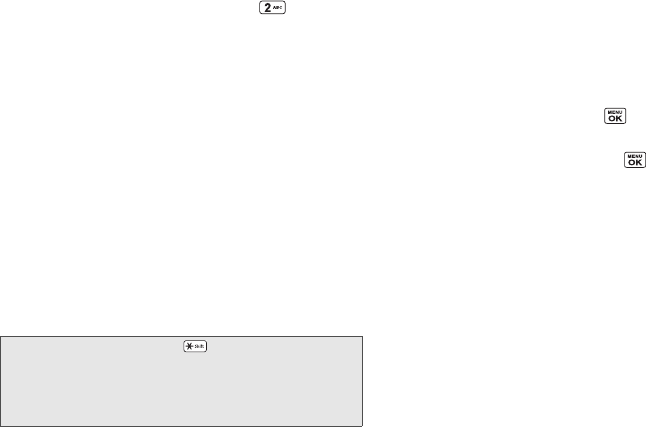
24 2A. Phone Basics
2. Select one of the following options:
ⅢAbc to use multi-tap entry – press once for
“a,” twice for “b”, three times for “c.” (See page 25.)
ⅢT9Word to enter text using a predictive text system
that reduces the number of keypresses required
while entering a word. (See page 25.)
Ⅲ123 to enter numbers.
ⅢSymbols to enter symbols.
ⅢSmileys to enter smile icons.
ⅢEmoticons to enter “emoticons.” (This is available, for
example, when composing a message, or when
editing a Schedule or To Do description in Calendar.)
ⅢPaste List to paste copied or cut text (if applicable).
ⅢWeb Shortcuts to enter Web shortcuts (for
example, www., http://, or .com).
ⅢText Options to display the text entry options menu
(if applicable).
Setting Text Entry Options
The text entry options menu allows you to specify a
suitable feature during the text entry process.
1. From a screen where you can enter text, press
OPTIONS (right softkey) > Text Options.
– or –
From standby mode, press > Settings >
Text Entry.
2. Highlight an option and press .
ⅢWord Complete to suggest possible words based
on letters you have entered when the T9 Text
Input mode is enabled.
ⅢNext Word Complete to automatically display the
word that may follow the current text input.
ⅢPhrase Complete to set the phone to predict
possible sentence candidates after one word with
a space is entered.
ⅢWord Scan to allow T9 Text Input to suggest words
by searching Contacts.
ⅢWord Choice List to select whether to display or
hide the word choice list.
ⅢInput Language to select the language to enter
(English or Spanish).
Tip: When entering text, press to change the
capitalization style as T9Word > T9WORD > T9word
(T9Word mode), or as Abc > ABC > abc (Abc mode).
The selected style is displayed in the bottom-right corner
of the screen, above the right softkey label (if applicable).
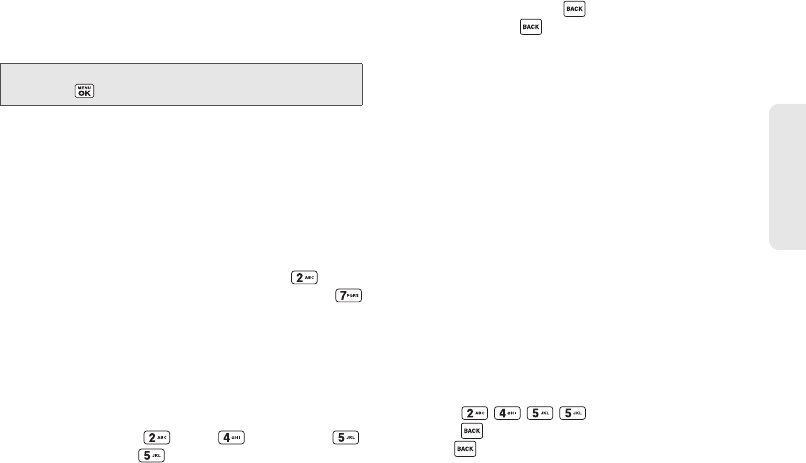
2A. Phone Basics 25
Phone Basics
ⅢMy Words to edit or delete custom words you
have added to the predictive text database.
●Add Word to store words that you frequently use.
ⅢSelect Text to select text for copying, cutting or
adding (if applicable).
ⅢDelete All to delete all text (if applicable).
ⅢHelp to view the T9 Text Input instructions.
ABC Mode
In Abc mode, also known as multi-tap entry, you press
keys one, two, three, or four times to enter the letters
you see on the keypad. For example, press once
for “a,” twice for “b”, or three times for “c”; or press
once for “p,” twice for “q,” three times for “r,” or four
times for “s.”
1. Select the Abc text input mode. (See “Selecting a
Text Input Mode” on page 23.)
2. Press the corresponding keys repeatedly until the
correct letter appears. (For example, to enter the
word “Bill,” press twice, three times,
three times, and three times again.) (If you
make a mistake, press to erase a single character.
Press and hold to erase an entire word.)
By default, the first letter of an entry is capitalized and
the following letters are lowercased. After a character is
entered, the cursor automatically advances to the next
space after two seconds or when you enter a character
on a different key.
T9 Text Input
T9 Text Input lets you enter text by pressing keys just once
per letter. (To select the T9Word mode when entering text,
see “Selecting a Text Input Mode” on page 23.)
T9 Text Input uses an intuitive word database to
analyze the letters you enter and create a suitable
word. (The word may change as you type.)
1. Select the T9Word text input mode.
2. Press the corresponding keys once per letter to
enter a word. A word choice list opens and shows
words starting with the letters you have entered
thus far. (For example, to enter the word “Bill,”
press .) (If you make a mistake,
press to erase a single character. Press and
hold to erase an entire word.)
Tip: To access the My Words menu from the Settings menu,
press
> Settings > Text Entry > My Words.

26 2A. Phone Basics
If the word you want is not displayed after you have
entered all the letters, press the navigation key down to
scroll through additional word selections. To accept a
word and insert a space, press or .
Adding a Word to the T9 Database
If a word you want to enter is not displayed as an option
while you are using T9 Text Input, add it to the database.
1. While you are in T9Word mode, enter a letter.
(A word choice list opens.)
2. Scroll down the list and select <Add Word>.
3. Enter a word and press SAVE (left softkey). The
word will appear as an option the next time you
scroll through options during T9 Text Input.
For more information about T9 Text Input, visit the
Nuance website at http://www.nuance.com/t9/textinput/.
Simple Data Exchange
This feature makes it easy to select certain information
in a message and automatically save it or use it in a
related application.
Simple Data Exchange works with these types of
information:
ⅷEmail addresses
ⅷStreet addresses
ⅷPhone numbers
ⅷWeb addresses (URLs)
Email Address Options
ᮣHighlight an email address (or a saved Contacts
entry name in the From/To field in the message
details screen), press , and select an option:
ⅢSend Message > Message. The messaging
application will open and the email address will
appear as the message’s recipient.
ⅢShare > Message. The application will open and
the email address will appear in the message
body.

2A. Phone Basics 27
Phone Basics
ⅢSave to Contacts to save the email address in
Contacts.
ⅢContact Details to display the Contacts entry if the
email address is already saved in Contacts.
Street Address Options
ᮣHighlight a street address, press , and select an
option:
ⅢShare > Message. The application will open and
the address will appear in the message body.
ⅢSave to Contacts to save the address in Contacts.
Phone Number Options
ᮣHighlight a phone number (or a saved Contacts
entry name in the From/To field in the message
details screen), press , and select an option:
ⅢCall to call the phone number.
ⅢPrepend to prepend a number to the phone
number.
ⅢSend Message to open the messaging application.
The phone number will appear in the To: field.
ⅢShare > Message. The application will open and
the phone number will appear in the message
body.
ⅢSave to Contacts to save the phone number in
Contacts.
ⅢContact Details to display the Contacts entry if the
phone number is already saved in Contacts.
Web Address (URL) Options
ᮣHighlight a Web address (URL), press , and
select an option:
ⅢBrowse to open the browser to the Web page.
ⅢShare > Message. The application will open and
the Web address will appear in the message
body.
ⅢSave to Contacts to save the Web address in
Contacts.

28 2B. Settings
ࡗDisplay Settings (page 28)
ࡗVolume Settings (page 31)
ࡗRinger Settings (page 32)
ࡗMessaging Settings (page 34)
ࡗAirplane Mode (page 36)
ࡗTTY Use With Sprint Service (page 36)
ࡗUsing the Hearing Aid Device Compatibility Function
(page 38)
ࡗPhone Setup Options (page 38)
ࡗSecurity Settings (page 40)
Display Settings
Changing the Screen Saver
You can set a screen saver to display while in standby
mode.
1. Press > Settings > Display > Screensaver.
2. Select a screen saver option by pressing the
navigation key up or down, and select a screen
saver.
ⅢIf you select Take New Picture, press to take a
picture, and then press OK (left softkey) to assign it.
Changing the Brightness
You can adjust the brightness on the main screen.
When Power Save Mode is on and Backlight Dim is set
to Always Dim, you cannot change this setting.
1. Press > Settings > Display > Brightness.
2. Highlight a brightness level and press twice.
2B. Settings
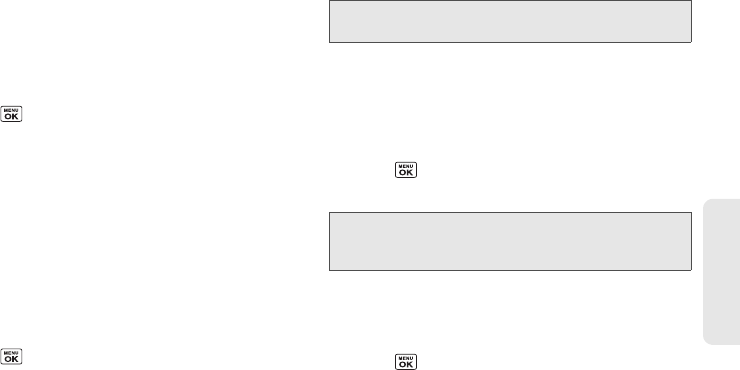
2B. Settings 29
Settings
Changing the Backlight Time Length
Select how long the main screen and keypad remain
backlit after any keypress is made. You can also
change the backlight for when a Java application is
running in the foreground.
ᮣPress > Settings > Display > Backlight >
Backlight Dim or Backlight Off.
ⅢIf you select Backlight Dim, select Always Bright,
Always Dim, or a preset length of time to elapse
before the screen backlight dims.
ⅢIf you select Backlight Off, select a preset length of
time to elapse before the screen and keypad
backlights turn off. (When you select Always Bright
for the Backlight Dim setting above, the keypad
backlight will turn off after about one minute.)
To set the backlight for when a JAVA application is running
in the foreground:
ᮣPress > Settings > Display > Backlight >
Java Backlight > Default or Continuous.
This setting is switched to the normal backlight setting
above after the application is terminated or is sent to
the background.
Setting the Notification Pop-up
This option allows you to enable or disable notification
pop-up when you receive a new notification (except for
incoming call and alarm).
1. Press > Settings > Display > Notification.
2. Select Enable pop-up or Disable pop-up.
Selecting a Picture ID
You can select an image as a picture ID.
1. Press > Settings > Display > Picture ID.
2. Select Contact, Unsaved Numbers, or
Private / Unknown.
ⅢIf you select Contact, select an entry.
Note: Long backlight settings reduce the battery’s talk and
standby times.
Tip: If you select Disable pop-up, you will see only a
notification icon. (The notification pop-up will not appear
while an application is running.)

30 2B. Settings
3. Select a picture ID option by pressing the navigation
key up or down, and then select an image.
ⅢIf you select Take New Picture, press to take a
picture, and then press OK (left softkey) to assign it.
Power Save Mode
This feature helps conserve your battery power by
automatically adjusting settings for the backlight and
keypad light.
1. Press > Settings > Display > Power Save Mode.
2. Select On. (Select Off to deactivate this feature.)
3. Read the message and press CONTINUE (left
softkey).
Changing the Clock/Calendar Display
Choose which design of clock or calendar you want to
display in standby mode.
1. Press > Settings > Display > Clock/Calendar.
2. Highlight a display option and press twice.
Setting a Custom Greeting
You can display your own custom greeting in standby
mode.
1. Press > Settings > Display > Greeting > Custom.
2. Enter a custom greeting and press .
3. Press DONE (left softkey) to save your greeting.
Changing the Phone’s Menu Style
Choose the layout of your phone’s menu.
1. Press to display the main menu.
2. Press OPTIONS (right softkey) > List View or
Grid View.
Changing the Font Size
Adjust the display and text input font size. This setting
does not affect all screens.
ᮣFrom the main menu screen, press OPTIONS (right
softkey) > Large Font or Normal Font to change the
font size.
– or –
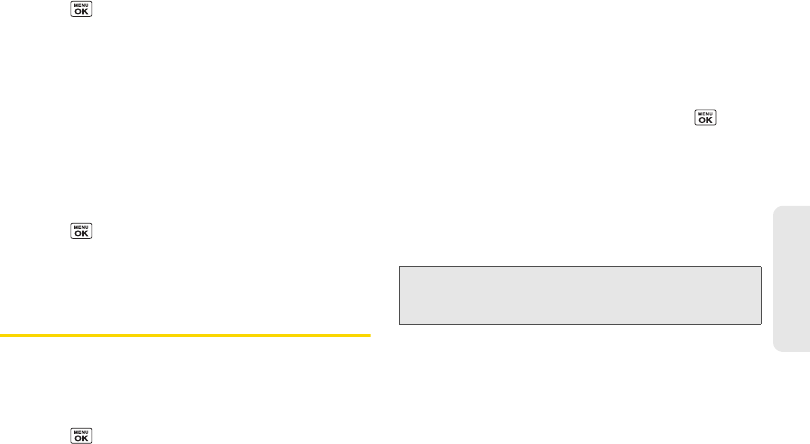
2B. Settings 31
Settings
1. Press > Settings > Others > Accessibility >
Font Size.
2. Highlight Normal Font or Large Font. You can see
the highlighted font size in the New Size window.
3. If you are satisfied with the font size, press SAVE
(left softkey).
Display Language
You can choose to display your phone’s onscreen
menus in English or in Spanish.
1. Press > Settings > Others > Language.
2. Select English or Español.
Volume Settings
Adjusting the Phone’s Volume Settings
Adjust your phone’s volume settings to suit your needs
and your environment.
1. Press > Settings > Volume.
2. Select Incoming Ringer, Playback Volume,
Power Up/Down, or Key Beeps.
ⅢIf you select Power Up/Down, select On or Off.
ⅢIf you select Key Beeps, select Tone Volume or
Tone Type.
3. Select a volume level or type and press
To change the incoming ringer or playback volume:
1. Press the volume button up or down for most
applications, including playing sounds. A volume
setting screen is displayed.
2. Press the volume button up or down to select the
volume level.
Silence All
The Silence All option allows you to mute all sounds
without turning your phone off.
Tip: You can make the incoming ringer vibrate at any volume
level by pressing VIBRATE (left softkey) on the volume
setting screen.
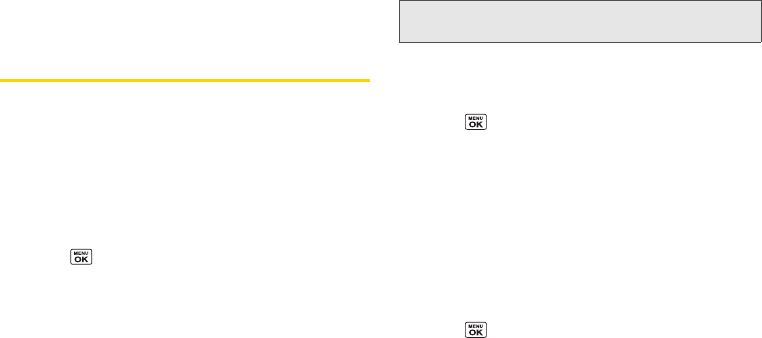
32 2B. Settings
To activate Silence All:
ᮣPress and hold the volume button down whenever
your phone is turned on. (The screen will display
“Silence All.”)
To deactivate Silence All:
ᮣPress the volume button up repeatedly to select a
volume level.
Ringer Settings
Ringer Types
Ringer types help you identify incoming calls and
messages. You can assign ringer types to individual
Contacts entries, types of calls, and messages.
Selecting Ringer Types for Incoming Calls and
Messages
1. Press > Settings > Ringers > Incoming Calls or
Messages.
2. Select Contacts, Unsaved Numbers, or
Private / Unknown.
ⅢIf you select Contacts, select All Contacts, or select
One Contact and then select an entry.
3. Select a ringer option by pressing the navigation
key up or down, and then select a ringer. (See
“Getting New Ringers” on this page if you selected
Downloaded > Get New.)
Selecting Ringer Types for Voicemail, Calendar,
and Power Up/Down
1. Press > Settings > Ringers.
2. Select Voicemail, Calendar, or Power Up/Down.
3. Select a ringer option by pressing the navigation
key up or down, and then select a ringer.
Getting New Ringers
A wide variety of new ringers is available from the
Sprint Digital Lounge, and you can access them right
from your phone. (Additional charges may apply, but
some are free.)
1. Press > Settings > Ringers.
Tip: Ringer types can be assigned from the Contacts menu.
See “Selecting a Ringer Type for an Entry” on page 54.
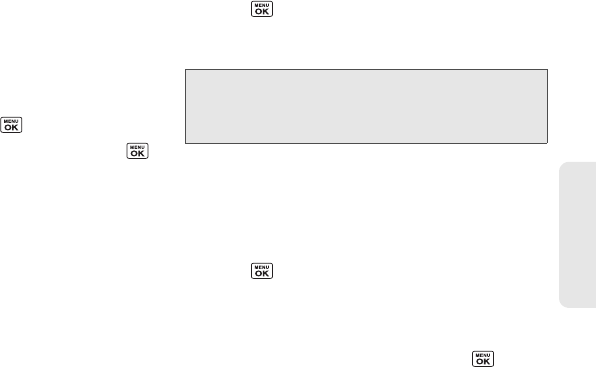
2B. Settings 33
Settings
2. Select a ringer type category (Incoming Calls,
Voicemail, Messages, etc.) and any applicable
subcategories until you arrive at the “Assign Data?”
screen.
3. Select Downloaded > Get New. (The Digital Lounge
will launch and display the Ringers menu.)
4. Use the navigation key and keypad to search
through available ringers. When you find one you
want, highlight it and press .
5. To purchase the ringer, highlight Buy and press .
(The ringer will download automatically.)
6. When the download is finished, select an option to
continue:
ⅢListen to listen to the ringer.
ⅢAssign to assign the ringer to a call or message
type or to a specific contact.
ⅢShop to browse for other items to download.
Setting Up Voice Guide
Voice Guide allows you to hear voice prompts and
spoken numbers or key names as you press a key, and
also to hear menus and options, Contacts names,
email addresses, URLs, etc., as you highlight each item
onscreen. (The default setting is Off.)
1. Press > Settings > Others > Accessibility >
Voice Services > Voice Guide.
2. Select On or Off.
Selecting Vibration Patterns
With this feature, you can select vibration patterns for
incoming calls, messages, alarms, and scheduled
events.
1. Press > Settings > Others > Accessibility >
Vibrate Type.
2. Select Incoming Calls, Voicemail, Messages, or
Alarm/Calendar.
3. Highlight a vibration pattern and press .
Note: When the incoming ringer volume is set to Silence All
or Vibrate All, and when the playback volume is set to
Volume Off, Voice Guide does not work. (See “Volume
Settings” on page 31.)

34 2B. Settings
Messaging Settings
Your phone’s advanced messaging capabilities let you
send and receive different kinds of messages without
placing a voice call.
Messaging settings allow you to create a signature with
each sent message and your own preset messages.
Setting Reset Envelope
Reset Envelope will clear the envelope icon on the
display.
1. From standby mode, press MESSAGING (left
softkey) > OPTIONS (right softkey) > Reset Envelope.
2. Press YES (left softkey).
Setting a Callback Number
With this feature, you can specify the callback number
which your recipients see when you send messages.
1. From standby mode, press MESSAGING (left
softkey) > OPTIONS (right softkey) > Callback Number.
2. Select None, My Phone Number, or Other. If you
select Other, enter a callback number and
press .
Adding a Customized Signature
Add a customized signature to each message you
send.
1. From standby mode, press MESSAGING (left
softkey) > OPTIONS (right softkey) > Signature.
2. Select On. (If you do not wish to attach a signature
to your outgoing messages, select Off.)
3. Enter a signature and press .
Tip: Press OPTIONS (right softkey) > Add Signature to insert
your signature on the message entry screen when
Signature is set to Off.

2B. Settings 35
Settings
Managing Preset Messages
Your phone is loaded with 20 preset messages to help
make sending messages easier. Customize or delete
these messages, such as “Where are you?,” “Let’s get
lunch,” and “Meet me at” to suit your needs, or add
your own messages to the list.
To edit, delete, or reset preset messages:
1. From standby mode, press MESSAGING (left
softkey) > OPTIONS (right softkey) > Preset Messages.
The list of preset messages will be displayed.
2. To edit or delete a message, or reset all messages
to the original text, highlight a message and press
OPTIONS (right softkey).
3. Select Edit, edit the message, and press .
– or –
Select Delete > YES (left softkey) to delete the
message.
– or –
Select Reset all messages > YES (left softkey) to
reset all messages.
To change the language of the preset messages:
1. From standby mode, press MESSAGING (left
softkey) > OPTIONS (right softkey) > Preset Messages.
2. Press OPTIONS (right softkey) > Select Language.
3. Select English or Spanish.
Setting CMAS Alerts
This phone features an embedded Commercial Mobile
Alert System (CMAS), which is a federally supervised
cell phone alert service to send out broadcast SMS
messages for public warning.
1. From standby mode, press MESSAGING (left
softkey) > OPTIONS (right softkey) > CMAS Alerts.
2. Check the box next to the options you wish to
select:
ⅢPresidential Alerts to deliver a national Presidential
alert. (Presidential Alerts is always grayed out [not
selectable] and cannot be excluded.)
ⅢImminent Threat - Extreme to deliver emergency
alerts in an extreme emergency situation (an
extraordinary threat to life or property).

36 2B. Settings
ⅢImminent Threat - Severe to deliver emergency
alerts in a severe emergency situation (a
significant threat to life or property).
ⅢAmber Alerts to deliver alerts related to missing or
endangered children.
ⅢCMAS Test Messages to send a test message to
make sure that the alert messages can be
successfully received.
Airplane Mode
Airplane Mode allows you to use many of your phone’s
features, such as games and voice memos, when you
are in an airplane or in any other area where making or
receiving calls or data is prohibited. When you set your
phone to Airplane Mode, it cannot send or receive any
calls or access online information.
1. Press > Settings > Others > Airplane Mode.
2. Read the disclaimer and press .
3. Select an option from the following:
ⅢOn to activate Airplane Mode. Airplane Mode will
be deactivated when you turn the phone off.
ⅢOff to deactivate Airplane Mode immediately.
ⅢOn Power-up to activate Airplane Mode the next
time the phone is powered on and to keep
Airplane Mode activated even when the phone is
repeatedly turned on and off.
While in Airplane Mode, your phone’s screen will
display “Phone Off.”
TTY Use With Sprint Service
A TTY (also known as a TDD or Text Telephone) is a
telecommunications device that allows people who are
deaf, hard of hearing, or who have speech or language
disabilities to communicate by telephone.
Your phone is compatible with select TTY devices.
Please check with the manufacturer of your TTY device
to ensure that it is compatible with digital cell phones.
Your phone and TTY device will connect via a special
cable that plugs into your phone’s headset jack. If this
cable was not provided with your TTY device, contact
your TTY device manufacturer to purchase the
connector cable.

2B. Settings 37
Settings
To turn TTY Mode on or off:
1. Press > Settings > Others > Accessibility > TTY.
(You will see an informational message.)
2. Press .
3. Select one of the following options:
ⅢTTY Off to disable TTY mode.
ⅢTTY VCO to enable TTY mode in Voice Carry
Over mode, which allows you to send voice and
receive text during a call.
ⅢTTY HCO to enable TTY mode in Hearing Carry
Over mode, which allows you to send text and
receive voice during a call.
ⅢTTY Full to enable all TTY settings. You can send
and receive text during a call.
To access the state Telecommunications Relay Service
(TRS) for assistance with TTY calls:
ᮣDial and press to reach an
operator.
For additional information about Sprint Relay Services
and TTY compatibility, call Sprint Relay Customer
Service at 800-676-3777 or visit www.sprintrelay.com.
Note: In TTY Mode, your phone will display the TTY icon if a
TTY device or an optional headset is connected to your
phone.
When enabled, TTY mode may impair the audio quality
of non-TTY devices connected to the headset jack.
WARNING: 911 Emergency Calling
Sprint recommends that TTY users make
emergency calls by other means, including
Telecommunications Relay Services (TRS),
analog cellular, and landline communications.
Wireless TTY calls to 911 may be corrupted
when received by public safety answering points
(PSAPs), rendering some communications
unintelligible. The problem encountered appears
related to software used by PSAPs. This matter
has been brought to the attention of the FCC,
and the wireless industry and the PSAP
community are currently working to resolve this.

38 2B. Settings
Using the Hearing Aid Device
Compatibility Function
Your phone has been tested and rated for hearing aid
device compatibility. To use this function effectively, set
the hearing aid option to On.
1. Press > Settings > Others > Accessibility >
Hearing Aid.
2. Read the disclaimer and press .
3. Select On or Off.
ⅢOn to use a hearing aid device with your phone.
ⅢOff to use your phone without a hearing aid
device.
For more information about hearing aid device
compatibility, see “Using Your Phone With a Hearing
Aid Device” on page 112.
Phone Setup Options
Navigation Key Shortcuts
You can use the navigation key to access shortcuts to
specific menu items directly from standby mode. You
can reassign the default shortcuts to the menu items
you choose.
1. Press > Settings > Others > Navigation Keys.
2. Highlight a navigation key direction you wish to
reassign and press .
3. Using the navigation key or your keypad, highlight
a function.
4. Press ASSIGN (left softkey) to save. (For options
with submenu levels, such as Settings, you can
assign submenu options by navigating to the
desired option before pressing ASSIGN.)
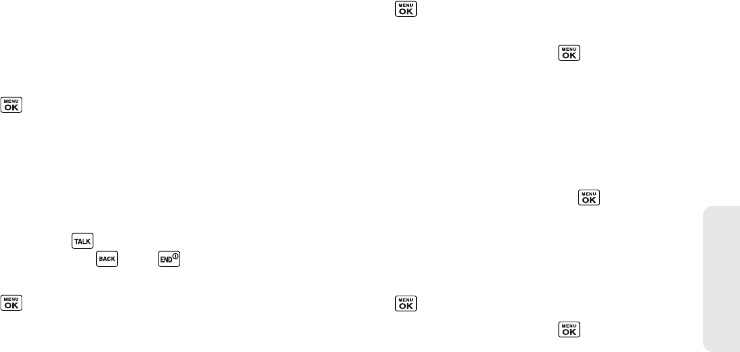
2B. Settings 39
Settings
Alert Notification
Set your phone to alert you with an audible tone when
you change service areas, once a minute during a
voice call, or when a call has been connected.
1. Press > Settings > Others > Alerts.
2. Select Beep Each Minute, Out of Service, or Connect.
3. Select On or Off.
Call Answer Mode
Select how to answer incoming calls on your phone:
whether by pressing , by pressing any key (except
softkeys, volume button, , and ), or by opening
the phone.
1. Press > Settings > Others > Call Setup >
Call Answer.
2. Select Talk Key, Any Key, or Flip Open.
Auto-Answer Mode
Set your phone to automatically pick up incoming calls.
Remember, your phone will answer calls in auto-
answer mode even if you are not present.
1. Press > Settings > Others > Call Setup >
Auto-Answer.
2. Highlight an option and press .
ⅢHands-free to answer calls automatically when the
phone is connected to an optional headset or
hands-free device.
ⅢSpeakerphone to answer calls automatically in
speakerphone mode.
3. Highlight the time you would like your phone to
wait before answering and press .
Headset Mode
Set the sound output destination of incoming ringer on
your phone.
1. Press > Settings > Others > Headset Mode.
2. Highlight an option and press .
ⅢNormal to play the ring tone for incoming calls
through both the headset and the speaker.
ⅢHeadset Only to play the ring tone for incoming
calls only through the headset.
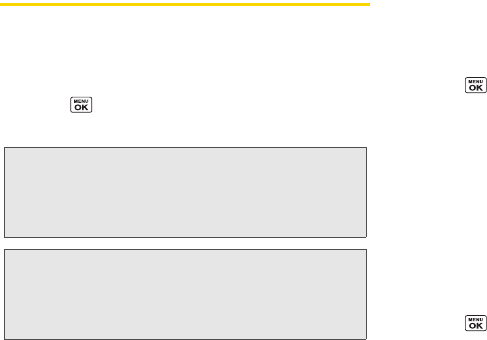
40 2B. Settings
Security Settings
Accessing the Lock Phone Menu
You must enter your lock code to view the Lock Phone
menu.
1. Press > Settings > Lock Phone.
2. Enter your lock code and press CONTINUE (left softkey).
Your Phone’s Lock Feature
Locking Your Phone
When your phone is locked, you can only make calls
to 911 and Sprint Customer Service.
1. Press > Settings > Lock Phone.
2. Enter your lock code and press CONTINUE (left
softkey).
3. Select Lock Now.
Unlocking Your Phone
1. From standby mode, press UNLOCK (left softkey).
2. Enter your lock code and press CONTINUE (left
softkey).
Changing the Lock Code
1. Press > Settings > Lock Phone or Reset/Delete.
2. Enter your lock code and press CONTINUE (left
softkey).
3. Select Change Lock Code.
Note: The first time you access the Lock Phone menu, you
will be advised to change the default lock code by
pressing CHANGE (left softkey). Enter and re-enter your
new lock code to proceed. For details, see “Changing
the Lock Code” on this page.
Tip: If you can’t recall your lock code, try using the last four
digits of your wireless phone number or check your
lock code hint (see “Changing the Lock Code” on this
page). If this doesn’t work, call Sprint Customer Service
at 1-888-211-4727.

2B. Settings 41
Settings
4. Enter your new lock code and press CONTINUE
(left softkey).
5. Re-enter your new lock code and press SAVE (left
softkey).
Each time you change the lock code, you will be
prompted whether to create a lock code hint. Press YES
(left softkey) or NO (right softkey) when prompted.
To edit or delete a lock code hint:
1. Press > Settings > Lock Phone.
2. Enter your lock code and press CONTINUE (left
softkey) > Lock Code Hint.
3. Edit or delete the hint and press .
Parental Controls
This feature allows parents to prevent children from
using certain functions on the phone.
Activating Parental Controls
1. Press > Settings > Parental Controls > On/Off >
On.
2. Enter your new code and press CONTINUE (left
softkey).
3. Re-enter your new code and press SAVE (left
softkey).
Repeat the procedure above with each change from
Off to On. Also, while set to On, a user will be required
to enter the current code to access the Parental
Controls menu.
Changing the Parental Control Code
1. Press > Settings > Parental Controls >
Change Parental Control Code.
2. Enter your new code and press CONTINUE (left
softkey).
3. Re-enter your new code and press SAVE (left
softkey).
Restricting Voice Calls and Messages
1. Press > Settings > Parental Controls >
Restriction.
2. Read the message and press CONTINUE (left softkey).
3. Select an option:
ⅢVoice Calls to restrict incoming and outgoing
voice calls except those placed to 911 or Sprint
Customer Service.

42 2B. Settings
ⅢMessages to restrict sending messages except to
designated recipients.
4. Select On/Off > On. If you selected Voice Calls
in step 3, read the message and press OK (left softkey).
5. Select Allowed Contacts > All Contacts or
Choose Contacts.
ⅢIf you select All Contacts, press to confirm.
ⅢIf you select Choose Contacts, select <Add Contact>,
and then choose a member from the list. If you want to
remove a member from the list, highlight the member
and press REMOVE (left softkey).
Restricting Web, Camera, and Location Mode
1. Press > Settings > Parental Controls >
Restriction.
2. Read the message and press CONTINUE (left
softkey).
3. Select an option:
ⅢWeb to prevent using the browser.
ⅢCamera to prevent using the camera.
ⅢForce Location On to prevent changing the
Location setting from On to Off. (See “GPS
Services” on page 106.)
4. Select On.
Deleting Phone Content
You can quickly and easily delete all the content that
you have created or stored in your phone.
1. Press > Settings > Reset/Delete.
2. Enter your lock code and press CONTINUE (left
softkey).
3. Select Delete Stuff.
4. Highlight an option and press .
ⅢMessages to delete all messages.
ⅢCall Logs to delete all call history from the phone.
ⅢBrowser Cookies and Cache to delete all Web
cookies and all Web cache memory saved in the
phone.
ⅢDownloaded Content to delete all data
downloaded to your phone.
Note: If you select On in step 4, you cannot add, edit, and
delete any Contacts or Group entries.

2B. Settings 43
Settings
ⅢContacts to delete all of your Contacts including
speed dial numbers saved in your Contacts.
ⅢVoice Memo to delete all voice data and call
memos saved in the phone.
ⅢMy Photos to delete all pictures stored in My
Photos.
ⅢAll Stuff to delete everything in all the above
categories.
5. Read the message and press DELETE (left softkey).
Resetting Your Phone and Phone Content
This option lets you clear different types of personal
information stored on your phone, reset your phone to
factory settings, or both.
1. Press > Settings > Reset/Delete.
2. Enter your lock code and press CONTINUE (left
softkey).
3. Highlight an option and press .
ⅢReset Settings to restore all the factory defaults,
including ringer types and display settings.
Contacts, History, Calendar, and Messaging are
not affected.
ⅢReset Phone to reset all settings and erase all data
on your phone.
4. Read the message and press the left softkey
(RESET SETTINGS or RESET PHONE).
Security Features for Data Services
Enabling Data Services
Although data services are disabled on your phone by
default, you may enable them at any time.
To enable data services:
1. Press > Settings > Others > Data > Data Off.
2. Read the message and press the left softkey to
sign in.
Disabling Data Services
You can disable data services again without turning off
your phone; however, you will not have access to all
data services, including Web and messaging.
Disabling data services will avoid any charges
associated with these services. While signed out, you
can still place or receive phone calls, check voicemail,
and use other voice services.

44 2B. Settings
To disable data services:
1. Press > Settings > Others > Data > Data On.
2. Read the disclaimer and press DISABLE (right
softkey) to sign out.
Net Guard
When you first connect to the Web, the Net Guard will
be displayed to confirm that you want to connect. The
Net Guard helps you avoid accidental connections.
You can disable the Net Guard in the future by
selecting Auto-Connect when you see Net Guard
displayed.
To change your Net Guard settings:
ᮣPress > Settings > Others > Data > Net Guard.
ⅢOn to activate the Net Guard.
ⅢOff to deactivate the Net Guard.
Note: When enabled, Net Guard appears only once as long
as you have not turned the phone off and on.
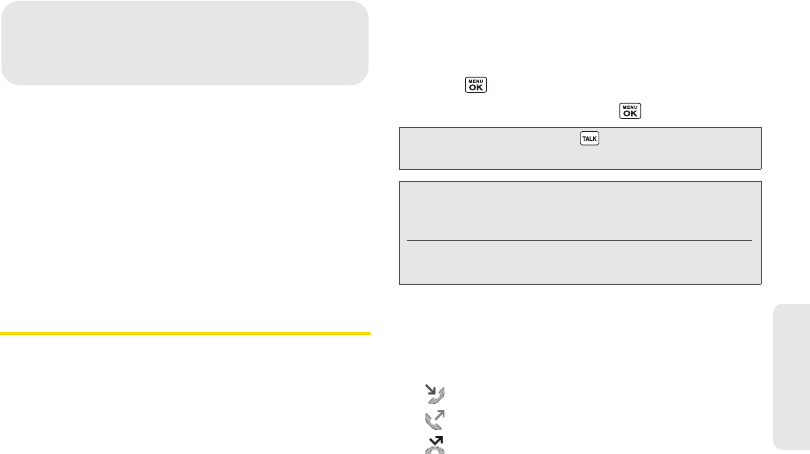
2C. History 45
History
ࡗViewing History (page 45)
ࡗHistory Thread (page 46)
ࡗHistory Details (page 46)
ࡗHistory Options (page 46)
ࡗMaking a Call From History (page 47)
ࡗSaving a Number From History (page 47)
ࡗMaking a New Group Entry From History (page 47)
ࡗDeleting History (page 48)
Viewing History
History is a list of the last 60 phone numbers (or
Contacts entries) for voice calls you placed, accepted,
or missed. History makes redialing fast and easy. It is
continually updated as new numbers or entries are
added to the beginning of the list and the oldest entries
are removed from the bottom of the list.
Each entry contains the phone number (if available)
and Contacts entry name (if the number is in your
Contacts). Duplicate calls (calls from the same
number) may appear only once on the list.
1. Press > History.
2. Highlight an entry and press .
History Icons
You can determine if an entry was an incoming,
outgoing, or missed call from the icons shown below.
– Incoming Call
– Outgoing Call
– Missed Call
2C. History
Shortcut: You can also press from standby mode to
display your recent calls.
Note: History records only calls that occur while the phone is
turned on. If a call is received while your phone is
turned off, it will not be included in history.
If you return a call from the voicemail menu, it will not be
included in your phone’s history.
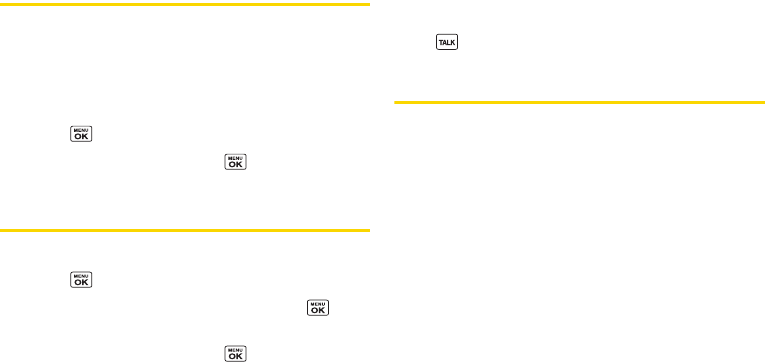
46 2C. History
History Thread
The History thread screen shows all history for a
selected entry. You can also keeps track of all the
messages you have sent to and received from the
selected entry.
To display a History thread:
1. Press > History.
2. Highlight an entry and press .
History Details
To display History details:
1. Press > History.
2. Highlight an entry from the list and press .
The History thread is displayed.
3. Highlight an entry and press .
The History details screen shows the number type
(Mobile, Home, etc.), phone number, and date and time
of the call. An onscreen menu is also displayed
according to the type of call. (See “History Options” on
this page).
To make a call from the History details screen,
press .
History Options
You may see several menu items on the onscreen menu.
Press OPTIONS (right softkey) for additional options.
ⅷCall to call the selected entry.
ⅷSend Message to send a message to the selected
entry.
ⅷNew Group to create a new Group entry.
ⅷContact Details to display information about the entry
if it has already been saved in your Contacts.
ⅷSave Contact to save a phone number. (See “Saving
a Number From History” on page 47.)
ⅷDelete to delete the entry.
ⅷDelete All to delete all History entries. (See “Deleting
History” on page 48.)
ⅷPrepend to add numbers to the beginning of the
selected number.
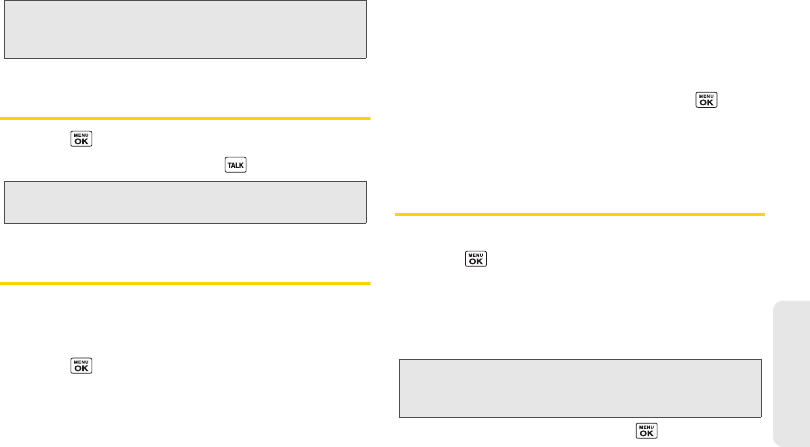
2C. History 47
History
Making a Call From History
1. Press > History.
2. Highlight an entry and press .
Saving a Number From History
Your phone can store up to 600 Contacts entries, and
each Contacts entry can store up to a total of seven
phone numbers.
1. Press > History.
2. Highlight a History entry and press OPTIONS (right
softkey) > Save Contact.
3. Select New Entry or Existing Entry.
4. If New Entry was selected, select a number type,
and then enter the new entry name.
– or –
If Existing Entry was selected, select an existing
entry to which you want to save the number, and
then highlight a number type and press .
5. Press DONE (left softkey) to save the entry.
Making a New Group Entry From
History
You can make and save a new group entry from History.
1. Press > History > OPTIONS (right softkey) >
New Group.
2. Read the message and press START (left softkey).
3. Select the check box for each member you wish to
add and press CONTINUE (left softkey).
4. Enter a group name and press > SAVE (left
softkey).
Note: If Parental Controls is on and Voice Calls or Messaging
is restricted, you cannot use the New Group or Save
Contact menu. (See page 41.)
Note: You cannot make calls from History entries identified as
No Caller ID, Private (Restricted ID), or Unavailable ID.
Tip: Press OPTIONS (right softkey ) > Enter New Address or
Contacts to enter a new address or a phone number or
to select an entry from your Contacts.

48 2C. History
Deleting History
You can delete individual or all entries in your History.
1. Press > History.
2. Highlight an entry you wish to delete and press
OPTIONS (right softkey) > Delete.
ⅢSelect Delete All to delete all entries.
3. If you are certain you want to delete one or all
entries from History, press DELETE (left softkey).

2D. Contacts 49
Contacts
ࡗAbout Contacts (page 49)
ࡗDisplaying Contacts Entries (page 49)
ࡗAdding a New Contacts Entry (page 50)
ࡗEditing a Contacts Entry (page 50)
ࡗAdding a Number to a Contacts Entry (page 51)
ࡗCreating a Group (page 51)
ࡗEditing Groups (page 51)
ࡗFinding Contacts Entries (page 52)
ࡗUsing Contacts Information in Other Applications (page 53)
ࡗAssigning Speed Dial Numbers (page 53)
ࡗSelecting a Ringer Type for an Entry (page 54)
ࡗAssigning a Picture to an Entry (page 54)
ࡗSecret Contacts Entries (page 55)
ࡗMy Name Card (page 55)
ࡗDialing Sprint Services (page 56)
About Contacts
Your phone can store up to 600 Contacts entries. Each
entry can contain up to seven phone numbers, three
email addresses, three IM addresses, and three Web
addresses. You can also add Contacts entries to a
Group, allowing you to send one message to up to 40
Contacts entries at a time.
Displaying Contacts Entries
1. From standby mode, press CONTACTS (right softkey).
2. Highlight a name to show that entry’s main phone
number, or highlight a group to show how many
members it has.
Viewing History From Contacts
You can view the history of a selected Contacts entry
from the Contacts list.
ᮣHighlight an entry and press OPTIONS (right
softkey) > Contact History.
2D. Contacts
Note: If Parental Controls is on and Voice Calls or Messaging
is restricted, you cannot add, edit, or delete Contacts
entries. (See page 41.)
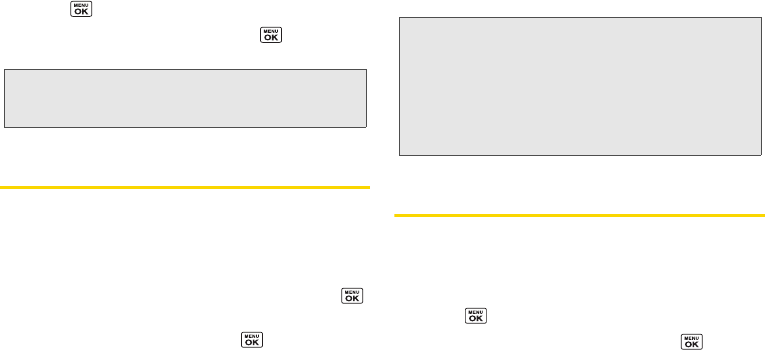
50 2D. Contacts
Displaying Contacts Details
1. From the Contacts list, highlight an entry and
press .
2. Highlight any data field and press . Menu
options for that field will appear, if applicable.
Adding a New Contacts Entry
1. From standby mode, press CONTACTS (right
softkey) > Add New... > New Contact.
2. Enter a name for the new entry and press the
navigation key down.
3. Enter the phone number for the entry and press .
4. Highlight a label for the entry (Mobile, Home, Work,
Pager, Fax, or Other) and press .
5. Add other information (email address, URL, street
address, etc.).
6. Press DONE (left softkey).
After you have saved the number, the new Contacts
entry is displayed.
Editing a Contacts Entry
1. Display a Contacts entry (see “Displaying Contacts
Entries” on page 49) and press OPTIONS (right
softkey) > Edit Contact.
2. Highlight the information you wish to edit and
press .
3. Add or edit the information and press .
4. Press DONE (left softkey) to save your changes.
Note: If you select a group in step 1, entries, phone numbers,
or email addresses belonging to the group are
displayed.
Tip: ICE – In Case of Emergency
To make it easier for emergency personnel to identify
important contacts, you can list your local emergency
contacts under “ICE” in your phone’s Contacts list. For
example, if your mother is your primary emergency
contact, list her as “ICE–Mom” in your Contacts list. To list
more than one emergency contact, use “ICE1–___,”
“ICE2–___,” etc.
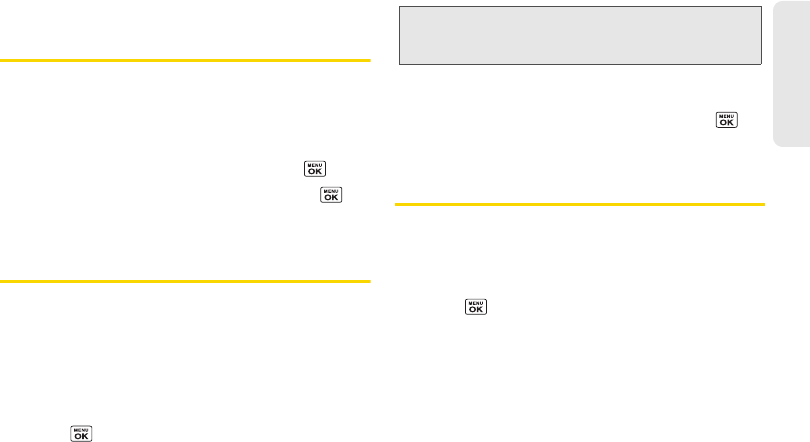
2D. Contacts 51
Contacts
Adding a Number to a Contacts
Entry
1. Display a Contacts entry. (See “Displaying
Contacts Entries” on page 49.)
2. Press OPTIONS (right softkey) > Edit Contact >
<Add Number>.
3. Enter the new phone number and press .
4. Highlight a label for the number and press .
5. Press DONE (left softkey) to save the new number.
Creating a Group
You can create a group by assigning Contacts entries
as members and then naming the new group.
1. From standby mode, press CONTACTS (right
softkey) > Add New... > New Group.
2. Read the message and press START (left softkey).
3. Highlight an entry you want to add to a group and
press . A check mark will appear in the box
next to the selected entry.
4. When you have selected all the entries you want to
add, press CONTINUE (left softkey).
5. Enter a name for the new group and press .
6. Press SAVE (left softkey).
Editing Groups
1. From the Contacts list, highlight the group you want to
edit.
2. Press OPTIONS (right softkey) > Edit Group.
3. Change the group name or the group icon and
press .
4. Press SAVE (left softkey).
Adding Members to a Group
1. From the Contacts list, highlight the group to which
you want to add members.
2. Press OPTIONS (right softkey) > Edit Group >
Add More.
Tip: Press OPTIONS (right softkey) > Enter New Address or
Recent History to enter a new phone number or
address or to select an entry from your history.
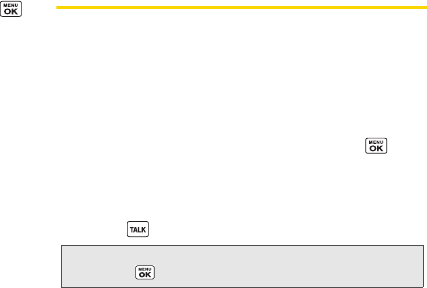
52 2D. Contacts
3. Read the message and press START (left softkey).
4. Highlight an entry you want to add and press .
5. Repeat step 4 to add additional members.
6. Press CONTINUE (left softkey) > SAVE (left softkey).
Removing Members From a Group
1. From the Contacts list, highlight the group from
which you want to remove members.
2. Press OPTIONS (right softkey) > Edit Group.
3. Highlight a member and press OPTIONS (right
softkey) > Remove from Group > YES (left softkey).
4. Repeat step 3 to remove additional members.
5. Press SAVE (left softkey).
Deleting a Contacts Entry or Group
1. From the Contacts list, highlight an entry or a
group you want to delete.
2. Press OPTIONS (right softkey) > Delete Contact or
Delete Group.
3. Press DELETE (left softkey) or YES (left softkey).
Finding Contacts Entries
1. From standby mode, press CONTACTS (right softkey).
2. Scroll through all the entries.
– or –
Enter the first few letters of an entry’s name.
Contacts with matching letters are listed. (The more
letters you enter, the more your search narrows.)
3. To display an entry, highlight it and press .
ⅢPress the navigation key left or right to display
other listed entries.
4. To dial the entry, highlight the phone number and
press .
Tip: You can also find a group the same way as above.
Press to display the members of the group.
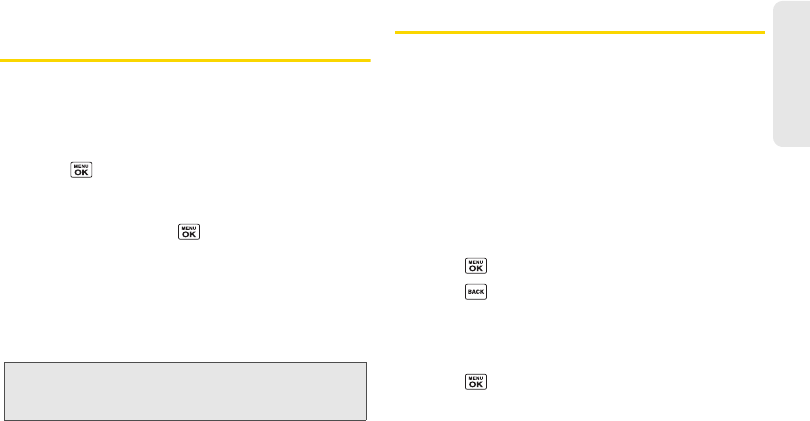
2D. Contacts 53
Contacts
Using Contacts Information in Other
Applications
You can use saved Contacts information in other
applications.
To copy information into a message:
1. From the Contacts list, highlight an entry and
press .
2. Highlight the information you want to copy, such as
phone numbers, email addresses, URLs, or street
addresses, and press .
3. Select Share.
4. Select Message.
After you select one or more recipients, the text entry
screen for the message will open, and the selected text
will appear in the body of the message.
Assigning Speed Dial Numbers
Your phone can store up to 98 phone numbers in
speed dial locations. (See “Speed Dialing” on
page 22.)
To assign a speed dial number to a new phone number:
1. Add a phone number to a new or to an existing
Contacts entry. (See “Adding a New Contacts
Entry” on page 50.)
2. Highlight the phone number and press OPTIONS
(right softkey) > Set Speed Dial.
3. Highlight an available speed dial location and
press .
4. Press to return to the Contacts menu.
To assign a speed dial number to an existing phone
number:
1. From the Contacts list, highlight an entry and
press .
2. Highlight a number and press OPTIONS (right
softkey) > Set Speed Dial.
Note: For more information about messaging, see
“Messaging” on page 86 and “Accessing Messages”
on page 97.
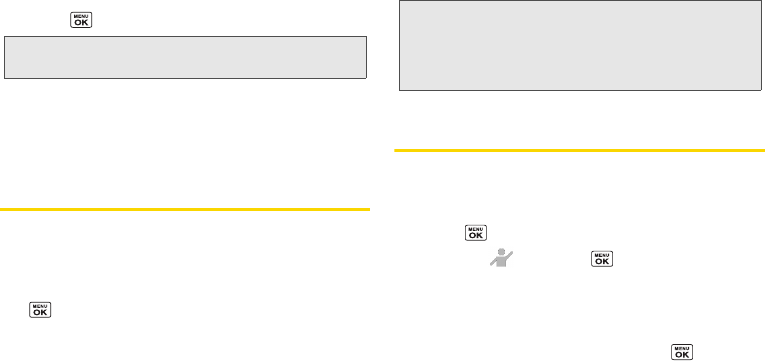
54 2D. Contacts
3. Highlight an available speed dial location and
press .
To check speed dial assignments:
ᮣFrom the Contacts list, press OPTIONS (right
softkey) > Settings > Speed Numbers.
Selecting a Ringer Type for an Entry
Assign a ringer type to a Contacts entry so that you can
identify the caller by the ringer type. (See “Ringer
Types” on page 32.)
1. From the Contacts list, highlight an entry and press
.
2. Select Set Ringers.
3. Select Incoming Calls or Message.
4. Select Change.
5. Select a ringer category, and then select a ringer.
Assigning a Picture to an Entry
Assign a picture to display each time a certain contact
calls you.
1. From the Contacts list, highlight an entry and
press .
2. Highlight and press .
3. Select Choose Photo.
4. Select a photo category by pressing the navigation
key up or down, and then select an image.
ⅢIf you select Take New Picture, press to take a
picture, and then press OK (left softkey) to assign it.
Tip: To replace a current assignment, select a location and
press REPLACE (left softkey).
Tip: If you select Downloaded > Get New in step 5, you can
purchase and download new ringers right from your
phone. For details, see “Getting New Ringers” on
page 32 and “Downloading Games, Ringers, and More”
on page 99.
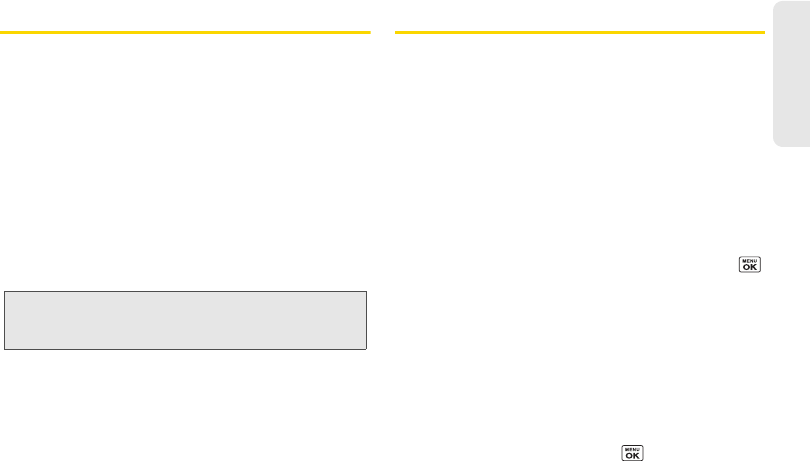
2D. Contacts 55
Contacts
Secret Contacts Entries
When you make an entry secret and hide it, that entry is
not displayed in your Contacts. In History, a telephone
number is displayed but the Contacts entry’s name is not.
To make an entry secret:
ᮣFrom the Contacts list, highlight an entry and press
OPTIONS (right softkey) > Set as Secret > On.
To hide or show secret entries:
1. From the Contacts list, press OPTIONS (right
softkey) > Settings > Hide Secret or Show Secret.
2. Enter the four-digit lock code, and then press
CONTINUE (left softkey).
My Name Card
In My Name Card, you can edit your contact
information to display when you need, as well as send
or exchange it via Bluetooth.
To display your name card:
ᮣFrom standby mode, press CONTACTS (right
softkey) > OPTIONS (right softkey) > Settings >
My Name Card.
To edit your name card:
1. From the My Name Card screen, press OPTIONS
(right softkey) > Edit.
2. Highlight each field you want to edit and press .
3. Edit the information. When finished, press DONE
(left softkey).
To send or exchange your name card via Bluetooth:
1. Make a Bluetooth connection with another device.
(See “2H. Bluetooth” on page 76.)
2. From the My Name Card screen, select OPTIONS
(right softkey) > Send Name Card or
Exchange Name Cards.
3. Highlight a device and press .
Tip: If you can’t recall your lock code, try using the last four
digits of your wireless phone number. If this doesn’t work,
call Sprint Customer Service at 1-888-211-4727.

56 2D. Contacts
Dialing Sprint Services
Your Contacts list is preprogrammed with contact
numbers for various Sprint services and other useful
services.
To dial a service from your Contacts:
1. From standby mode, press CONTACTS (right
softkey) > OPTIONS (right softkey) > Settings >
Services.
2. Select an available service, such as
Hear Minutes (Account Info.), Customer Solution
(Service), Directory Assistance (Sprint 411), or
Sprint Operator.
To dial a main service from standby mode using your
keypad:
ᮣDial the appropriate service number:
ⅢAccount Info. –
ⅢCustomer Service –
ⅢSprint 411 –
ⅢSprint Operator –

2E. Calendar & Tools 57
Calendar / Tools
ࡗCalendar (page 57)
ࡗAlarm (page 60)
ࡗCalculator (page 61)
ࡗWorld Clock (page 61)
ࡗCountdown Timer (page 61)
ࡗStopwatch (page 62)
Calendar
Adding an Event to the Calendar
Your Calendar helps organize your time and reminds
you of up to 100 important events.
1. Press > Tools > Calendar.
2. Highlight a day to which you would like to add an
event and press OPTIONS (right softkey) >
Add Schedule.
3. Enter a description and press .
4. Select a category for the event (Appointment,
Meeting, etc.) by highlighting the category field and
pressing .
5. Select a priority for the event by highlighting the
priority field and pressing .
6. Select a start and end time for the event by
highlighting the start and end time fields and
pressing .
7. Enter a location for the event and press .
8. Select a ringer type for the alarm by highlighting
the ringer field and pressing .
ⅢTo download ringers, select Downloaded >
Get New.
9. Select an alarm time by highlighting the alarm time
field and pressing .
2E. Calendar & Tools
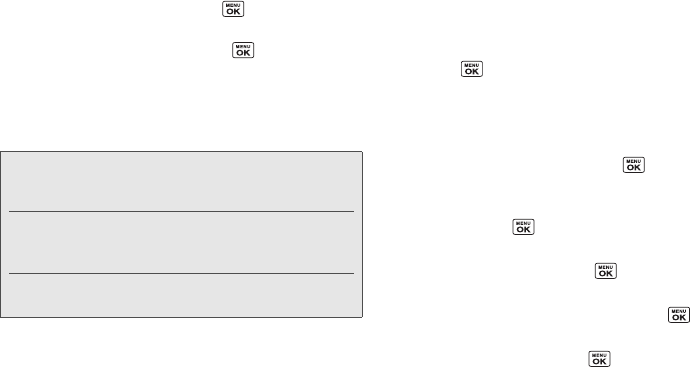
58 2E. Calendar & Tools
10. Select a repeat status for the alarm by highlighting
the repeat field and pressing .
ⅢIf you chose Specific Period, set a start and end
date for the repeat and press .
ⅢIf you chose Weekly, select the check box for each
day of week you wish to set and press DONE (left
softkey).
11. Press SAVE (left softkey).
Adding a To Do List Item to the Calendar
Your phone can store and manage up to 40 To Do list
items.
1. Press > Tools > Calendar.
2. Highlight a day to which you would like to add a To
Do list item and press OPTIONS (right softkey).
3. Press the navigation key right and select Add To Do.
4. Enter a description and press .
5. Select a category for the item (Appointment,
Meeting, etc.) by highlighting the category field
and pressing .
6. Select a priority for the item by highlighting the
priority field and pressing .
7. Select a time and date for the item by highlighting
the time and date field and pressing .
8. Select a status for the item by highlighting the
status field and pressing . When you add an
item, set it to Needs Action.
9. Press SAVE (left softkey).
Tip: To change the calendar display views, press the left
softkey repeatedly to toggle between MONTHLY and
WEEKLY views.
On the weekly view, press the navigation key up or down
to display the previous week or the next week,
respectively.
Press OPTIONS (right softkey) > Settings >
Holiday/Weekday to enter holidays and weekdays.
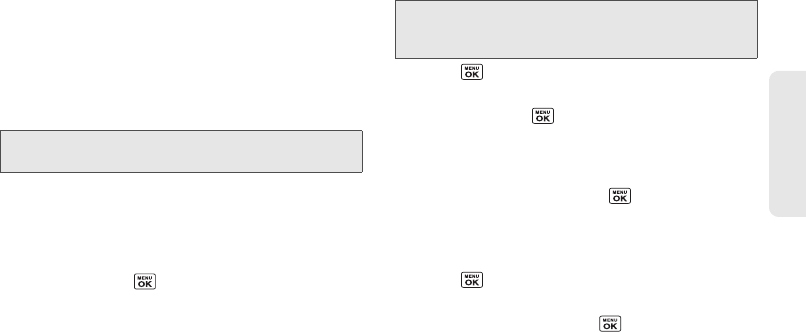
2E. Calendar & Tools 59
Calendar / Tools
Calendar Alerts
If you have an event on the Calendar, your phone alerts
you by a ringing or vibrating alarm and displays a
summary of the event.
To respond to the alarm:
ⅷPress SNOOZE (left softkey) to stop the alarm and
start snooze mode.
ⅷPress DISMISS (right softkey) to clear the alarm.
ⅷOn the notification screen, the description you have
entered for that event is displayed. If certain
information (such as an email address, street
address, phone number, or URL) is highlighted in the
description, press to display the related option
menus. (See page 26.)
ⅢIf the description includes multiple items of
information as described above, press the
navigation key up or down to highlight a specific
item.
Viewing Events
1. Press > Tools > Calendar.
2. Highlight the day for which you would like to view
events and press . The day’s event list is displayed.
– or –
Press OPTIONS (right softkey) > Schedule List or
To Do List.
3. Highlight an event and press . The event’s details
are displayed. You can edit the event on this screen.
Deleting Events
1. Press > Tools > Calendar.
2. Highlight the day from which you would like to
delete an event and press .
– or –
Press OPTIONS (right softkey) > Schedule List or
To Do List.
3. Highlight an event and press OPTIONS (right
softkey) > Delete.
Tip: To change the alarm settings, press OPTIONS (right
softkey) > Settings > Alarm to set the snooze options.
Tip: Days with scheduled events are indicated by small
colored rectangles just below the date. A rectangle’s color
depends on the repeat status for an event.

60 2E. Calendar & Tools
4. Highlight an option and press .
ⅢThis to delete the highlighted event.
ⅢSelect to delete multiple events.
ⅢAll on This List to delete all events on the list.
ⅢAll Completed Events to delete completed To Do
List items.
5. Press YES (left softkey).
To delete old or all events:
ᮣPress > Tools > Calendar > OPTIONS (right
softkey) > Delete Memory > Delete Old (or
Delete All) > YES (left softkey).
Alarm
Your phone comes with a built-in alarm that has
multiple alarm capabilities.
1. Press > Tools > Alarm.
2. Highlight an alarm number and press .
3. Turn the alarm on or off by highlighting the alarm
field and pressing .
ⅢHighlight On or Off and press .
4. Enter a description for the alarm by highlighting
the description field and pressing .
5. Select a time for the alarm by highlighting the time
field and pressing .
6. Select a repeat status for the alarm by highlighting
the repeat field and pressing .
7. Select a ringer option for the alarm between
Downloaded, Preloaded Ringers, and No Ringer by
highlighting the ringer field and pressing .
If you select Downloaded or Preloaded Ringers,
highlight a ringer type and press .
8. Select a volume level for the alarm by highlighting
the volume field and pressing .
9. Select a ringer length for the alarm by highlighting
the ringer length field and pressing .
10. Select a snooze interval for the alarm by
highlighting the snooze interval field and
pressing .
11. Select the number of times the snooze should
repeat by highlighting the snooze time field and
pressing .
12. Press SAVE (left softkey).
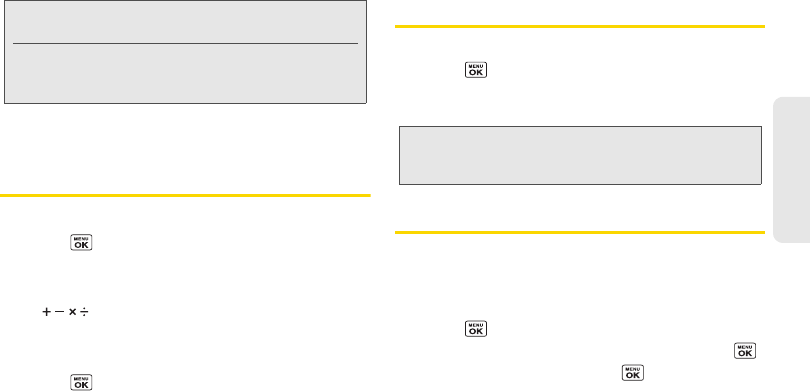
2E. Calendar & Tools 61
Calendar / Tools
See “To respond to the alarm:” on page 59 for ways to
stop, pause, or reset the alarm.
Calculator
Your phone comes with a built-in calculator.
1. Press > Tools > Calculator.
2. Enter numbers using your keypad.
ⅢPress the appropriate key for an arithmetic option
().
ⅢPress the left softkey to enter a decimal point.
ⅢPress CLEAR (right softkey) to clear all numbers.
3. Press for the total.
World Clock
To view the time in different locations:
1. Press > Tools > World Clock.
2. Press the navigation key left or right to scroll
through different time zones.
Countdown Timer
This feature allows you to use your phone as a
countdown timer to alert you when a specified period
of time has elapsed. You can set up to five timers for a
maximum time of 59 minutes, 59 seconds each.
1. Press > Tools > Countdown.
2. Highlight a countdown timer number and press .
3. Highlight a setting and press .
ⅢTime to enter the length of the countdown as a
four-digit number. (For example, to set the timer
to 20 minutes, enter “2000” on your keypad.)
ⅢAlarm to set the countdown alarm to on or off.
Tip: Press ON or OFF (left softkey) to toggle the alarm on and
off.
In steps 5 and 9, use your keypad or navigation key (up
or down to change value, left or right to move
underscore) to set a time.
Note: Press SUMMER (left softkey) or STANDARD (right
softkey) to change between daylight saving and
standard time.
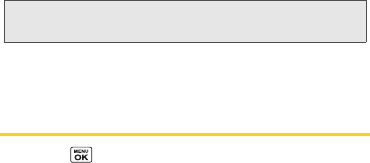
62 2E. Calendar & Tools
4. Press SAVE (left softkey).
See “To respond to the alarm:” on page 59 for ways to
stop, pause, or reset the alarm.
Stopwatch
1. Press > Tools > Stopwatch.
2. Press MODE (left softkey) to select split timing or
lap timing.
3. Press START (right softkey) to start the stopwatch.
4. Press SPLIT or LAP (left softkey) to record the time.
5. Press STOP (right softkey) to stop timing.
6. Press RESET (left softkey) to reset the stopwatch to
zero.
Tip: Press ON or OFF (left softkey) to toggle the countdown
alarm on and off.
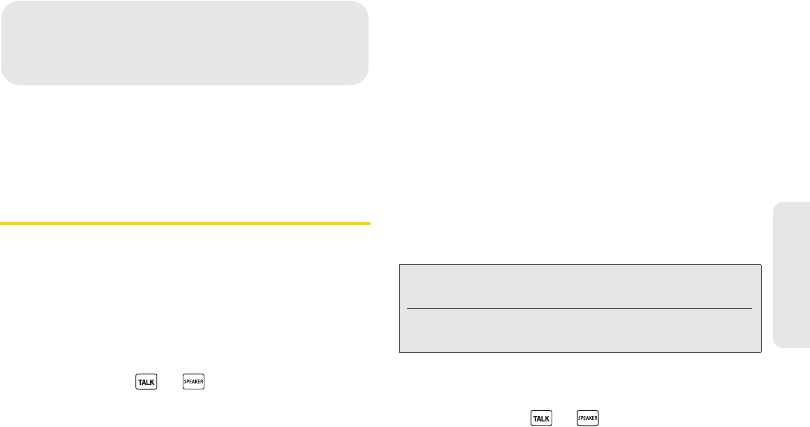
2F. Voice Services 63
Voice Services
ࡗAutomatic Speech Recognition (ASR) (page 63)
ࡗManaging Voice Memos (page 66)
Automatic Speech Recognition
(ASR)
You can use your phone’s built-in automatic speech
recognition (ASR) software to dial a phone number or
to launch phone functions. All you have to do is to talk
into the phone, and ASR will recognize your voice and
complete tasks by itself.
Activating ASR
ᮣPress and hold or .
The phone prompts you to say the name of the
command you want to use. To complete your task,
simply follow the voice prompts.
Available ASR commands include:
ⅷCall <Name or #> to call an entry in your Contacts
list or a spoken phone number. (See the next article
for details.)
ⅷSend Message <Name or #> to send a message to
an entry in your Contacts list or to a spoken phone
number. (See page 64 for details.)
ⅷLookup <Name> to display the detail screen of an
entry in your Contacts list. (See page 64 for details.)
ⅷGo To <Menu> to jump directly to menu items or
applications. (See page 64 for details.)
ⅷCheck <Item> to check your phone’s status. (See
page 65 for details.)
Making a Voice Call Using ASR
1. Press and hold or .
2. When you hear “Say a command,” say “Call.”
2F. Voice Services
Tip: Use ASR in a quiet environment so it can accurately
recognize your commands.
During ASR operation, press HELP (left softkey) to get
instructions for using the software.
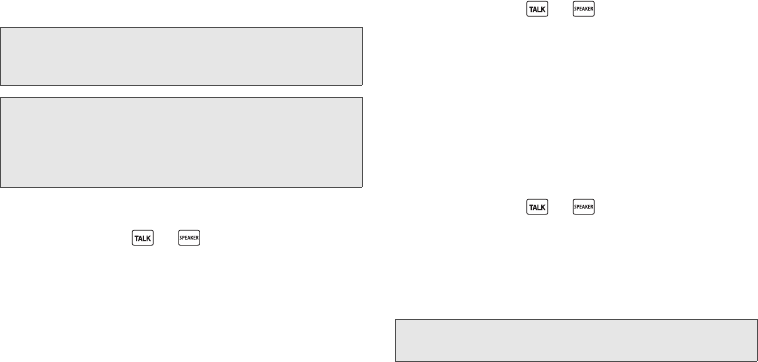
64 2F. Voice Services
3. When you hear “Say the name or number,” say a
name or a phone number.
4. When you hear “Which location?,” say a number
type (for example, “Mobile”).
Sending a Message Using ASR
1. Press and hold or .
2. When you hear “Say a command,” say
“Send Message.”
3. When you hear “Say the name or number,” say a
name or a phone number.
4. When you hear “Which location?,” say a number
type (for example, “Mobile”). The phone displays
the text entry screen. (See page 87 for how to
compose a message.)
Displaying a Contacts Entry’s Information
Using ASR
1. Press and hold or .
2. When you hear “Say a command,” say “Lookup.”
3. When you hear “Say the name,” say a Contact
entry’s name. The phone displays the detail screen
for that Contacts entry.
Opening Menus Using ASR
You can jump directly to many menu items or
applications by saying “Go to” followed by a menu option.
1. Press and hold or .
2. When you hear “Say a command,” say “Go To.”
3. When you hear “Which shortcut?,” say an
application name (for example, “Messaging”).
4. The phone opens the selected menu.
Tip: You can skip steps 3 and 4 by saying a name and
location after “Call” without pausing (for example,
“Call John Jones mobile”).
Note: If ASR does not recognize the name or number, it will find
the most likely matches and display a list of up to three
names or numbers. You will hear “Did you say Call…”
followed by the name or number. You can confirm by
saying “Yes.” Say “No” to change the selection.
Tip: Say “More options” to display additional application
names.
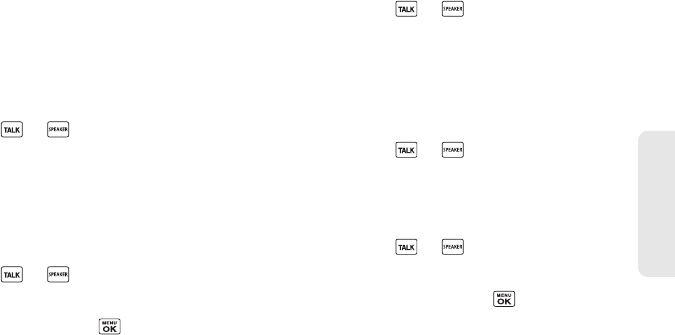
2F. Voice Services 65
Voice Services
Checking Phone Status Using ASR
You can use ASR to obtain information about your phone:
ⅷStatus (all of the following except My Phone Number)
ⅷTime
ⅷSignal Strength
ⅷNetwork
ⅷBattery
ⅷMy Phone Number
1. Press and hold or .
2. When you hear “Say a command,” say “Check.”
3. When you hear “Which status item?,” say a command.
ASR Settings
To change ASR confirmation:
1. Press and hold or .
2. Press SETTINGS (right softkey) > Confirmation.
3. Highlight an option and press .
ⅢAutomatic to ask for confirmation only when the
system is not sure what you said.
ⅢAlways Confirm to always ask for confirmation.
ⅢNever Confirm to never ask for confirmation.
To adapt the system to your voice:
1. Press and hold or .
2. Press SETTINGS (right softkey) > Adaptation >
Adapt Voice.
3. Press START (left softkey) and repeat each word,
phrase, or telephone number you hear.
To reset the adaptation:
1. Press and hold or .
2. Press SETTINGS (right softkey) > Adaptation >
Reset Voice > YES (left softkey).
To change the ASR mode:
1. Press and hold or .
2. Press SETTINGS (right softkey) > Audio Modes.
3. Highlight an option and press .
ⅢExpert Mode to sound a beep only.
ⅢPrompt Mode to prompt for required information.
ⅢReadout Mode to prompt for required information
and to read the text displayed on the main screen.
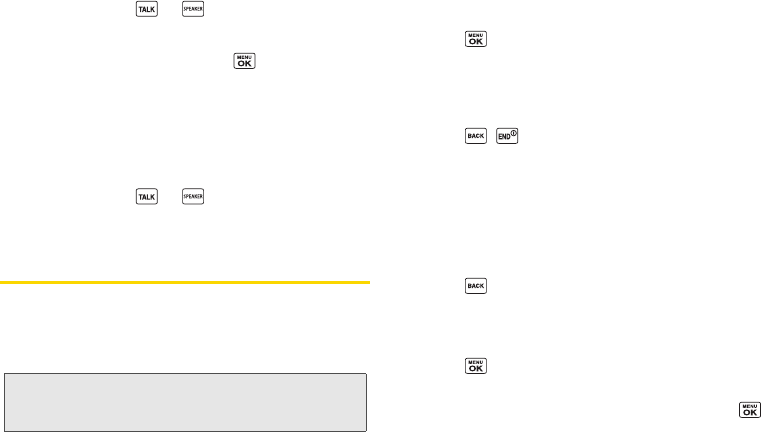
66 2F. Voice Services
To change the ASR dialing region:
1. Press and hold or .
2. Press SETTINGS (right softkey) > Dialing Region.
3. Highlight an option and press .
ⅢNorth America to recognize only numbers valid in
North America.
ⅢOther to recognize any number regardless of
location.
To display the ASR software version:
1. Press and hold or .
2. Press SETTINGS (right softkey) > About.
Managing Voice Memos
Use your phone’s Voice Memo to record audio memos
to remind you of important events, phone numbers, or
grocery list items, and to record call memos of the other
party’s voice during a phone call.
Recording Memos
To record an audio memo:
1. Press > Tools > Voice Services > Voice Memo >
Record.
2. Start recording after the beep.
To stop recording:
ᮣPress , , or STOP (right softkey).
To record a call memo:
1. During a call, press OPTIONS (right softkey) >
Voice Memo.
2. Start recording after the beep.
To stop recording:
ᮣPress or STOP (right softkey). (Recording will
also stop when the other party disconnects.)
Playing Recorded Memos
1. Press > Tools > Voice Services > Voice Memo >
List.
2. Highlight the memo you want to play and press .
– or –
Note: You can store up to 1900 memos on your phone.
Maximum recording time depends on the available
memory space on your phone.

2F. Voice Services 67
Voice Services
Press OPTIONS (right softkey) > Play > All to play all
memos continuously.
To play multiple memos:
1. Press > Tools > Voice Services > Voice Memo >
List.
2. Press OPTIONS (right softkey) > Play > Multiple and
select memos you want to play.
3. Press PLAY (left softkey).
To select the playing mode (speed and direction) using the
navigation key:
ⅷPress the navigation key up or down to select the
playing speed (1/2x, 2/3x, 1x, 1.5x, or 2x).
ⅷPress the navigation key left or right to move between
memos and start playing.
ⅷPress and hold the navigation key left or right to
fast-rewind and fast-forward.
Recorded Memos Options
Your phone offers several options for managing audio
and call memos you have recorded.
1. Press > Tools > Voice Services > Voice Memo >
List.
2. Highlight a memo and press OPTIONS (right
softkey) to display available menu options:
ⅢPlay to play selected memos or all memos.
ⅢSpeaker On or Speaker Off to activate or
deactivate the speakerphone mode.
ⅢEdit Title to edit the title of a memo.
ⅢProperties to display information about a memo.
ⅢType Filter to list memos by the type order as
audio memo, call memo, or all memos.
ⅢSort by to sort memos by the recorded time, file
name or size in ascending or descending order.
ⅢGo to Time to set the point from which the memo
starts playing.
ⅢSend Media to send a memo by attaching it to a
message.
ⅢDelete to delete either selected memos or all
memos. Select from This, Multiple, or All.
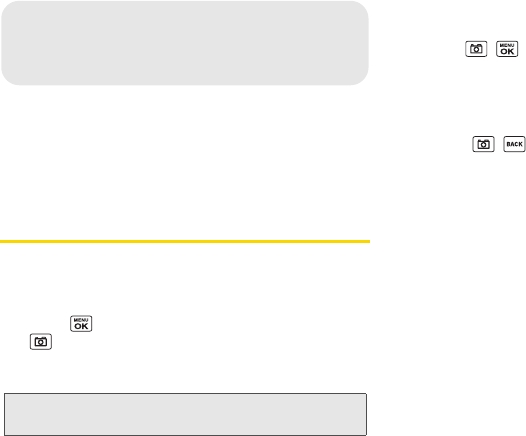
68 2G. Camera
ࡗTaking Pictures (page 68)
ࡗStoring Pictures (page 72)
ࡗSending Pictures From Your Phone (page 73)
ࡗPrinting Pictures From Your Phone (page 74)
Taking Pictures
Taking pictures with your phone’s built-in camera is as
simple as choosing a subject, pointing the lens, and
pressing a button.
1. Press > Photos > Camera or press and hold
to activate camera mode. (Additional camera
options are available. See “Camera Mode Options”
on page 69 for more information.)
2. Using the phone’s main screen as a viewfinder,
aim the camera lens at your subject.
3. Press , , or CAPTURE (left softkey) until the
shutter sounds. The picture will automatically be
saved in the My Photos folder. (See “Storing
Pictures” on page 72.)
ⅢTo return to camera mode to take another picture,
press , , or
CAMERA (left softkey).
4. Press OPTIONS (right softkey) for more options.
ⅢSend Message to send your picture in a message.
(See “Sending Pictures Using the Messaging
Feature” on page 73.)
ⅢAssign to assign the picture. (See “Assigning
Pictures” on page 69.)
ⅢDelete to delete the picture you just took.
ⅢPrint to print the picture. You can choose whether
to print using a PictBridge- or Bluetooth- enabled
printer.
ⅢReview Media to go to the My Photos folder to
review your saved pictures.
ⅢDetails/Edit to edit or display details relating to
your pictures.
Note: If Parental Controls is on and the camera is restricted,
you cannot activate camera mode. (See page 41.)
2G. Camera

2G. Camera 69
Camera
Assigning Pictures
Assign a picture as a screen saver or as a picture ID.
1. Take a picture. (See steps 1–3 on page 68.)
2. With the picture displayed, press OPTIONS (right
softkey) > Assign, and select an option.
ⅢPicture ID to assign the picture to a Contacts entry
as well as to unsaved phone numbers, or to private
and unknown phone numbers. See “Selecting a
Picture ID” on page 29.
ⅢScreensaver to assign the picture as a screen
saver.
Camera Mode Options
Press OPTIONS (right softkey) in camera mode to
display additional camera options:
ⅷPicture Mode to select a picture mode from Normal,
Beach/Snow, Scenery, Mirror Image, or Night/Dark.
ⅷZoom to zoom in and out on a subject. (See “Zoom”
on page 70.)
ⅷSelf-Timer to activate the camera’s timer. (See
“Self-timer” on page 70.)
ⅷFun Tools to select an option from the following:
ⅢMultiple Shots to take multiple shots. (See
“Multiple Shots” on page 70.)
ⅢFun Frames to select your favorite fun picture
frame to decorate your picture (displayed only
when the resolution setting is 0.3M or 0.1M).
ⅢColor Tone to select from a wide variety of color
tones for the picture.
ⅷImage Controls to adjust settings for Brightness,
White Balance, Sharpness, and Contrast.
ⅷCameraSettings to adjust Resolution, Quality, and
other settings. (See “Camera Settings” on page 71.)
ⅷReview Media to go to the My Photos folder to review
your saved pictures.
ⅷKey Guidance to show keypad shortcuts in camera
mode.
ⅷUser Settings to provide convenient access to your
favorite settings. (See “Saving Your Settings” on
page 71.)
Tip: You can also assign pictures from the My Photos menu.
See “My Photos Folder Options” on page 72.
You can view pictures assigned as picture IDs or screen
savers by pressing > Tools > Assigned Media.
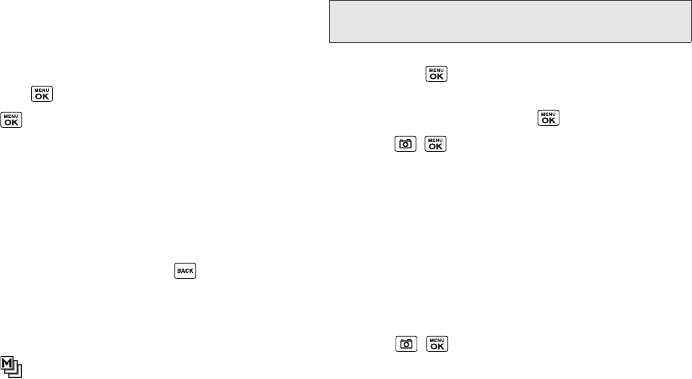
70 2G. Camera
Self-timer
1. From camera mode, press OPTIONS (right softkey) >
Self-Timer.
2. Highlight a delay time (5 Seconds or 10 Seconds)
and press .
3. Press or START (left softkey) when you are
ready to start the timer. (A countdown is displayed
in the middle of the screen and your phone will
beep during the countdown.)
4. Get ready for the picture. (When the timer is down
to three seconds, the tone of the beep will change.)
To cancel the self-timer after it has started:
ᮣPress CANCEL (right softkey) or .
Multiple Shots
This feature allows you to take three, six, or nine shots
in a continuous sequence. When you take multiple
shots, the icon will be displayed in the viewfinder.
1. From camera mode, press OPTIONS (right softkey) >
Fun Tools > Multiple Shots.
2. Highlight an option (3 Shots, 6 Shots, or 9 Shots)
and press .
3. Highlight the duration of the interval between shots
(Normal or Fast) and press .
4. Press , , or CAPTURE (left softkey) to take the
pictures. (The screen will display up to nine
thumbnail pictures.)
Zoom
This feature allows you to zoom in on an object when
you take a picture. You can adjust the zoom from 1x
to 12x.
1. From camera mode, press the navigation key right
to zoom in or left to zoom out.
2. Press , , or CAPTURE (left softkey) to take a
picture.
Note: When taking multiple shots, the resolution is temporarily
set to 0.1M (240x320).
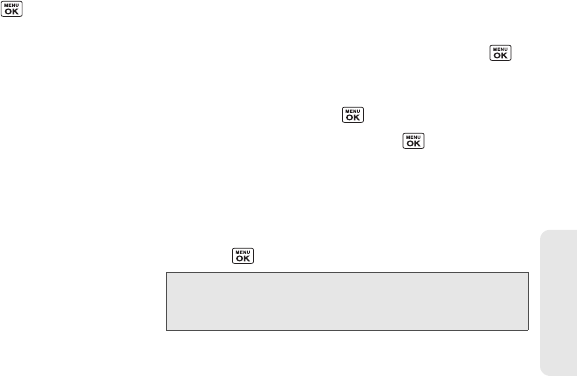
2G. Camera 71
Camera
Camera Settings
1. From camera mode, press OPTIONS (right softkey) >
CameraSettings.
2. Highlight an option and press .
ⅢResolution to select a picture’s file size
from 1.3M (960x1280), 0.3M (480x640),
or 0.1M (240x320).
ⅢQuality to select the picture quality setting from
Fine, Normal, or Economy.
ⅢShutter Sound to select a shutter sound from
Default, “Say Cheese”, “Ready”, or Off.
ⅢStatus Bar to display or hide status indicators and
softkeys. These can be displayed or hidden by
pressing the navigation key up or down.
Saving Your Settings
You can save your favorite camera mode options as
your preferred settings.
1. Set your favorite camera mode options and press
OPTIONS (right softkey) > User Settings.
2. Highlight an unassigned number and press >
YES (left softkey). (Default keeps the original
settings.)
3. Enter a title and press .
4. Confirm the settings and press .
To retrieve your settings:
1. From camera mode, press OPTIONS (right softkey) >
User Settings.
2. Highlight a customized settings group and
press
> YES (left softkey).
Note: To replace settings, highlight a customized settings group
and press OPTIONS (right softkey) > Overwrite > YES
(left softkey).
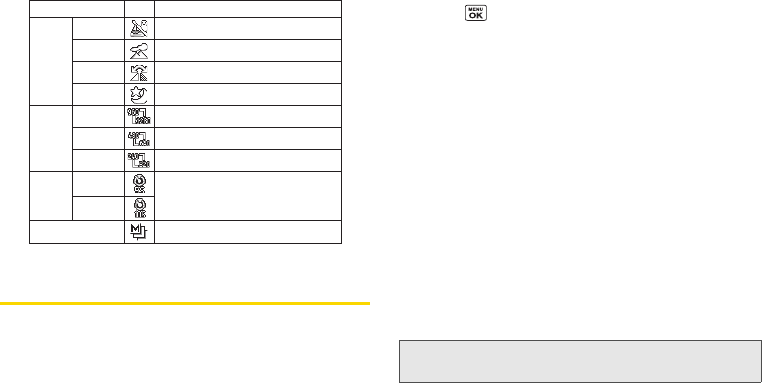
72 2G. Camera
Camera Icons
Storing Pictures
My Photos Folder
Your phone’s internal storage area is called the
My Photos folder. From the My Photos folder, you can
view all the pictures you have stored there, delete files,
and access additional options.
To review your stored pictures in the My Photos folder:
ᮣPress > Photos > My Photos.
My Photos Folder Options
When you are viewing the My Photos folder, press
SEND MESSAGE (left softkey) to send your pictures (see
“Sending Pictures Using the Messaging Feature” on
page 73); or press OPTIONS (right softkey) to display
the following options:
ⅷSelect Multiple to select multiple pictures.
ⅷSlideshow to view your pictures in slideshow mode
(only available when you save two or more pictures
to the folder).
ⅷAssign to assign the picture. (See “Assigning
Pictures” on page 69.)
ⅷDelete to delete pictures. Select This, Selected, or All.
ⅷPrint to print pictures. You can choose whether to print
using a PictBridge- or Bluetooth-enabled printer.
Function
Picture
Mode
Use this setting in bright light.
Use this setting for scenery at a distance.
Use this setting to take a mirror image.
Use this setting in low light.
Beach/Snow
Scenery
Mirror Image
Night/Dark
1.3M
0.3M
0.1M
Icon Details
Self-Timer
Numeric countdown will appear when the
self-timer has been started.
Multiple Shots Use this setting for multiple shots.
Resolution
For 1.3-megapixel picture resolution.
For 0.3-megapixel picture resolution.
For 0.1-megapixel picture resolution.
5 Seconds
10 Seconds
Note: Deleting pictures will free up memory space in your
phone to enable you to take more pictures.

2G. Camera 73
Camera
ⅷDetails/Edit to edit or display details relating to your
pictures.
ⅢText Caption to edit the selected picture’s caption.
ⅢSpecial Effects to select from Fun Frames,
Color Tone, Fun Stamps, or Rotate.
ⅢResize to resize the selected picture.
Select 0.3M (480x640) or 0.1M (240x320).
ⅢTrimming to crop the selected picture.
ⅢPhoto Info to display information such as the
picture’s caption, time/date, and size.
ⅢFull Screen to display the selected picture in full
screen view.
Reviewing Pictures in Assigned Media
Folder
The Assigned Media folder automatically stores copies
of pictures assigned as picture IDs or screen savers on
your phone. (See “Assigning Pictures” on page 69.)
1. Press > Tools > Assigned Media.
2. Use your navigation key to view and scroll through
the pictures. (To switch a picture from thumbnail
view to expand view mode, highlight a picture and
press .)
Sending Pictures From Your Phone
Once you have taken a picture, you can use the
messaging capabilities of your phone to instantly share
it with family and friends as an attachment.
Sending Pictures Using the Messaging
Feature
1. Press > Photos > My Photos.
2. Highlight a picture to send and press
SEND MESSAGE (left softkey).
ⅢPress OPTIONS (right softkey) > Select Multiple to
select multiple pictures.
3. Select the recipient from the list or from the
following options:
ⅢGo to Contacts to select a recipient from your
Contacts. (Qualifying Contacts entries must contain
a wireless phone number or an email address.)
ⅢMULTIPLE (left softkey) to select multiple
recipients. Press CONTINUE (left softkey) when
you have finished selecting recipients. (You may
include up to 40 recipients per message.)
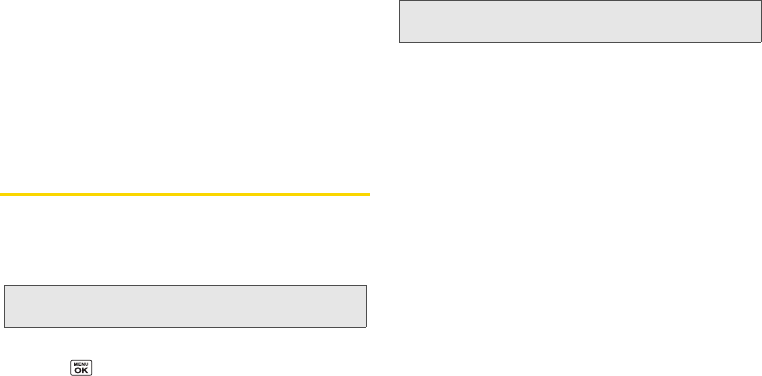
74 2G . Ca m e r a
ⅢNEW ADDRESS (right softkey) to enter a recipient’s
wireless phone number or email address directly.
Press CONTINUE (left softkey) to proceed.
4. Compose a message.
5. Confirm the recipients, message, and pictures.
(You may also select additional options by
pressing the right softkey. Follow the onscreen
instructions to add available options.)
6. Press SEND (left softkey) to send the pictures.
Printing Pictures From Your Phone
Your phone is PictBridge compatible, allowing you to print
directly from your phone without connecting to a
computer. You can also print your pictures using Bluetooth
(see “Printing Pictures via Bluetooth” on page 80).
To print pictures directly from your phone:
1. Press > Photos > My Photos.
2. Highlight a picture to print and press OPTIONS
(right softkey) > Print > PictBridge.
ⅢPress OPTIONS (right softkey) > Select Multiple to
select multiple pictures.
3. Connect your phone to the PictBridge-enabled
printer using a compatible USB cable. When the
printer has connected, press CONTINUE (left
softkey) in the picture thumbnail screen.
4. To set the print settings, highlight each element and
select a setting using your navigation key right or left.
ⅢType: You can select the print mode from
Default Printer, Standard Print, or Index Print.
ⅢCopies: You can set the number of copies from
Single, Doubles, or Manual. When you select
Manual, set the number (up to 10 per picture) by
pressing your navigation key right or left. The number
of copies will be displayed in the field below.
ⅢSize: You can set the print size from
Default Printer, 4"x6", 5"x7", 8"x10", or Letter.
(Print sizes may vary according to the type of
printer you have.)
ⅢDate: You can imprint the date on your pictures.
Select On or Off. (Date stamping may not be
available depending on the type of printer you have.)
Note: Make sure your battery is fully charged before printing
your pictures.
Note: You may not be able to print pictures that you cannot
display on your phone.

2G. Camera 75
Camera
5. When you have finished selecting the print
settings, press PRINT (left softkey).
6. When printing is finished, press .
7. Press YES (left softkey). Follow the instructions on the
display to unplug the USB cable from the phone.
Note: While you are connected to the printer, your phone’s
screen will display “Phone Off.” You cannot make or
receive calls during this time.
Note: PictBridge Error Messages –
From time to time you may encounter printing
problems. Your phone will display any printer error
messages informing you of the specific problems
encountered. Please refer to the user’s guide that came
with your printer for descriptions, explanations, and
possible resolutions for any error messages.

76 2H. Bluetooth
ࡗAbout Bluetooth (page 76)
ࡗTurning Bluetooth On and Off (page 76)
ࡗMaking Your Phone Discoverable (page 76)
ࡗBluetooth Menu (page 77)
ࡗPairing Bluetooth Devices (page 78)
ࡗViewing the Trusted Devices List (page 78)
ࡗSending Data via Bluetooth (page 79)
ࡗPrinting Pictures via Bluetooth (page 80)
About Bluetooth
Bluetooth® is a short-range communications
technology that allows you to connect wirelessly to a
number of Bluetooth devices, such as headsets and
hands-free car kits, and Bluetooth-enabled handhelds,
computers, printers, and wireless phones. The
Bluetooth communication range is usually up to
approximately 30 feet.
Turning Bluetooth On and Off
By default, your phone’s Bluetooth feature is turned off.
Turning Bluetooth on enables your phone’s Bluetooth
functions.
1. Press > Tools > Bluetooth > On/Off.
2. Press ON (left softkey) to enable Bluetooth. Press
OFF (left softkey) to disable Bluetooth.
Making Your Phone Discoverable
To make your phone discoverable (allowing other
Bluetooth devices to detect it), you must set your
phone’s visibility to other than Hidden.
1. Press > Tools > Bluetooth > Visibility.
2H. Bluetooth
Note: The first time you access the Visibility menu, you will be
advised to enable Bluetooth by pressing ON (left
softkey). On the next screen, you can customize the
device name by overwriting it and pressing SAVE (left
softkey).

2H. Bluetooth 77
Bluetooth
2. Select Visible for 3 min or Always visible. If you select
Always visible, your phone will be discoverable by
all in-range Bluetooth devices until you change the
setting. If you select Visible for 3 min, your phone will
return to hidden mode after three minutes.
Bluetooth Status Indicators
The following icons show your Bluetooth connection
status at a glance:
– Bluetooth feature is on.
– Your phone is visible to other Bluetooth devices.
– Your phone is connected to a Bluetooth device.
The above icons will blink while your phone is
communicating with a Bluetooth device.
Bluetooth Menu
The Bluetooth menu allows you to set up many of the
characteristics of your phone’s Bluetooth service, including:
ⅷSetting your phone’s visibility (or “discoverability”) for
other Bluetooth devices.
ⅷAdding a new Bluetooth device to your phone.
ⅷDisplaying your Bluetooth trusted devices list.
ⅷDisplaying your phone’s Bluetooth information.
To access the Bluetooth menu:
ᮣPress > Tools > Bluetooth to select from the
following options:
ⅢOn/Off to turn Bluetooth functions on or off. When
On is selected, your phone can receive requests
from other Bluetooth devices. (See page 76.)
ⅢVisibility to set your phone’s visibility (or
“discoverability”) for other Bluetooth devices. (See
page 76.)
ⅢAdd New to add a new Bluetooth device. (See
page 78.)
ⅢTrusted Devices to display a list of your trusted
Bluetooth devices. (See page 78.)
●Select Add New to add a new Bluetooth
device.
ⅢMy Bluetooth Info to display the name, address,
class, and supported profiles of your phone.

78 2H. Bluetooth
Pairing Bluetooth Devices
The Bluetooth pairing process allows you to establish
trusted connections between your phone and another
Bluetooth device. When devices are paired, a passkey
(PIN) is shared between devices, allowing for fast,
secure connections while bypassing the discovery and
authentication process.
1. From the Bluetooth menu, select Add New.
2. Select the device you wish to pair with and
press .
3. Enter the passkey and press .
4. (Optional) Edit the device name and press SAVE
(left softkey).
Viewing the Trusted Devices List
This list displays a list of devices which are paired with
your device and set as trusted devices.
ᮣFrom the Bluetooth menu, select Trusted Devices.
Trusted Devices List Menu
Once you have created trusted devices, several options
are available from the Trusted Devices list.
Left Softkey Menus
ᮣFrom the Trusted Devices list, highlight a device, and
press the left softkey menu item which appears
depending on the type of device highlighted.
ⅢCONNECT to connect to the selected Bluetooth
device, if not connected (for headsets, hands-free
and other devices, excluding computers, PDAs,
phones, or printers).
ⅢTRANSFER... to send data saved on your phone to
the selected Bluetooth device (for computers,
PDAs, or phones). (See page 79.)
ⅢPRINT to print data using the selected Bluetooth-
enabled printer. (See page 80.)
Note: Due to different specifications and features of other
Bluetooth compatible devices, display and operations
may be different, and functions such as transfer or
exchange may not be possible.

2H. Bluetooth 79
Bluetooth
Options Menu
ᮣFrom the Trusted Devices list, highlight a device,
and press OPTIONS (right softkey) to display the
following options:
ⅢAdd New to add a new Bluetooth device. (See
page 78.)
ⅢDelete to delete the selected device from the list.
ⅢDelete All to delete all devices from the list.
ⅢAuto-Accept to configure your phone’s
accessibility to other Bluetooth devices.
ⅢView/Edit Info to view or edit the information of the
selected device.
ⅢHelp to display the Trusted Devices list help.
Sending Data via Bluetooth
You can send Contacts data and Name Cards to or
exchange Name Cards with another Bluetooth device,
such as a computer, PDA, or phone.
Sending Contacts
1. From the Bluetooth menu, select Trusted Devices,
and select a device (computer, PDA, or phone)
from the list.
2. Press TRANSFER... (left softkey) > Send Contacts.
3. Select an option:
ⅢSend All Contacts to send all the entries in your
Contacts.
ⅢSelect Contacts to send selected entries. After you
have selected entries by checking the box next to
each entry, press CONTINUE (left softkey).
4. Read the message and press SEND (left softkey).
Sending or Exchanging Name Cards
(For more information about Name Cards, please see
page 55.)
1. From the Bluetooth menu, select Trusted Devices,
and select a device (computer, PDA, or phone)
from the list.
2. Press TRANSFER... (left softkey) > Send Name Card
or Exchange Name Cards.
3. Press SEND (left softkey).

80 2H. Bluetooth
Printing Pictures via Bluetooth
You can print out your pictures stored on your phone.
(Some Bluetooth-enabled printers may not support this
feature.)
1. From the Bluetooth menu, select Trusted Devices,
and select a printer from the list.
2. Press PRINT (left softkey).
3. Select the check box for each picture you wish to
print and press CONTINUE (left softkey).
– or –
1. Press > Photos > My Photos.
2. Highlight a picture to print and press OPTIONS
(right softkey) > Print > Bluetooth.
ⅢPress OPTIONS (right softkey) > Select Multiple to
select multiple pictures.
3. Select a printer.
4. To set the print settings, highlight each element
and select a setting using your navigation key right
or left.
ⅢType: You can select the print mode from Prints or
Index.
ⅢCopies: You can set the number of copies from
Single, Doubles, or Manual. When you select
Manual, set the number (up to 99 per picture) by
pressing your navigation key right or left. The
number of copies will be displayed in the field
below.
ⅢSize: You can set the print size from 4"x6", 5"x7",
or Letter. (Print sizes may vary according to the
type of printer you have.)
ⅢDate: You can imprint the date on your pictures.
Select On or Off. (Date stamping may not be
available depending on the type of printer you
have.)
ⅢBorder: You can choose whether to print the
pictures with or without border. Select On or Off.
ⅢCaption: You can choose whether to print the
pictures with or without text captions such as the
date captured (if available) and serial numbers.
Select On or Off.
Note: You may not be able to print pictures that you cannot
display on your phone.
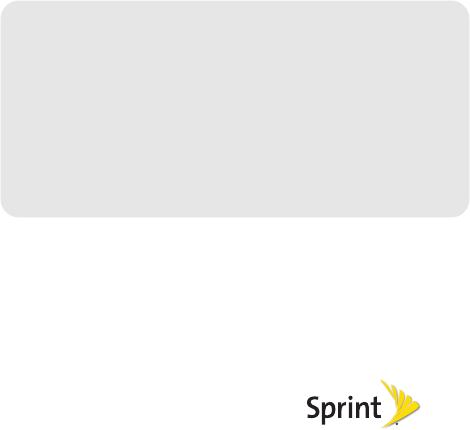
Section 3
Sprint Service

84 3A. Sprint Service: The Basics
ࡗVoicemail (page 84)
ࡗMessaging (page 86)
ࡗCaller ID (page 89)
ࡗCall Waiting (page 90)
ࡗMaking a 3-Way Call (page 90)
ࡗCall Forwarding (page 91)
ࡗRoaming (page 91)
Voicemail
Setting Up Your Voicemail
Your phone automatically transfers all unanswered
calls to your voicemail, even if your phone is in use or
turned off. You should set up your Sprint Voicemail and
personal greeting as soon as your phone is activated.
Always use a password to protect against unauthorized
access.
1. From standby mode, press and hold .
2. Follow the system prompts to:
ⅢCreate your password.
ⅢRecord your name announcement.
ⅢRecord your greeting.
Voicemail Notification
There are several ways your phone alerts you to a new
message:
ⅷBy displaying a message on the screen.
ⅷBy sounding the assigned ringer type.
ⅷBy displaying at the top of the screen.
3A. Sprint Service:
The Basics
Note: Voicemail Password
Sprint strongly recommends that you create a
password when setting up your voicemail to protect
against unauthorized access. Without a password,
anyone who has access to your phone is able to
access your voicemail messages.
If Parental Controls is on and Voice Calls are restricted,
you cannot call Sprint Voicemail unless you have
established your own number as an allowed Contacts
entry. (See page 41.)
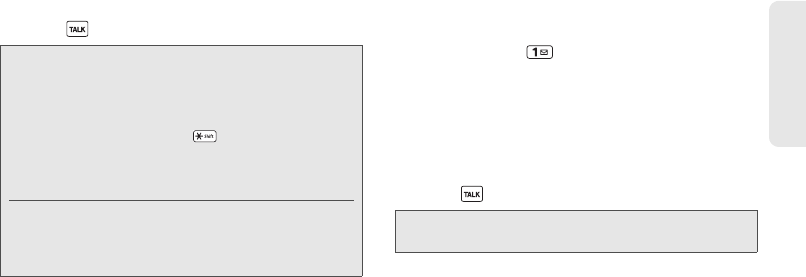
3A. Sprint Service: The Basics 85
Sprint Service
New Voicemail Message Alerts
When you receive a new voicemail message, your
phone alerts you and prompts you to call your
voicemail.
To call your voicemail from the notification screen:
ᮣPress .
Retrieving Your Voicemail Messages
You can review your messages directly from your
wireless phone or from any other touch-tone phone.
To dial from your wireless phone, either speed dial your
voicemail or use the menu keys.
Using One-Touch Message Access
ᮣPress and hold . (Your phone will dial your
voicemail box.)
Using the Menu Keys on Your Phone to Access
Your Messages
1. From standby mode, press MESSAGING (left
softkey) > Voicemail.
2. Press to listen to your messages.
Note: When you are roaming off the Nationwide Sprint
Network, you may not receive notification of new
voicemail messages. It is recommended that you
periodically check your voicemail by dialing 1 + area
code + your wireless phone number. When your
voicemail answers, press and enter your
password. You may be charged roaming rates when
you access voicemail while roaming off the Nationwide
Sprint Network.
Your phone accepts messages even when it is turned
off, but you can receive voicemail message alerts
only when your phone is turned on and you are in a
Sprint service area.
Note: You are charged for airtime minutes when you are
accessing your voicemail from your wireless phone.
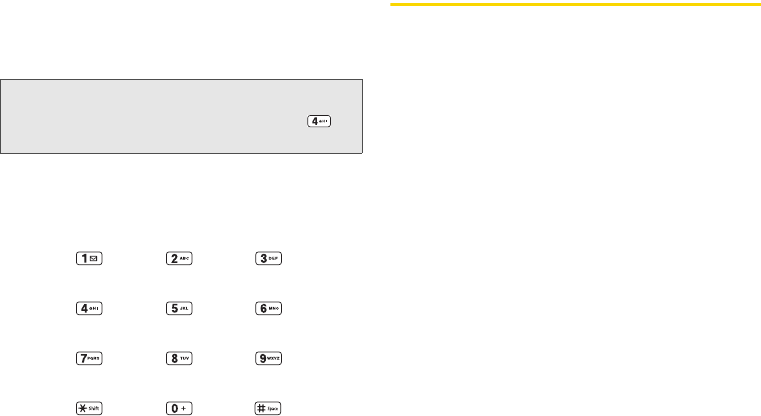
86 3A. Sprint Service: The Basics
Using Another Phone to Access Messages
1. Dial your wireless phone number.
2. When your voicemail answers, press the star key (*).
3. Enter your password.
Voicemail Key Guide
Here’s a quick guide to your keypad functions while
listening to voicemail messages.
Date/Time Send Reply Advance
Replay Rewind Forward
Erase Return Call Save
Cancel Help Skip
Messaging
With messaging, you can send and receive messages
between your phone and another messaging-ready
phone. When you receive a new message, it will
automatically display on your phone’s screen.
In addition, messaging includes a variety of preset
messages, such as “The meeting has been cancelled,”
that make composing messages fast and easy. Use
your phone to customize your own preset messages
(up to 50 characters).
There are two types of messaging, Text Messaging
(SMS) and Multimedia Messaging (MMS).
Text messages can be composed of up to six segments
of 160 characters each, for a total of 960 characters per
text message. The current segment and total segment
count is displayed at the top of each segment. For
example, (5/6) at the top of a segment would indicate
you are viewing segment five of a six-segment message.
Multimedia messages consist of both text and
multimedia files, such as pictures or voice recordings.
Outgoing multimedia messages can be up to 600 KB
with up to 1000 text characters.
Tip: When you call into voicemail, you first hear the header
information (date, time, and sender information) for the
message. To skip directly to the message, press
during the header.

3A. Sprint Service: The Basics 87
Sprint Service
Composing Messages
1. From standby mode, press MESSAGING (left
softkey) > Send Message.
2. Select a recipient from the list or from the following
options:
ⅢGo to Contacts to select a recipient from your
Contacts. (Qualifying Contacts entries must
contain a phone number or an email address.)
ⅢMULTIPLE (left softkey) to select multiple
recipients. Press CONTINUE (left softkey) when
you have finished selecting recipients. (You may
include up to 40 recipients per message.)
ⅢNEW ADDRESS (right softkey) to enter a recipient’s
phone number or email address directly. Press
CONTINUE (left softkey) to proceed.
3. Compose a message.
ⅢPress OPTIONS (right softkey) to select additional
options.
4. To attach attachments, select <Add Attachment>,
and select Picture or Audio.
ⅢIf you select Picture, select Take New Picture or
My Photos.
ⅢIf you select Audio, select Record New Audio or
Recorded Data.
5. Select files you would like to attach, and then press
NEXT (left softkey). (If you have taken a new picture
or recorded a new audio, skip this step.)
6. Review your message and press SEND (left softkey).
Accessing Messages
To read a message:
ᮣWhen you receive a message, your phone will display
a notification message. Use your navigation key or
select View; or press VIEW (left softkey) for CMAS
alerts messages (see page 35), to view the message.
To reply to a message:
1. While the message is displayed, press REPLY (left
softkey).
ⅢSelect Reply to Sender or Reply All if you are replying
to an MMS message with multiple recipients.
2. Compose a reply and press SEND (left softkey).
Note: If Parental Controls is on and Messaging is restricted,
messaging may be disabled; or messages may only
be sent to allowed recipients. (See page 41.)

88 3A. Sprint Service: The Basics
Threaded Messaging
Threaded messaging lets you follow a chain of
messages to and from a particular contact.
To display the thread list:
ᮣFrom standby mode, press MESSAGING (left
softkey) > Messages.
You will see a thread list. Each thread has an entry’s
name (if saved in Contacts), a phone number, or an
email address. You will also see the number of unread
messages, if any, for each thread.
Viewing Messages
Highlight a thread and press to display the
messages sent to and received from a particular
contact, in reverse chronological order. Failed, pending,
and draft messages are also listed.
Highlight a message to see details for that message.
ⅢMe – Message you sent.
ⅢMe (Failed) – Message you did not send
successfully.
ⅢMe (Pending) – Message you have not sent yet
because your phone has no network connection.
The message will be sent automatically when
your phone reconnects to the network.
ⅢMe (Draft) – Message you saved as a draft. Only
one draft can be saved in each thread, and that
draft appears at the top of the thread.
Message Details
Highlight a message and press to display the
message details and view the entire message.
You can select certain information from a message or
email message and automatically save it or use it in a
related application. See “Simple Data Exchange” on
page 26.
Threaded Messaging Options
When you are viewing a messaging thread list, a
message thread, or a message details screen, you can
choose from among the following options. (Options will
vary according to screen.)
ᮣPress or to make a call.
ᮣPress SEND MESSAGE (left softkey) to send a
message to the entry.
ᮣPress REPLY (left softkey) to reply to a message.

3A. Sprint Service: The Basics 89
Sprint Service
ᮣPress SEND (left softkey) to send a draft message.
ᮣPress RESEND (left softkey) to resend a failed
message.
ᮣSelect a message, press OPTIONS (right softkey),
and select an option:
ⅢForward to forward the selected message.
ⅢLock to lock the selected message.
ⅢUnlock to unlock the selected message.
ⅢUnlock All to unlock all messages.
ⅢDelete to delete the selected message.
ⅢDelete All to delete all messages.
ⅢCall to dial the phone number appearing in the
selected message.
ⅢLaunch to open the URL appearing in the
selected message.
ⅢSave Number to save the phone number
appearing in the selected message.
ⅢSave Email to save the email address appearing
in the selected message.
ⅢManage Text Blocking to block text messages from
specific phone numbers or email addresses.
ⅢSettings to display the Messaging Settings menu.
ⅢMore Information to display more information
when receiving a CMAS alert message. (See
“Setting CMAS Alerts” on page 35.)
Caller ID
Caller ID allows people to identify a caller before
answering the phone by displaying the number of the
incoming call. If you do not want your number
displayed when you make a call, follow these steps.
1. Press .
2. Enter the number you want to call.
3. Press .
To permanently block your number, call Sprint
Customer Service.
Note: Messages are automatically deleted starting with the
oldest. To save messages, lock them.
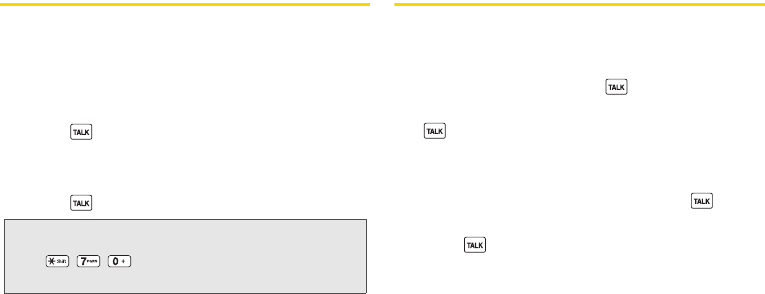
90 3A. Sprint Service: The Basics
Call Waiting
When you are on a call, Call Waiting alerts you to
incoming calls by sounding two beeps. Your phone’s
screen informs you that another call is coming in and
displays the caller’s phone number (if available).
To respond to an incoming call while you’re on a call:
ᮣPress . (This puts the first caller on hold and
answers the second call.)
To switch back to the first caller:
ᮣPress again.
Making a 3-Way Call
With 3-Way Calling, you can talk to two people at the
same time. When using this feature, the normal airtime
rates will be charged for each of the two calls.
1. Enter a number and press .
2. Once you have established the connection, press
. (This puts the first caller on hold.)
3. Select Contacts, Recent History, or Enter Phone#.
4. Select a number from your Contacts or Recent History,
or enter a number directly, and then press .
5. When you’re connected to the second party,
press again or
JOIN (right softkey) to begin
your 3-way call.
If one of the people you called hangs up during your
call, you and the remaining caller stay connected. If you
initiated the call and are the first to hang up, all callers
are disconnected.
Tip: For those calls where you don’t want to be interrupted,
you can temporarily disable Call Waiting by pressing
before placing your call. Call Waiting is
automatically reactivated once you end the call.
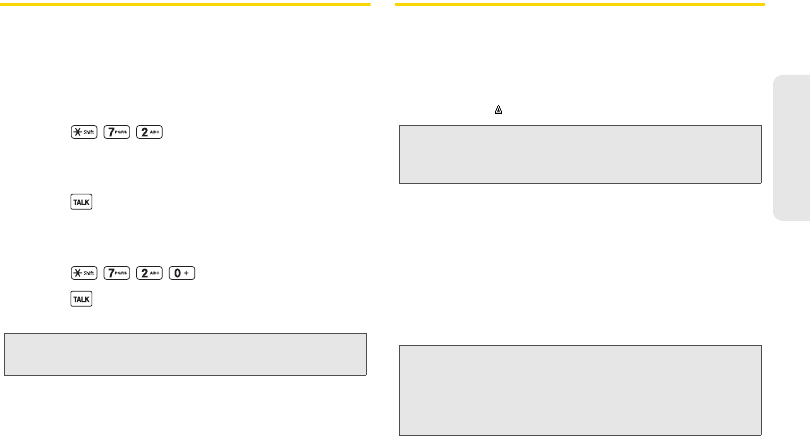
3A. Sprint Service: The Basics 91
Sprint Service
Call Forwarding
Call Forwarding lets you forward all your incoming calls
to another phone number – even when your phone is
turned off. You can continue to make calls from your
phone when you have activated Call Forwarding.
To activate Call Forwarding:
1. Press .
2. Enter the area code and phone number to which
you want your calls forwarded.
3. Press . (You will hear a tone to confirm the
activation of Call Forwarding.)
To deactivate Call Forwarding:
1. Press .
2. Press . (You will hear a tone to confirm the
deactivation.)
Roaming
Roaming Icon
Your phone’s display screen always lets you
know when you’re off the Nationwide Sprint Network.
Anytime you are roaming, the phone displays the
roaming icon ( ).
Roaming on Other Networks
When you’re roaming on other networks, your call
quality and security will be similar to the quality you
receive when making calls on the Nationwide Sprint
Network. However, you may not be able to access
certain features, such as data services, depending on
the available network.
Note: You are charged a higher rate for calls you have
forwarded.
Tip: Remember, when you are using your phone off the
Nationwide Sprint Network, always dial numbers using 11
digits (1 + area code + number).
Note: If you’re on a call when you leave the Nationwide Sprint
Network, your call is dropped. If your call is dropped in
an area where you think Sprint service is available, turn
your phone off and on again to reconnect to the
network.

92 3A. Sprint Service: The Basics
Checking for Voicemail Messages While
Roaming
When you are roaming off the Nationwide Sprint
Network, you may not receive on-phone notification of
new voicemail messages. Callers can still leave
messages, but you will need to periodically check your
voicemail for new messages if you are in a roaming
service area for an extended period of time.
1. Dial 1 + area code + your phone number.
2. When you hear your voicemail greeting, press .
3. Enter your password at the prompt and follow the
voice prompts.
When you return to the Nationwide Sprint Network,
voicemail notification will resume as normal.
Setting Roam Mode
Your phone allows you to control your roaming
capabilities. By using the Roaming menu option, you
can determine which signals your phone accepts.
Choose from two different settings on your phone to
control your roaming experience.
1. Press > Settings > Others > Roaming >
Set Mode.
2. Select an option:
ⅢSprint Only to access only the Nationwide Sprint
Network and prevent roaming on other networks.
ⅢAutomatic to seek service on the Nationwide Sprint
Network. When Sprint service is unavailable, the
phone searches for an alternate service.
Call Guard
Your phone has two ways of alerting you when you are
roaming off the Nationwide Sprint Network: the
onscreen roaming icon and Call Guard. Call Guard
makes it easy to manage your roaming by requiring an
extra step before you can place or answer a roaming
call. (This additional step is not required when you
make or receive calls while on the Nationwide Sprint
Network.)
To turn Call Guard on or off:
1. Press > Settings > Others > Roaming >
Call Guard.
2. Select On or Off.

3A. Sprint Service: The Basics 93
Sprint Service
To place roaming calls with Call Guard on:
1. From standby mode, dial 1 + area code + the
seven-digit number and press .
2. Read the message and press .
To answer incoming roaming calls with Call Guard on:
1. Press .
2. Read the message and press .
Data Roam Guard
Depending on service availability and roaming
agreements, your phone may be able to access data
services while roaming on certain other networks. You
can set your phone to alert you when you are roaming
off the Nationwide Sprint Network and try to use data
services such as messaging.
To set your Data Roam Guard notification:
1. Press > Settings > Others > Roaming >
Data Roam Guard.
2. Select On or Off.
ⅢOn (default mode) turns your phone’s Data Roam
Guard feature on. You will see a prompt that will
require you to respond anytime you access data
services while roaming.
ⅢOff turns your phone’s Data Roam Guard feature
off. Your phone will not notify you of your roaming
status when you access data services.
To use data services when Data Roam Guard is active:
ᮣWhen a notification appears informing you that
data roam charges may apply, press ROAM (left
softkey) to connect.
Note: Call Guard is turned on by default on your phone.
Voice dialing and speed dialing are not available when
you are roaming with Call Guard enabled.
Note: If the Call Guard feature is set to On, you need to take
extra steps to make and receive roaming calls.

94 3B. Web and Data Services
ࡗGetting Started With Data Services (page 94)
ࡗAccessing Messages (page 97)
ࡗDownloading Games, Ringers, and More (page 99)
ࡗApplications (page 101)
ࡗBrowser Menu (page 102)
ࡗData Services FAQs (page 105)
Getting Started With Data Services
With your Sprint service, you are ready to start enjoying
the advantages of data services. This section will help
you learn the basics of using your data services,
including managing your user name, launching a data
connection, and navigating the Web with your phone.
Your User Name
When you buy your phone and sign up for service, you’re
automatically assigned a user name, which is typically based
on your name and a number, followed by “@sprintpcs.com.”
(For example, the third John Smith to sign up for data services
might have jsmith003@sprintpcs.com as his user name.)
When you use data services, your user name is submitted to
identify you to the Nationwide Sprint Network. Your user
name will be automatically programmed into your phone.
You don’t have to enter it.
Finding Your User Name
If you are not sure what your user name is, you can
easily find it on your phone.
ᮣPress > Settings > Phone Info > Phone#/User ID.
Updating Your User Name
If you choose to change your user name and select a
new one online, you must then update the user name
on your phone.
ᮣPress > Settings > Others > Data >
Update Data Profile. (To cancel, press before
completing the update.)
3B. Web and Data Services

3B. Web and Data Services 95
Web and Data
Launching a Web Connection
ᮣPress > Web. (Your data connection starts and
you see the SprintWebSM home page.)
While connecting, you may see an animation before
the home page appears.
Data Connection Status and Indicators
Your phone displays the current status of your data
connection through indicators at the top of the screen.
The following symbols are used:
You are connected to the Sprint 1xRTT data
network. Data is being transferred (for example,
when you are opening a Web page) and you
cannot receive calls.
You are connected to the network but data is not
currently being transferred (for example, when you
are viewing a Web page that is completely open),
and you can receive calls.
If you do not see an indicator, your phone does not have
a current data connection. To launch a connection, see
“Launching a Web Connection” on this page.
Note: If Net Guard is enabled and displayed (see page 44),
press YES (left softkey) to continue and launch the
Web.
If Parental Controls is on and the Web is restricted, you
cannot launch a Web connection. (See page 41.)
Tip: To change the default launch page to the last page you
viewed, press TOOLBAR (right softkey) and select
OPTIONS > Advanced > Startup page >
The last page I viewed > DONE (left softkey).

96 3B. Web and Data Services
Navigating the Web
Navigating through menus and websites during a data
session is easy once you’ve learned a few basics. Here
are some tips for getting around.
Softkeys
During a data session, the bottom line of your phone’s
display screen contains one or more softkeys. These
keys are shortcut controls for navigating around the
Web, and they correspond to the softkeys directly
below the phone’s display screen.
To use softkeys:
ᮣPress a softkey. (If an additional pop-up menu is
displayed when you press the softkey, select the
menu items using your keypad [if they’re
numbered], or by highlighting the option and
pressing .)
Scrolling
As with other parts of your phone’s menu, you’ll have to
scroll up and down to see everything on some websites.
To scroll line by line through websites:
ᮣPress the navigation key up or down.
Selecting
Once you’ve learned how to use softkeys and scroll,
you can start navigating the Web.
To select onscreen items:
ᮣUse the navigation key to highlight an item, and
then press the left softkey (or press ).
Links, which are displayed as underlined text, allow you
to jump to Web pages, select special functions, or even
place phone calls.
To select links:
ᮣHighlight the link and press the appropriate softkey.
Tip: Depending on which websites you visit, the labels on the
softkeys may change to indicate their function.
Tip: You’ll find that the left softkey is used primarily for
selecting items. This softkey is often labeled “GO.”
If the items on a page are numbered, you can use your
keypad (number keys) to select an item.
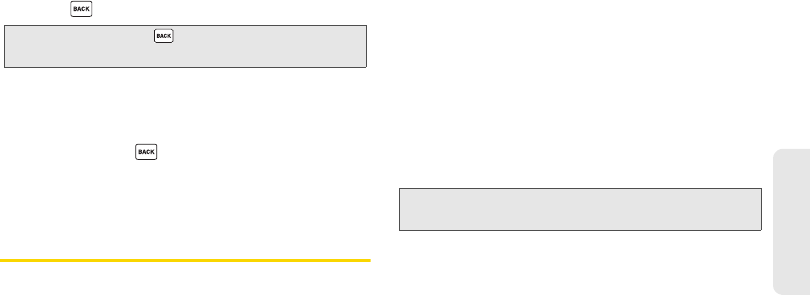
3B. Web and Data Services 97
Web and Data
Going Back
To go back one page:
ᮣPress on your phone.
Going Home
To return to the home page from any other page:
ᮣPress and hold .
– or –
Press TOOLBAR (right softkey) > MY HOMEPAGE.
Accessing Messages
You can send and receive email messages or instant
messages and participate in Web-based chat rooms
right from your phone. Messaging allows you to stay
connected 24 hours a day anywhere on the Nationwide
Sprint Network.
Accessing Email
Sprint provides you with access to popular email services,
such as Yahoo!® Mail, AOL® Mail and AIM® Mail, and MSN®
Hotmail to keep in touch, even while you’re on the go.
1. From the home page, select Messaging > Email.
2. Select Yahoo! Mail, AOL & AIM Mail, or MSN Hotmail.
3. Use your keypad to enter the required sign-in
information for the selected provider, such as user
name, email address, or password, and select
Sign In. (Your mailbox for the selected provider will
be displayed.)
4. Follow the onscreen instructions to read, reply to,
compose, and send messages and manage your
email account.
Note: You can also use for deleting text (like a
BACKSPACE key) when you are entering text.
Note: The information required to sign in will vary depending
on the email provider you are accessing.

98 3B. Web and Data Services
Accessing Sprint Instant Messaging
Sprint provides you with access to popular instant
messaging (IM) clients, including AOL® Instant
Messenger™, MSN® Messenger, and Yahoo!® Messenger.
1. From the home page, select Messaging >
Instant Messaging.
2. Select an IM provider such as Yahoo! Messenger or
MSN Messenger.
3. Use your keypad to enter the required sign-in
information for the selected provider, such as user
name or password, and select SIGN IN (left
softkey). (You will see your IM screen for the
selected provider.)
4. Follow the onscreen instructions to read, reply to,
compose, and send messages and manage your
IM account.
Accessing Wireless Chatrooms
Sprint gives you the ability to join wireless chatrooms
from your phone.
1. From the home page, select Messaging >
Chat & Dating.
2. Select a category and a chat provider and follow
the onscreen instructions to sign up and begin
chatting.
Note: The information required to sign in will vary depending
on the instant messaging provider you are accessing.
Note: Chat & Dating options change frequently, so check
back often to see what’s new.

3B. Web and Data Services 99
Web and Data
Downloading Games, Ringers, and
More
You have access to a dynamic variety of downloadable
content, such as Games, Screen Savers, and other
applications. (Additional charges may apply.) Follow
the basic steps below to access and download these
items.
Accessing the Download Menus
1. Press > My Stuff.
2. Select a download category (Games, Ringers,
Screen Savers, or Applications), and then select
Get New. (The browser will start and take you to the
corresponding download menu.)
To access the download menus from the Web browser:
1. From the home page, select Downloads.
2. Select a download category (Games, Ringers,
Screen Savers, or Applications) to go to the
corresponding download menu. (For more
information on navigating the Web, see
“Navigating the Web” on page 96.)
Selecting an Item to Download
You can search for available items to download in a
number of ways:
ⅷFeatured displays a selection of featured items.
ⅷCategories allows you to narrow your search to a
general category. (There may be several pages of
available content in a list. Select Next 9 to view
additional items.)
ⅷSearch allows you to use your keypad to enter
search criteria to locate an item. You may enter an
entire word or title or perform a partial-word search.
Downloading an Item
Once you’ve selected an item you wish to download,
highlight it and press , or press GO (left softkey).
You will see a summary page for the item including its
title, the vendor, the download details, the file size, and
the cost. Links allow you to view the License Details
page, which outlines the price, license type, and length
of license for the download, and the Terms of Use page,
which details the Premium Services Terms of Use and
your responsibility for payment.
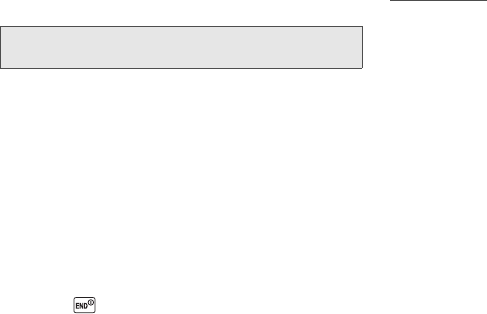
100 3B. Web and Data Services
To download a selected item:
1. From the information page, select Buy. (The item
will download automatically. When you see the
New Download screen, you have successfully
downloaded the item to your phone.)
2. Select an option to continue:
ⅢSelect a menu such as Run/Open/Listen/View/Play
to start the downloaded item. Your data session will
end, and your phone will redirect you to the
appropriate phone menu screen.
ⅢSelect Assign to assign a ringer or screen saver to
a phone function.
ⅢSelect Settings to configure downloaded games
or applications.
ⅢSelect Shop to browse for other items to
download.
ⅢPress to quit the browser and return to
standby mode.
My Content Manager
Whether you purchase your content from your phone
or from your online account management page at
www.sprint.com, My Content Manager stores all of your
purchases and you may download them to your phone
from there.
My Content Manager is a storage area on the
Nationwide Sprint Network that allows you to store all
your purchased files. The files remain in My Content
Manager until their license terms have expired – even
after you have downloaded the content to your phone.
This provides you with a convenient place to access
information about your downloaded files without
having to store the information in your phone’s
memory.
To access My Content Manager:
ᮣFrom the home page, select Downloads >
My Content Manager. (You will see a list of your
purchased items.)
Note: If you have not previously purchased an item, you will
be prompted to create your purchasing profile.
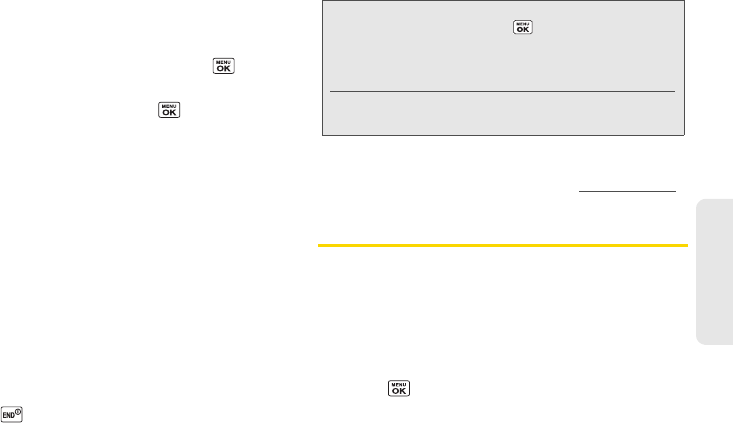
3B. Web and Data Services 101
Web and Data
To download purchased content from My Content
Manager:
1. From the My Content Manager display, highlight the
item you wish to download, and press . (You
will see the information page for the selected item.)
2. Highlight Download and press . (The item will
download automatically. When you see the
New Download screen, you have successfully
downloaded the item to your phone.)
3. Select an option to continue:
ⅢSelect a menu such as Run/Open/Listen/View/Play
to start the downloaded item. Your data session will
end, and your phone will redirect you to the
appropriate phone menu screen.
ⅢSelect Assign to assign a ringer or screen saver to
a phone function.
ⅢSelect Settings to configure downloaded games
or applications.
ⅢSelect Shop to browse for other items to
download.
ⅢPress to quit the browser and return to
standby mode.
For complete information and instructions on
downloading Games, Ringers, Screen Savers, and
Applications, visit the Digital Lounge at www.sprint.com.
Applications
You can access a wide variety of applications in many
different categories with your phone and data service.
Your phone comes preloaded with link to the following
application:
ⅷScanLife
To get started with the application:
1. Press > My Stuff > Applications > ScanLife.
(The application will launch.)
2. Accept the terms and conditions if asked.
3. Press Menu (left softkey) to explore your options.
Tip: You can also access My Content Manager through the
phone’s main menu. Press > My Stuff > [Games,
Ringers, Screen Savers, or Applications] >
My Content Manager. The browser will open and take
you to the corresponding content.
When an application is running in the background, press
APP. MGR. (left softkey) to go to the application screen.

102 3B. Web and Data Services
Browser Menu
Although the home page offers a broad and
convenient array of sites and services for you to
browse, not all sites are represented, and certain
functions, such as going directly to specific websites,
are not available. For these and other functions, you will
need to use the browser menu. The browser menu
offers additional options to expand your use of the Web
on your phone.
Opening the Browser Menu
You may open the browser menu anytime you have an
active data session, from any page you are viewing.
To open the browser menu:
ᮣPress TOOLBAR (right softkey). (You will see the
browser menu.)
Options available under the browser menu include:
ⅷMY HOMEPAGE to return the browser to the home
page.
ⅷMY PAGES to access and manage your favorites
(bookmarks).
ⅷSPRINT SEARCH to launch a Web search.
ⅷOPTIONS to display additional options:
ⅢSet as Homepage to set the current page as your
home page.
ⅢFont size to change the font size for the browser.
ⅢSend this page to... to send a URL using the
phone’s messaging feature.
ⅢClear private data to delete the browser’s cache,
cookies, etc.
Important Privacy Message – Sprint’s policies often do not
apply to third-party applications. Third-party applications may
access your personal information or require Sprint to disclose
your customer information to the third-party application
provider. To find out how a third-party application will collect,
access, use, or disclose your personal information, check the
application provider’s policies, which can usually be found on
their website. If you aren’t comfortable with the third-party
application’s policies, don’t use the application.

3B. Web and Data Services 103
Web and Data
ⅢHelp to show more detailed information about
using the browser.
ⅢAdvanced
●Icon Row to display the icon row, the top area
on the screen that displays the status icons,
time, battery charge level, etc.
●Startup page to change the default launch page.
●Page info to display information about the
current page.
●Images on/off to display images on the Web
page.
●Reset browser to reset the browser to its
default state.
●Turn on/off error logging to set whether to save
error logs (text files useful for debugging
browser errors).
Ⅲ View error log to display the error log.
●Send referrer to send HTTP URL referrer
information.
●Redirect prompt to display a prompt when
your data is being redirected.
●Reset browser settings to reset all browser
settings.
●About browser to display information about
your browser.
●Java Scripting to enable or disable Java
scripting.
Going to a Specific Website
To go to a particular website by entering a URL (Web
address):
1. From any Web page, press the navigation key up
to highlight the address bar.
2. Use your keypad to enter the URL of the website
you wish to go to and press .
Note: Not all websites are viewable on your phone.
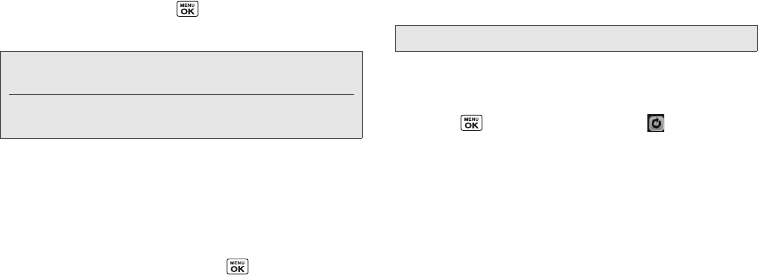
104 3B. Web and Data Services
Creating a Favorite
Favorites (bookmarks) allow you to store the addresses
of your favorite websites for easy access at a later time.
1. From the Web page you wish to add, press
TOOLBAR (right softkey) to open the browser menu.
2. Select MY PAGES.
3. Confirm that Add this page to favorites is
highlighted and press .
4. Press ADD (left softkey).
Accessing a Favorite
1. Press TOOLBAR (right softkey) to open the browser
menu.
2. Select MY PAGES.
3. Highlight a favorite and press .
Deleting a Favorite
1. Press TOOLBAR (right softkey) to open the browser
menu.
2. Select MY PAGES.
3. Highlight a favorite and press OPTIONS (right
softkey).
4. Select Delete this Favorite. (A confirmation will be
displayed.)
5. Press REMOVE (left softkey) to remove the favorite.
Reloading a Web Page
ᮣPress while the Refresh icon ( ) at the upper
right corner of the browser is highlighted.
Note: Saving a page as a favorite does not store the page
contents, just its address.
Some pages cannot be saved as favorites, depending
on how a particular page was created.
Tip: Select Delete all Favorites to delete all favorites.
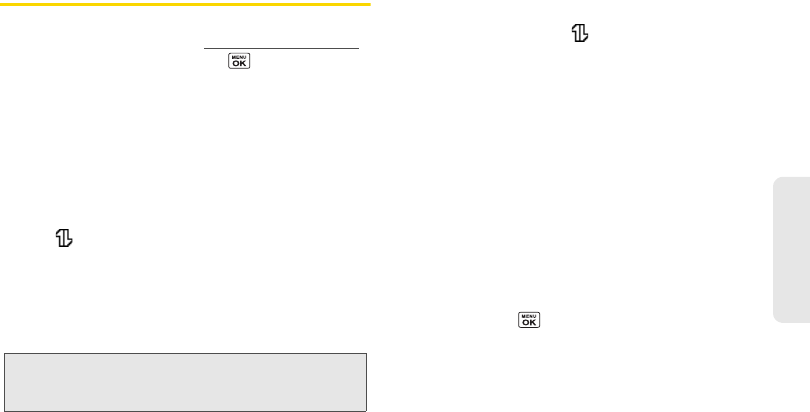
3B. Web and Data Services 105
Web and Data
Data Services FAQs
How will I know when my phone is ready for data service?
Your user name (for example, bsmith01@sprintpcs.com)
will be displayed when you press > My Account >
Account Details.
How do I sign in for the first time?
You are automatically signed in to access data services
when you turn on your phone.
How do I know when my phone is connected to data
services?
Your phone automatically connects when data service
is used or an incoming message arrives. You will also
see the indicator.
Can I make calls and use data services at the same time?
You cannot use voice call and data services
simultaneously. You can place an outgoing call
anytime, but it will interrupt any in-progress data
session.
When is my data connection active?
Your connection is active when data is being
transferred. Both incoming and outgoing calls are
allowed. When active, the is animated on the
display screen.
When is my data connection dormant?
If your phone receives no data for 10 seconds, the
connection goes dormant. When the connection is
dormant, you can make and receive voice calls. (The
connection may become active again quickly.) If no
data is received for an extended period, the connection
will terminate.
Can I sign out of data services?
You can sign out without turning off your phone;
however, you will not be able to browse the Web or use
other data services. While signed out, you can still
place or receive phone calls, check voicemail, and use
other voice services. You may sign in again at any time.
To sign out, press > Settings > Others > Data >
Data On in your phone’s menu.
Note: If you receive a call during an active data session, your
data session will resume after you have completed the
call, ignored the call, or sent the call to voicemail.
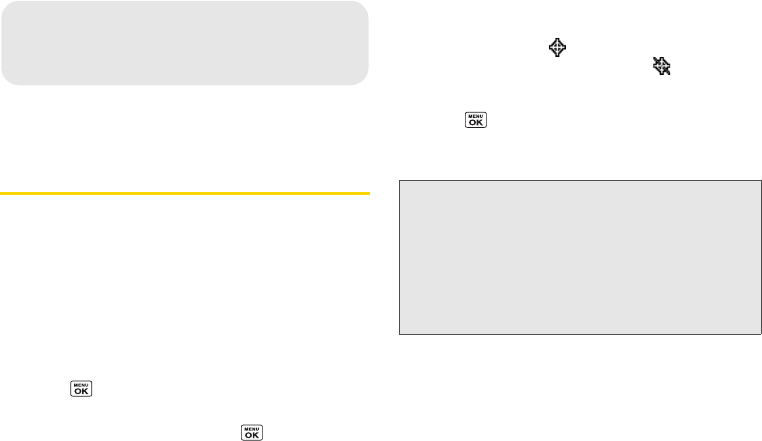
106 3C. GPS Navigation
ࡗGPS Services (page 106)
ࡗSprint Family Locator (page 107)
GPS Services
Your phone’s built-in GPS capability gives you access
to a number of location-based services, including
Sprint Family Locator.
Activating Location Mode
Before using any of the location-based services, you
must activate your phone’s location feature.
To enable your phone’s Location feature:
1. Press > Settings > Others > Location > On/Off.
(You will see the Location disclaimer.)
2. Read the disclaimer and press .
3. Select On.
When the Location feature is on, your phone’s standby
screen will display the icon. When Location is
turned off, your phone will display the icon.
To send the GPS log to other devices:
1. Press > Settings > Others > Location >
NMEA Output.
2. Select Bluetooth or USB.
3C. GPS Navigation
Note: Turning Location on will allow the network to detect
your position using GPS technology, making some
Sprint applications and services easier to use. Turning
Location off will disable the GPS location function for all
purposes except 911, but will not hide your general
location based on the cell site serving your call. No
application or service may use your location without
your request or permission. GPS-enhanced 911 is not
available in all areas.
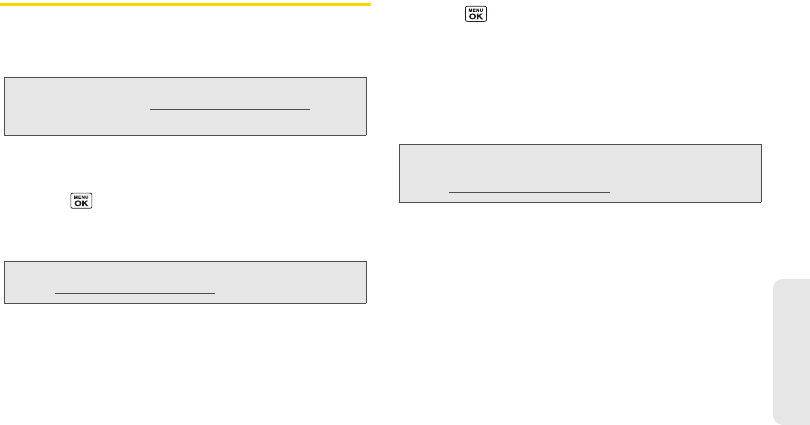
3C. GPS Navigation 107
GPS Navigation
Sprint Family Locator
Sprint Family Locator uses GPS technology to locate
your child’s phone and display the location on an
interactive map.
Signing Up for Sprint Family Locator
1. Press > Sprint Family Locator.
2. Follow the onscreen instructions to enter and
submit the required information.
Using Sprint Family Locator
1. Press > Sprint Family Locator.
2. Enter the parent phone number and password to
sign in to your account.
3. Select a phone to locate from the available child
phone list.
4. When you are finished, select Sign Out.
Note: Sprint Family Locator service requires an additional
monthly fee. Visit www.sprint.com/familylocator for
complete details.
Note: You can also sign up for Sprint Family Locator online at
www.sprint.com/familylocator.
Note: Sprint Family Locator may also be used with any
computer with an Internet connection. Visit
www.sprint.com/familylocator for complete details.
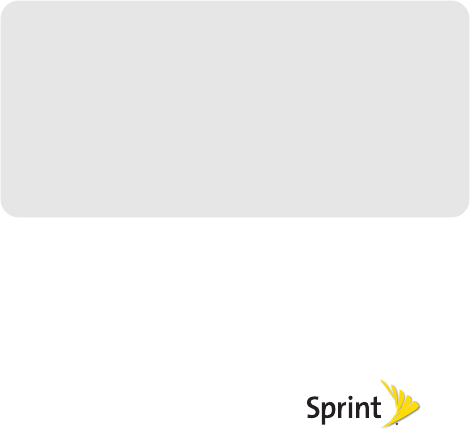
Section 4
Safety and Warranty
Information

110 4A. Important Safety Information
ࡗGeneral Precautions (page 110)
ࡗMaintaining Safe Use of and Access to Your Phone
(page 111)
ࡗUsing Your Phone With a Hearing Aid Device (page 112)
ࡗCaring for the Battery (page 114)
ࡗRadio Frequency (RF) Energy (page 115)
ࡗOwner’s Record (page 117)
ࡗUser Guide Proprietary Notice (page 117)
This phone guide contains important operational and
safety information that will help you safely use your
phone. Failure to read and follow the information
provided in this phone guide may result in serious
bodily injury, death, or property damage.
General Precautions
There are several simple guidelines to operating your phone
properly and maintaining safe, satisfactory service.
ⅷTo maximize performance, do not touch the bottom portion
of your phone where the internal antenna is located while
using the phone.
ⅷSpeak directly into the mouthpiece.
ⅷAvoid exposing your phone and accessories to rain or liquid
spills. If your phone does get wet, immediately turn the
power off and remove the battery.
ⅷDo not expose your phone to direct sunlight for extended
periods of time (such as on the dashboard of a car).
ⅷAlthough your phone is quite sturdy, it is a complex piece of
equipment and can be broken. Avoid dropping, hitting,
bending, or sitting on it.
ⅷAny changes or modifications to your phone not expressly
approved in this document could void your warranty for this
equipment and void your authority to operate this
equipment.
4A. Important Safety
Information
Note: For the best care of your phone, only Sprint-authorized
personnel should service your phone and accessories. Failure
to do so may be dangerous and void your warranty.
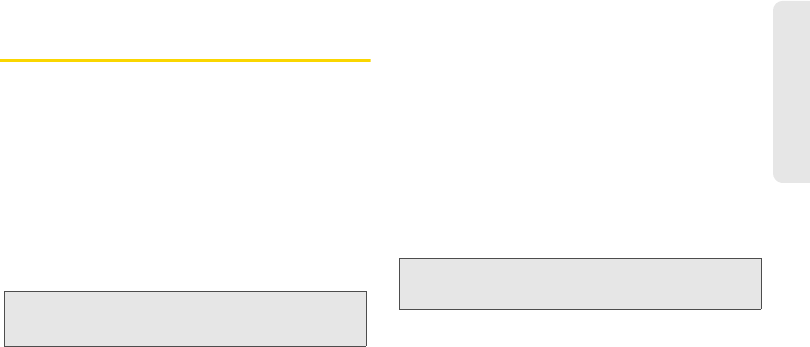
4A. Important Safety Information 111
Important Safety Information
Maintaining Safe Use of and Access
to Your Phone
Do Not Rely on Your Phone for Emergency Calls
Mobile phones operate using radio signals, which cannot
guarantee connection in all conditions. Therefore you should
never rely solely upon any mobile phone for essential
communication (e.g., medical emergencies). Emergency calls
may not be possible on all cellular networks or when certain
network services or mobile phone features are in use. Check
with your local service provider for details.
Using Your Phone While Driving
Talking on your phone while driving (or operating the phone
without a hands-free device) is prohibited in some jurisdictions.
Laws vary as to specific restrictions. Remember that safety
always comes first.
Following Safety Guidelines
To operate your phone safely and efficiently, always follow any
special regulations in a given area. Turn your phone off in areas
where use is forbidden or when it may cause interference or
danger.
Using Your Phone Near Other Electronic Devices
Most modern electronic equipment is shielded from radio
frequency (RF) signals. However, RF signals from wireless
phones may affect inadequately shielded electronic
equipment.
RF signals may affect improperly installed or inadequately
shielded electronic operating systems or entertainment
systems in motor vehicles. Check with the manufacturer or their
representative to determine if these systems are adequately
shielded from external RF signals. Also check with the
manufacturer regarding any equipment that has been added to
your vehicle.
Consult the manufacturer of any personal medical devices,
such as pacemakers and hearing aids, to determine if they are
adequately shielded from external RF signals.
Turning Off Your Phone Before Flying
Turn off your phone before boarding any aircraft. To prevent
possible interference with aircraft systems, the U.S. Federal
Aviation Administration (FAA) regulations require you to have
permission from a crew member to use your phone while the
plane is on the ground. To prevent any risk of interference, FCC
regulations prohibit using your phone while the plane is in the
air.
Tip: Purchase an optional hands-free accessory at your local
Sprint Store, or call Sprint at 1-866-866-7509. You can also
dial # 2 2 2 on your phone.
Note: Always turn off the phone in healthcare facilities, and request
permission before using the phone near medical
equipment.

112 4A. Important Safety Information
Turning Off Your Phone in Dangerous Areas
To avoid interfering with blasting operations, turn your phone
off when in a blasting area or in other areas with signs
indicating two-way radios should be turned off. Construction
crews often use remote-control RF devices to set off explosives.
Turn your phone off when you’re in any area that has a
potentially explosive atmosphere. Although it’s rare, your phone
and accessories could generate sparks. Sparks can cause an
explosion or fire, resulting in bodily injury or even death. These
areas are often, but not always, clearly marked. They include:
ⅢFueling areas such as gas stations.
ⅢBelow deck on boats.
ⅢFuel or chemical transfer or storage facilities.
ⅢAreas where the air contains chemicals or particles such
as grain, dust, or metal powders.
ⅢAny other area where you would normally be advised to
turn off your vehicle’s engine.
Restricting Children’s Access to Your Phone
Your phone is not a toy. Do not allow children to play with it as
they could hurt themselves and others, damage the phone or
make calls that increase your Sprint invoice.
Using Your Phone With a Hearing
Aid Device
A number of Sprint phones have been tested for hearing aid
device compatibility. When some wireless phones are used
with certain hearing devices (including hearing aids and
cochlear implants), users may detect a noise which can
interfere with the effectiveness of the hearing device.
Some hearing devices are more immune than others to this
interference noise, and phones also vary in the amount of
interference noise they may generate. ANSI standard C63.19
was developed to provide a standardized means of measuring
both wireless phone and hearing devices to determine usability
rating categories for both.
Ratings have been developed for mobile phones to assist
hearing device users find phones that may be compatible with
their hearing device. Not all phones have been rated for
compatibility with hearing devices. Phones that have been
rated have a label located on the box. Your Vero™ has an M4
and a T4 rating.
These ratings are not guarantees. Results will vary depending on the
user’s hearing device and individual type and degree of hearing loss.
If a hearing device is particularly vulnerable to interference noise;
even a phone with a higher rating may still cause unacceptable
noise levels in the hearing device. Trying out the phone with your
hearing device is the best way to evaluate it for your personal needs.
Note: Never transport or store flammable gas, flammable liquids, or
explosives in the compartment of your vehicle that contains
your phone or accessories.

4A. Important Safety Information 113
Important Safety Information
M-Ratings: Phones rated M3 or M4 meet FCC requirements for
hearing aid compatibility and are likely to generate less
interference to hearing devices than unrated phones. (M4 is the
better/higher of the two ratings.)
T-Ratings: Phones rated T3 or T4 meet FCC requirements and
are likely to be more usable with a hearing device’s telecoil
(“T Switch”or “Telephone Switch”) than unrated phones. (T4 is
the better/higher of the two ratings. Note that not all hearing
devices have telecoils in them.)
Hearing aid devices may also be measured for immunity to
interference noise from wireless phones and should have
ratings similar to phones. Ask your hearing healthcare
professional for the rating of your hearing aid. Add the rating of
your hearing aid and your phone to determine probable
usability:
ⅷAny combined rating equal to or greater than six offers
excellent use.
ⅷAny combined rating equal to five is considered normal use.
ⅷAny combined rating equal to four is considered usable.
Thus, if you pair an M3 hearing aid with an M3 phone, you will
have a combined rating of six for “excellent use.” This is
synonymous for T ratings.
Sprint further suggests you experiment with multiple phones (even
those not labeled M3/T3 or M4/T4) while in the store to find the
one that works best with your hearing aid device. Should you
experience interference or find the quality of service unsatisfactory
after purchasing your phone, promptly return it to the store within
30 days of purchase. (A restocking fee may be applied to
exchanges. Visit www.sprint.com/returns for details.) More
information about hearing aid compatibility may be found at:
www.fcc.gov, www.fda.gov, and www.accesswireless.org.
Getting the Best Hearing Device
Experience With Your Phone
To further minimize interference:
ⅷSet the phone’s main screen and keypad backlight settings
to ensure the minimum time interval (see also page 29):
1. Press > Settings > Display > Backlight >
Backlight Dim or Backlight Off.
2. Highlight the minimum time interval setting and press .
ⅷPosition the phone so the internal antenna is farthest from
your hearing aid.
ⅷMove the phone around to find the point with least
interference.
Note: New Technologies, Including Wi-Fi
This phone has been tested and rated for use with hearing
aids for some of the wireless technologies that it uses. However,
there may be newer wireless technologies (including Wi-Fi)
used in this phone that have not been tested for use with
hearing aids.

114 4A. Important Safety Information
Caring for the Battery
Protecting Your Battery
The guidelines listed below help you get the most out of your
battery’s performance.
ⅷRecently there have been some public reports of wireless
phone batteries overheating, catching fire or exploding. It
appears that many, if not all, of these reports involve
counterfeit or inexpensive, aftermarket-brand batteries with
unknown or questionable manufacturing standards. Sprint is
not aware of similar problems with Sprint phones resulting
from the proper use of batteries and accessories approved
by Sprint or the manufacturer of your phone. Use only Sprint-
approved or manufacturer-approved batteries and
accessories found at Sprint Stores or through your phone’s
manufacturer, or call 1-866-866-7509 to order. They’re also
available at www.sprint.com — click Accessories. Buying the
right batteries and accessories is the best way to ensure
they’re genuine and safe.
ⅷDo not disassemble or open crush, bend or deform,
puncture or shred the battery.
ⅷDo not modify or remanufacture, attempt to insert foreign
objects into the battery, immerse or expose to water or other
liquids, expose to fire, explosion or other hazard.
ⅷAvoid dropping the phone or battery. If the phone or battery
is dropped, especially on a hard surface, and the user
suspects damage, take it to a service center for inspection.
ⅷImproper battery use may result in a fire, explosion or other
hazard.
ⅷDo not short circuit a battery or allow metallic conductive
objects to contact battery terminals.
ⅷKeep the metal contacts on top of the battery clean.
ⅷBattery usage by children should be supervised.
Charging
ⅷIn order to avoid damage, charge the battery only in
temperatures that range from 32° F to 113° F (0° C to 45° C).
ⅷDon’t use the battery charger in direct sunlight or in high
humidity areas, such as the bathroom.
ⅷThe battery may need recharging if it has not been used for
a long period of time.
ⅷIt’s best to replace the battery when it no longer provides
acceptable performance. It can be recharged hundreds of
times before it needs replacing.
Storing
ⅷDon’t store the battery in high temperature areas for long
periods of time. It’s best to follow these storage rules:
ⅢLess than one month:
-4° F to 140° F (-20° C to 60° C)
ⅢMore than one month:
-4° F to 113° F (-20° C to 45° C)
Disposal of Lithium Ion (Li-Ion) Batteries
ⅷPromptly dispose of used batteries in accordance
with local regulations.
ⅷNever dispose of the battery by incineration.

4A. Important Safety Information 115
Important Safety Information
ⅷDo not handle a damaged or leaking Li-Ion battery as you
can be burned.
ⅷFor safe disposal options of your Li-Ion batteries, contact
your nearest Sprint authorized service center.
Special Note: Be sure to dispose of your battery properly. In
some areas, the disposal of batteries in household or business
trash may be prohibited.
Radio Frequency (RF) Energy
Understanding How Your Phone Operates
Your phone is basically a radio transmitter and receiver. When
it’s turned on, it receives and transmits radio frequency (RF)
signals. When you use your phone, the system handling your
call controls the power level. This power can range from 0.006
watt to 0.2 watt in digital mode.
Knowing Radio Frequency Safety
The design of your phone complies with updated NCRP
standards described below.
In 1991–92, the Institute of Electrical and Electronics Engineers
(IEEE) and the American National Standards Institute (ANSI) joined
in updating ANSI’s 1982 standard for safety levels with respect to
human exposure to RF signals. More than 120 scientists, engineers
and physicians from universities, government health agencies and
industries developed this updated standard after reviewing the
available body of research. In 1993, the Federal Communications
Commission (FCC) adopted this updated standard in a regulation.
In August 1996, the FCC adopted hybrid standard consisting of the
existing ANSI/IEEE standard and the guidelines published by the
National Council of Radiation Protection and Measurements
(NCRP).
Body-Worn Operation
To maintain compliance with FCC RF exposure guidelines, if
you wear a handset on your body, use a Sprint-supplied or
Sprint-approved carrying case, holster or other body-worn
accessory. If you do not use a body-worn accessory, ensure
the antenna is at least 0.866 inches (2.2 centimeters) from your
body when transmitting. Use of non-Sprint-approved
accessories may violate FCC RF exposure guidelines. Other
accessories used with this device for body-worn operations
must not contain any metallic components and must provide at
least 0.866 inches (2.2 centimeters) separation distance
including the antenna and the user’s body.
For more information about RF exposure, visit the FCC website
at www.fcc.gov.
Specific Absorption Rates (SAR) for Wireless
Phones
The SAR is a value that corresponds to the relative amount of
RF energy absorbed in the head of a user of a wireless
handset.
The SAR value of a phone is the result of an extensive testing,
measuring and calculation process. It does not represent how
much RF the phone emits. All phone models are tested at their

116 4A. Important Safety Information
highest value in strict laboratory settings. But when in
operation, the SAR of a phone can be substantially less than
the level reported to the FCC. This is because of a variety of
factors including its proximity to a base station antenna, phone
design and other factors. What is important to remember is that
each phone meets strict federal guidelines. Variations in SARs
do not represent a variation in safety.
All phones must meet the federal standard, which incorporates
a substantial margin of safety. As stated above, variations in
SAR values between different model phones do not mean
variations in safety. SAR values at or below the federal standard
of 1.6 W/kg are considered safe for use by the public.
The highest reported SAR values of the Vero™ are:
Cellular CDMA mode (Part 22):
Head: 1.49 W/kg; Body-worn: 0.51 W/kg
PCS mode (Part 24):
Head: 0.88 W/kg; Body-worn: 0.64 W/kg
FCC Radio Frequency Emission
This phone meets the FCC Radio Frequency Emission
Guidelines.
FCC ID number: V65SCP-3820.
More information on the phone’s SAR can be found from the
following FCC website: http://www.fcc.gov/oet/ea/.
FCC Notice
This device complies with Part 15 of the FCC Rules. Operation
is subject to the following two conditions: (1) this device may
not cause harmful interference, and (2) this device must accept
any interference received, including interference that may
cause undesired operation.
Changes or modifications not expressly approved by the party
responsible for compliance could void the user’s authority to
operate the equipment.
These limits are designed to provide reasonable protection
against harmful interference in a residential installation. This
equipment generates, uses and can radiate radio frequency
energy and, if not installed and used in accordance with the
instructions, may cause harmful interference to radio
communications.
However, there is no guarantee that interference will not occur
in a particular installation.
If this equipment does cause harmful interference to radio or
television reception, which can be determined by turning the
equipment off and on, the user is encouraged to try to correct
the interference by one or more of the following measures:
Note: This equipment has been tested and found to comply with the
limits for a Class B digital device, pursuant to Part 15 of the
FCC Rules.

4A. Important Safety Information 117
Important Safety Information
ⅷReorient the direction of the internal antenna.
ⅷIncrease the separation between the equipment and
receiver.
ⅷConnect the equipment into an outlet on a circuit different
from that to which the receiver is connected.
ⅷConsult the dealer or an experienced radio/TV technician for
help.
Owner’s Record
The model number, regulatory number, and serial number are
located on a nameplate inside the battery compartment.
Record the serial number in the space provided below. This will
be helpful if you need to contact us about your phone in the
future.
Model: SANYO Vero™ by KYOCERA
Serial No.:
User Guide Proprietary Notice
T9 Text Input is licensed under one or more of: U.S. Pat. Nos.
5,818,437; 5,953,541; 6,011,554; 6,307,548; 6,286,064;
6,307,549 and other patents pending.
User Guide template version 10a (January 2010)

118 4B. Manufacturer’s Warranty
ࡗManufacturer’s Warranty (page 118)
Your phone has been designed to provide you with
reliable, worry-free service. If for any reason you have a
problem with your equipment, please refer to the
manufacturer’s warranty in this section.
For information regarding the terms and conditions of
service for your phone, please visit www.sprint.com or
call Sprint Customer Service at 1-888-211-4727.
Manufacturer’s Warranty
Manufacturer’s Warranty
Kyocera Communications, Inc. (“KCI”) offers you, the
original purchaser who has purchased the enclosed
subscriber unit (“Product”) only from an authorized dealer in
the United States, a limited warranty that the Product, including
accessories in the Product’s package, will be free from defects
in material or workmanship as follows:
A. ONE (1) YEAR LIMITED WARRANTY: For a period of one
(1) year from the date of original purchase, KCI will, at its option,
either repair or replace a defective Product (with new or rebuilt
parts/replacements).
B. LIMITED WARRANTY ON REPAIRED/REPLACED
PRODUCTS: For a period equal to the remainder of the
limited warranty period on the original Product or, on warranty
repairs which have been effected on Products for 90 days after
the date of its repair or replacement, whichever is longer, KCI
will repair or replace (with new or rebuilt parts/replacements)
defective parts or Products used in the repair or replacement of
the original Product under the Limited Warranty on it.
Proof that the Product is within the warranty period in the form
of a bill of sale or warranty repair document that includes the
date of purchase, Product serial number and the authorized
dealer’s name and address, must be presented to obtain
warranty service. This limited warranty is not transferable to any
Note: In addition to the warranty provided by your phone’s
manufacturer, which is detailed on the following pages,
Sprint offers a number of optional plans to cover your
equipment for non-warranty claims. Sprint Total
Equipment Protection provides the combined
coverage of the Sprint Equipment Replacement
Program and the Sprint Equipment Service and
Repair Program, both of which are available
separately. Each of these programs may be signed up
for within 30 days of activating your phone. For more
details, please visit your nearest Sprint Store or call
Sprint at 1-800-584-3666.
4B. Manufacturer’s Warranty

4B. Manufacturer’s Warranty 119
Warranty
third party, including but not limited to any subsequent
purchaser or owner of the Product. Transfer or resale of a
Product will automatically terminate warranty coverage with
respect to it.
This limited warranty covers batteries only if battery capacity
falls below 80% of rated capacity or the battery leaks. Also this
limited warranty does not cover any battery if (i) the battery has
been charged by a battery charger not specified or approved
by KCI for charging the battery, (ii) any of the seals on the
battery are broken or show evidence of tampering, or (iii) the
battery has been used in equipment other than the SANYO
brand mobile phone for which it is specified.
This limited warranty covers the Product only as originally
supplied and does not cover and is void with respect to the
following: (i) Products which have been improperly installed,
repaired, maintained or modified (including the antenna); (ii)
Products which have been subjected to misuse (including
Products used in conjunction with hardware electrically or
mechanically incompatible or Products used with software,
accessories, goods or ancillary or peripheral equipment not
supplied or expressly authorized by KCI for use), abuse,
accident, physical damage, abnormal use or operation,
improper handling or storage, neglect, exposure to fire, water or
excessive moisture or dampness or extreme changes in
climate or temperature; (iii) Products operated outside
published maximum ratings; (iv) cosmetic damage; (v)
Products on which warranty stickers or Product serial numbers
have been removed, altered, or rendered illegible; (vi) customer
instruction; (vii) cost of installation, set up, removal or
reinstallation; (viii) signal reception problems (unless caused by
defect in material or workmanship); (ix) damage the result of
fire, flood, acts of God or other acts which are not the fault of
KCI and which the Product is not specified to tolerate, including
damage caused by mishandling and blown fuses; (x)
consumables (such as memory cards, fuses, etc.); (xi) third
party software or applications, data and equipment not
originally supplied with the Product; (xii) any Product in which
the software has not been updated to the current version; (xiii)
any Product in which the operating system has been unlocked
(allowing installation of a third party operating system); or (xiv)
any Products which have been opened, repaired, modified or
altered by anyone other than KCI or a KCI authorized service
center. Before returning any Product for service, be sure to
back up data and remove any confidential, proprietary, or
personal information from the Product. KCI is not responsible
for damage to or loss of any software, applications, data or
removable storage media.
This warranty is valid only in the United States.
REPAIR OR REPLACEMENT, AS HERE IN ABOVE
PROVIDED, IS YOUR SOLE AND EXCLUSIVE REMEDY
FOR BREACH OF THE LIMITED WARRANTY. KCI SHALL
HAVE NO LIABILITY FOR ANY INCIDENTAL OR
CONSEQUENTIAL DAMAGES, INCLUDING, BUT NOT
LIMITED TO LOSS OF PROFITS, LOST SALES, LOSS OF
DATA, LOSS OF USE OF THE PRODUCT, OR
ANTICIPATED PROFITS ARISING OUT OF USE OR

120 4B. Manufacturer’s Warranty
INABILITY TO USE ANY PRODUCT (FOR EXAMPLE,
WASTED AIRTIME CHARGES DUE TO THE
MALFUNCTION OF A PRODUCT OR LOST
APPLICATIONS). THIS WARRANTY DOES NOT COVER
PRODUCTS SOLD “AS IS” OR “WITH ALL FAULTS”. KCI
MAKES NO OTHER EXPRESS WARRANTY WITH
RESPECT TO THE PRODUCTS. THE DURATION OF
IMPLIED WARRANTIES, INCLUDING IMPLIED
WARRANTIES OF MERCHANTABILITY AND FITNESS
FOR A PARTICULAR PURPOSE IS LIMITED TO THE
DURATION OF THIS EXPRESS WARRANTY.
Some States do not allow the exclusion or limitation of
incidental or consequential damages, or allow limitations on
how long an implied warranty lasts, so the above limitations or
exclusions may not apply to you.
This limited warranty gives you specific legal rights, and you
may have other rights which vary from State to State.
To obtain warranty service, contact
Kyocera Communications, Inc.
Attention : Customer Services for Wireless Products
Phone : 1-800-349-4478
Web : http://www.sanyowireless.com

4C. End User License Agreement 121
End User License
Agreement
ࡗEnd User License Agreement (page 121)
End User License Agreement
Kyocera Communications, Inc. (“Kyocera”)
End User License Agreement
CAREFULLY READ THE FOLLOWING TERMS AND
CONDITIONS (“AGREEMENT”) BEFORE USING OR
OTHERWISE ACCESSING THE SOFTWARE OR
SERVICES PROVIDED WITH YOUR KYOCERA DEVICE.
THE SOFTWARE AND SERVICES PROVIDED WITH
YOUR KYOCERA DEVICE ARE SOLELY FOR PERSONAL
USE BY YOU, THE ORIGINAL END USER, AS SET FORTH
BELOW.
BY ACTIVATING, USING, DOWNLOADING OR
INSTALLING THIS KYOCERA DEVICE AND/OR THE
SOFTWARE PROVIDED WITH IT, YOU ARE AGREEING
TO BE BOUND BY THE TERMS OF THIS LICENSE
AGREEMENT. IF YOU DO NOT AGREE TO THE TERMS
AND CONDITIONS OF THIS AGREEMENT, DO NOT USE,
DOWNLOAD OR OTHERWISE ACCESS THE
SOFTWARE OR SERVICES AND (I) PROMPTLY RETURN
THE SOFTWARE OR SERVICE TO KYOCERA OR
DELETE IT; OR (II) IF YOU HAVE PURCHASED THE
KYOCERA DEVICE ON WHICH THE SOFTWARE OR
SERVICE IS PRE-INSTALLED, PROMPTLY RETURN THE
DEVICE AND THE ACCOMPANYING SOFTWARE
(INCLUDING DOCUMENTATION AND PACKAGING) TO
KYOCERA OR THE KYOCERA AUTHORIZED
DISTRIBUTOR FROM WHICH YOU PURCHASED THE
KYOCERA DEVICE.
License: Subject to the terms and conditions of this
Agreement and any other terms that may be incorporated by
reference or otherwise presented to you prior to your use of the
Software, Kyocera grants you a limited, non-exclusive, license
to use Kyocera and third party proprietary software and
services found on your Kyocera device and/or packaged with
your Kyocera device, including any updates to such material by
whatever means provided, and any related documentation
(“Software”). You may use the Software only as expressly
authorized by this Agreement.
4C. End User License
Agreement

122 4C. End User License Agreement
Limitations: This Software is licensed for use only on the
single Kyocera device you originally purchased. You
acknowledge and agree that ownership of the Software and all
other rights associated with the Software not expressly granted
in this Agreement are retained by Kyocera or its suppliers or
licensors. You are not permitted to, in any way, distribute the
Software or make it available over a network for use on more
than the single Kyocera device for which it was originally
supplied. The Software may be copied only as permitted by
applicable law and as necessary for backup purposes. You
may not remove any proprietary notices or labels on the
Software or any copies thereof. You may not in any way, modify,
reverse engineer, decompile, disassemble or create derivative
works based on the Software (except to the extent that this
restriction is expressly prohibited by law). You agree that you
will not attempt to circumvent, disable or modify any security
technology associated with the Software. You may use the
Software only in a manner that complies with all applicable
laws in the jurisdictions in which you use it, including, but not
limited to, applicable restrictions concerning copyright and
other intellectual property rights and/or the export control
regulations.
Some of the Software packaged with your Kyocera device may
be provided by third parties (“Third Party Software”). Third Party
Software may also be available from third party content
distributors such as application stores. Third Party content may
be subject to different or additional terms and conditions as
determined by the Third Party Software provider. THIRD
PARTY SOFTWARE IS NOT A KYOCERA PRODUCT.
KYOCERA IS NOT RESPONSIBLE FOR AND HAS NO
LIABILITY WITH REGARD TO THIRD PARTY SOFTWARE.
Open Source Software: The Software contains certain open
source software which may be subject to the GNU General
Public License (“GPL”), GNU Library/Lesser General Public
License (“LGPL”) and/or other copyright licenses, disclaimers
and notices (“Open Source License Terms”). The applicable
Open Source License Terms for the corresponding Open
Source Software are reproduced and available at
http://www.opensource.org/licenses. Please refer to the Open
Source License Terms regarding your rights under such
licenses to the Open Source Software. To the extent any such
agreement requires that Kyocera provide you the rights to copy,
modify, distribute or otherwise use any Open Source Software
that are inconsistent with the limited rights granted to you in this
Agreement, then such rights in the applicable Open Source
License shall take precedence over the rights and restrictions
granted in this Agreement, but solely with respect to such Open
Source Software.
Disclaimer of Warranty and Liability: THE SOFTWARE IS
PROVIDED “AS IS” WITHOUT WARRANTY OF ANY KIND.
KYOCERA FURTHER DISCLAIMS ALL WARRANTIES,
INCLUDING WITHOUT LIMITATION ANY IMPLIED
WARRANTIES OF MERCHANTABILITY, FITNESS FOR A
PARTICULAR PURPOSE, NONINFRINGEMENT, TITLE,

4C. End User License Agreement 123
End User License
Agreement
ACCURACY, CORRESPONDENCE WITH DESCRIPTION
AND SATISFACTORY QUALITY. TO THE MAXIMUM
EXTENT PERMISSIBLE BY LAW, THE ENTIRE RISK
ARISING OUT OF THE USE OR PERFORMANCE OF THE
SOFTWARE REMAINS WITH YOU. IN NO EVENT WILL
KYOCERA, ITS EMPLOYEES, OFFICERS,
SHAREHOLDERS, LICENSORS, SUPPLIERS, CARRIER
OR DISTRIBUTOR CUSTOMERS OR AFFILIATES BE
HELD LIABLE FOR ANY CONSEQUENTIAL, INCIDENTAL,
INDIRECT, SPECIAL, PUNITIVE, OR OTHER DAMAGES
WHATSOEVER (INCLUDING, WITHOUT LIMITATION,
DAMAGES FOR LOSS OF BUSINESS PROFITS,
BUSINESS INTERRUPTION, LOSS OF BUSINESS
INFORMATION, OR OTHER PECUNIARY LOSS) ARISING
OUT OF THIS AGREEMENT OR THE USE OF OR
INABILITY TO USE THE SOFTWARE, WHETHER BASED
IN CONTRACT, TORT (INCLUDING NEGLIGENCE),
STRICT PRODUCT LIABILITY OR ANY OTHER THEORY,
EVEN IF KYOCERA HAS BEEN ADVISED OF THE
POSSIBILITY OF SUCH DAMAGES AND EVEN IF ANY
LIMITED REMEDY IS DEEMED TO HAVE FAILED ITS
ESSENTIAL PURPOSE. KYOCERA’S TOTAL LIABILITY
FOR ANY DAMAGES UNDER THIS AGREEMENT SHALL
NEVER EXCEED THE PURCHASE PRICE YOU PAID FOR
THE KYOCERA DEVICE.
No software is fault free. The Software is designed for use in
systems that do not require fail-safe performance. You may not
use the software in any device or system in which a
malfunction of the software would result in foreseeable risk of
loss, injury or death to any person. This includes operation of
nuclear or infrastructure facilities, medical equipment, aircraft
navigation or communication systems or use in risky or
dangerous situations or environments.
Consent to Use of Data: You agree that Kyocera, its affiliates
and its designated agents may collect and use technical and
related information, gathered in any manner, as part of its
product support services. Kyocera, its affiliates and designated
agents may use this information solely to improve its products
or to provide customized services or technologies to you.
Kyocera will collect and use this information in accordance with
its privacy policy and accordance with applicable data
protection laws. Kyocera, its affiliates and designated agents
may disclose this information to others, but not in a form that
personally identifies you.
Modification of Software and Terms of Use: Kyocera
reserves the right to from time to time modify any portion of the
Software. Kyocera may be required to take these actions due to
restrictions from third party licensors or due to safety or security
concerns or government restrictions or court orders.
124 4C. End User License Agreement
Kyocera reserves the right to modify the terms of this
Agreement at its sole discretion. Any such modification will be
effective upon Kyocera or a Kyocera affiliate or agent sending
notice to you by email, text message, other electronic
communication or postal mail. Your continued use of the
Software after such notice will constitute your binding
acceptance of the Agreement as revised. Additionally, some
Software may be subject to different or additional terms
presented to you through a separate click-through or other type
of agreement or notice prior to your use of such Software.
Termination: This License Agreement will automatically
terminate without notice from or action by Kyocera if you fail to
comply with any term hereof.
Governing Law: This Agreement is governed by the laws of
State of California except any conflict of law provisions. The
U.N. Convention on Contracts for the International Sales of
Goods is hereby excluded in its entirety from this Agreement.
Severability: If any provision of this Agreement is found to be
invalid, illegal or unenforceable, the validity, legality or
enforceability of the remaining provisions will not in any way be
impacted or impaired.
Entire Agreement: By using or otherwise accessing the
Software, you agree that this Agreement sets forth the entire
agreement between you and Kyocera with regard to the
Software and supersedes all prior agreements, notwithstanding
the terms of any such agreements.
125
©2010 Sprint. SPRINT and the logo are trademarks of Sprint. Other marks are
the property of their respective owners. “SANYO” is a registered trademark of
SANYO Electric Co., Ltd. and is used under license. KYOCERA is a registered
trademark of Kyocera Corporation. Kyocera manufactures and markets the
SANYO line of wireless products.
This product contains NetFront Browser of ACCESS CO., LTD. ACCESS and
NetFront are trademarks or registered trademarks of ACCESS CO., LTD. in
Japan and other countries. This software is based in part on the work of the
Independent JPEG Group.
The Bluetooth word mark and logos are owned by the Bluetooth SIG, Inc. and
any use of such marks by Kyocera Corporation is under license. Other
trademarks and trade names are those of their respective owners.
T9® is a registered trademark of Nuance Communications, Inc. and its affiliates
in the United States and other countries.
Kyocera Communications, Inc. is a wholly-owned subsidiary of Kyocera
International Inc.

126 Index
Index
Numerics
3-Way Call 90
A
Abbreviated Dialing 23
Activation 3
Airplane Mode 36
Alarm 60
Alert Notification 39
Answering Calls 17
Applications 101
Downloading 99
Auto-Answer Mode 39
Automatic Speech
Recognition (ASR) 63
B
Backlight 29
Battery
Capacity 14
Charging 15
Disposal 114
Installing 2
Removing 14
Bluetooth 76–81
Printing Pictures 80
Sending Data 79
Browser Menu 102
C
Calculator 61
Calendar 57
Call
Answering 17
Ending 18
Forwarding 91
Making 16
Recording 66
Call Answer Mode 39
Call Guard 92
Call Waiting 90
Callback Number 34
Caller ID 89
Camera 68–75
Chat 98
Clock
Display 30
World Clock 61
Commercial Mobile Alert
System (CMAS) Alerts 35
Contacts 49
Adding an Entry 50
Assigning a Picture 54
Assigning a Speed Dial 53
Deleting an Entry 52
Dialing From 22
Editing an Entry 50
Finding Entries 52
Secret Entries 55
Countdown Timer 61

Index 127
Index
D
Data Roam Guard 93
Data Services 94–105
see also Web
Enabling/Disabling 43
FAQs 105
Launching 95
Password 4
Security Features 43
User Name 94
Deleting
Contacts 52
Events 59
History 48
Phone Content 42
Dialing
From Contacts 22
With Pauses 21
Display Settings 28
Download
Games 99
Ringers 32, 99
E
Email 97
Emergency Call 18
End User License
Agreement 121
Entering Text 23
Preset Messages 35
F
Favorite 104
FCC Notice 116
Finding
Contacts 52
Phone Number 20
Font Size 30
G
Games
Downloading 99
GPS 106
Greeting 30
Group
Adding Members to 51
Creating 51
Making From History 47
Removing Members
From 52
H
Headset Mode 39
Hearing Aid Device
Compatibility (HAC) Mode 38
History 45
Saving a Number From 47
Viewing From Contacts 49
I
Icon indication 10, 45, 72, 77
Instant Messaging 98
K
Key Functions 9
128 Index
L
Language
Display 31
Preset Messages 35
Location 106
Lock Code 40
Locking
Phone 40
M
Making Calls 16
From Contacts 22
From History 47
Using ASR 63
Menu i
Messaging 86, 97
Settings 34
Thread 88
Missed Call 18
Multiple Shots 70
Muting
Ringer 18
Voice 20
My Content Manager 100
My Name Card 55
N
Net Guard 44
O
Owner’s Record 117
P
Parental Controls 41
Phone (illus.) 8
Phone Number
Displaying 16
Finding 21
Saving 20
With Pauses 21
PictBridge 74
Pictures
Assigning 69
Sending 73
Storing 72
Taking 68
Plus (+) Code Dialing 22
Power Save Mode 30
Preset Messages 35
R
Resetting 43
Ringers
Assigning 32
Downloading 32, 99
Roaming 91
S
Safety Information 110–117
Saving
Phone Number 20
Phone Number From
History 47
Screen Saver
Assigning Pictures 69
Changing 28
Downloading 99
Security 40
Self-timer 70
Signature 34
Silence All 31
Speed Dialing 22
Assigning Numbers 53
Sprint Family Locator 107

Index 129
Index
Sprint Service
Account Passwords 4
Dialing 56
Operator Services 6
Sprint 411 5
Stopwatch 62
T
To Do 58
TTY Use 36
Turning Your Phone On and
Off 13
U
Unlocking Your Phone 40
User Name 94
V
Vibration 33
Voice Guide 33
Voice Memos 66
Voicemail
Setting Up 4, 84
While Roaming 92
Volume 31
W
Warranty 118
Web 94–105
see also Data Services
World Clock 61
Z
Zoom 70
